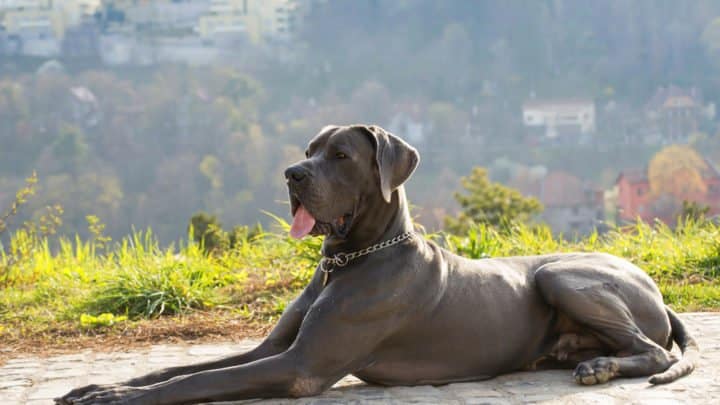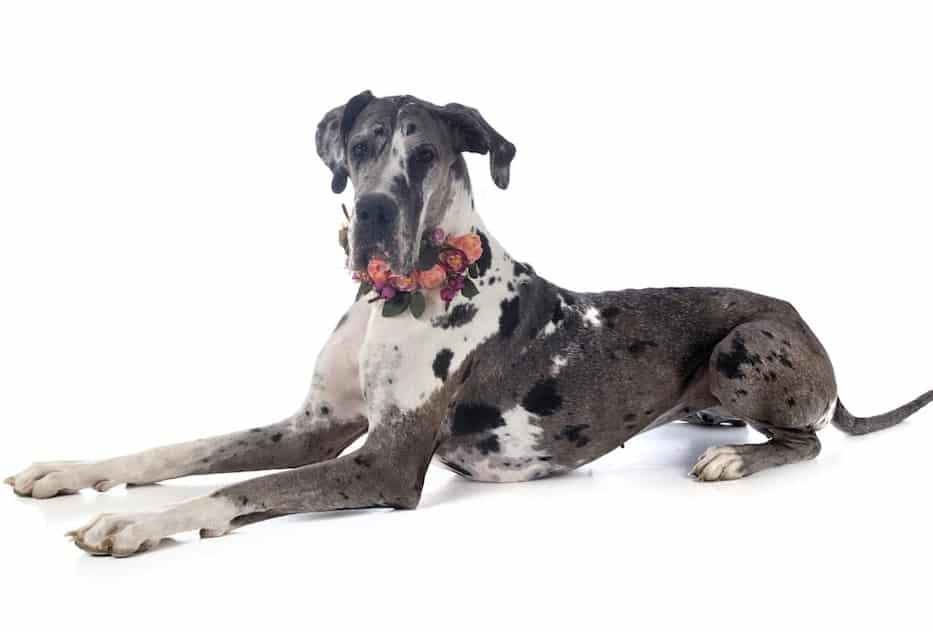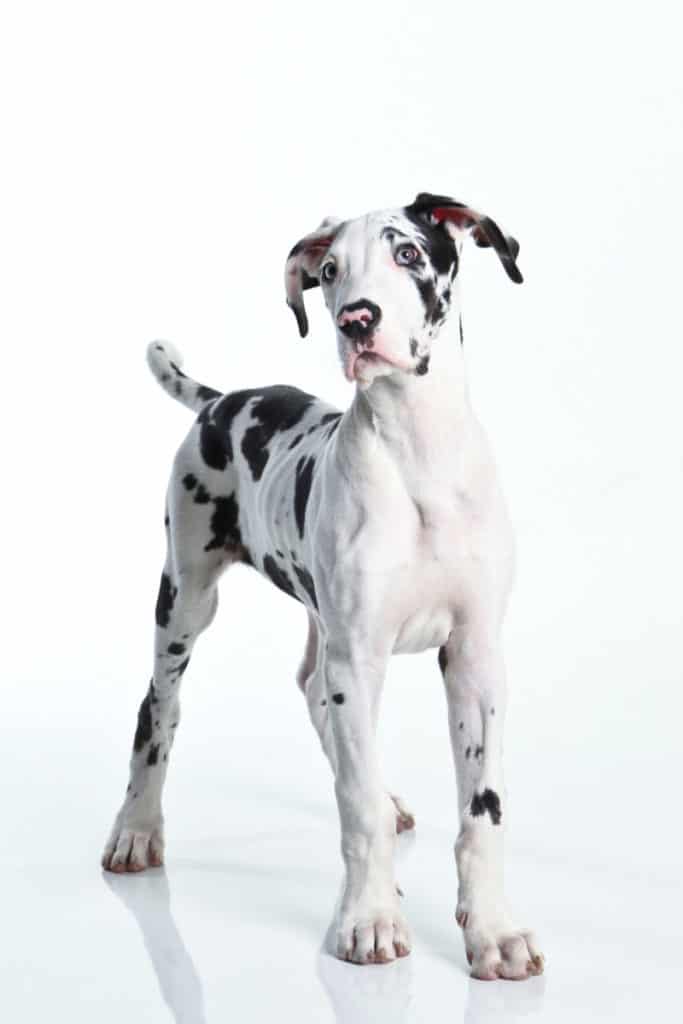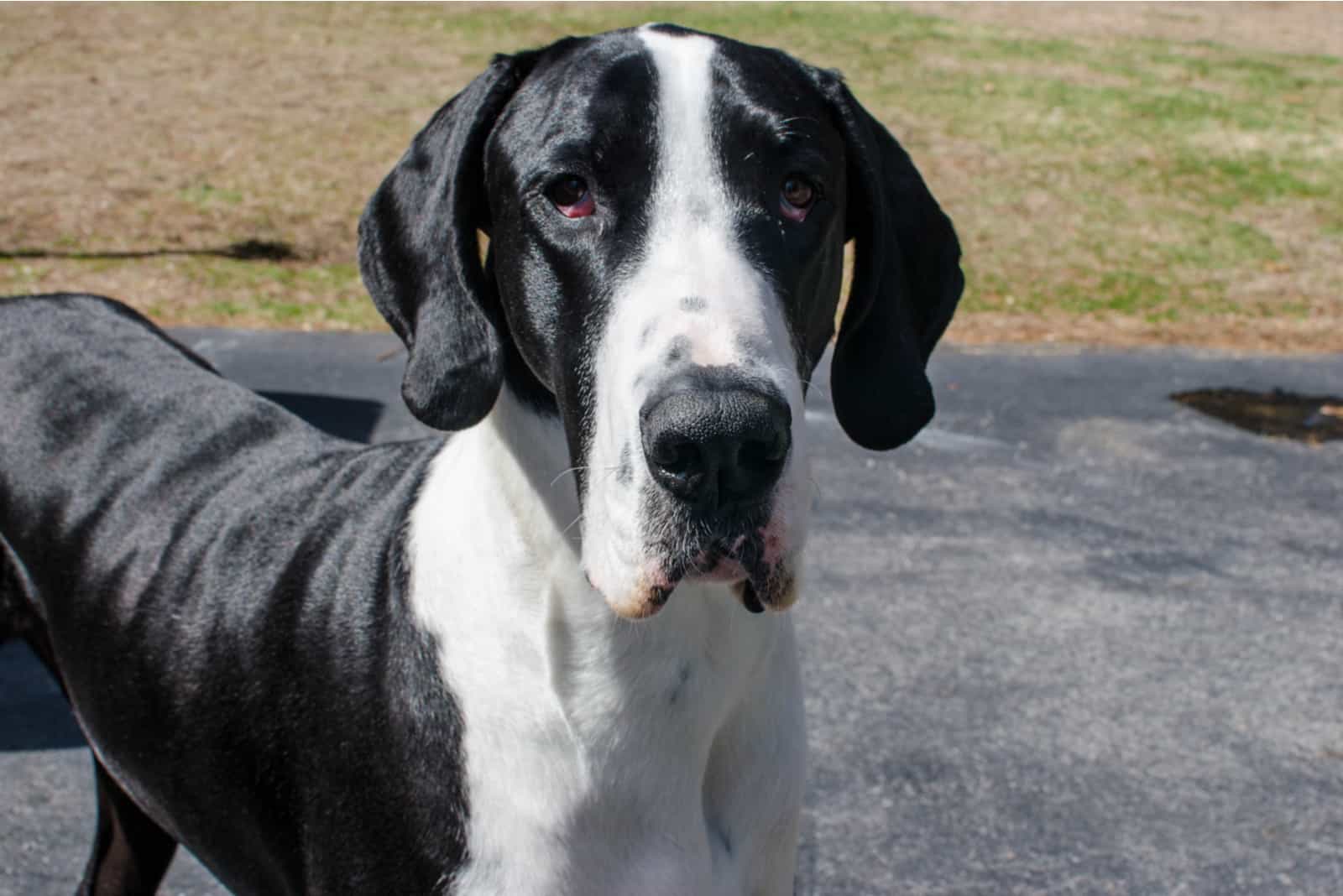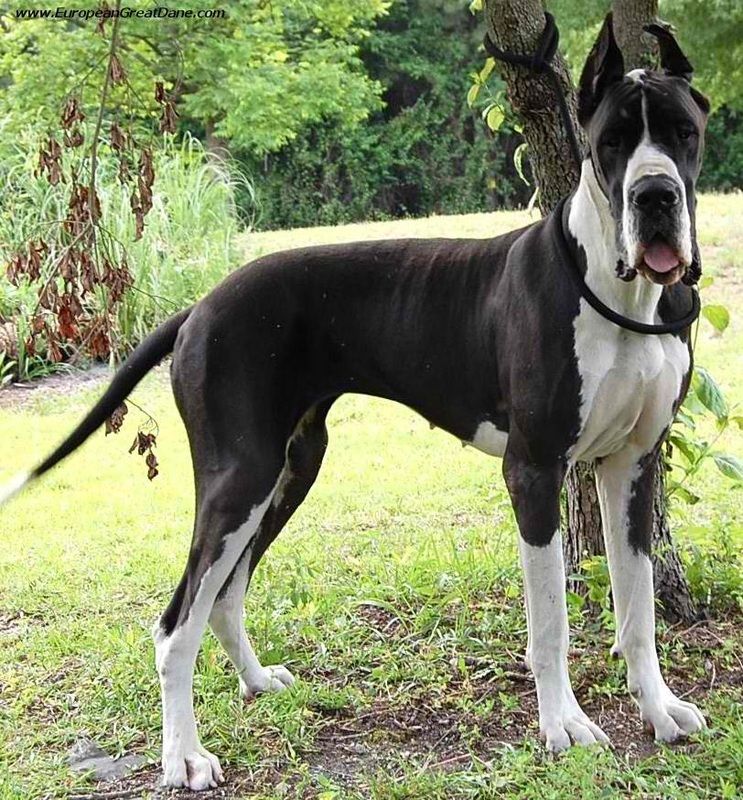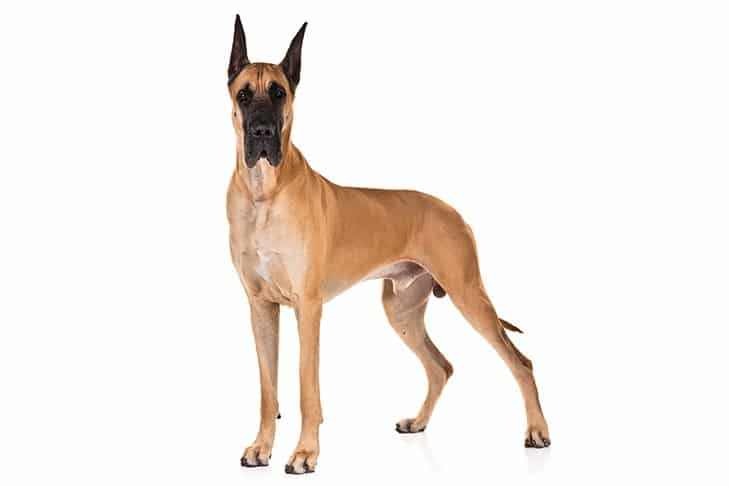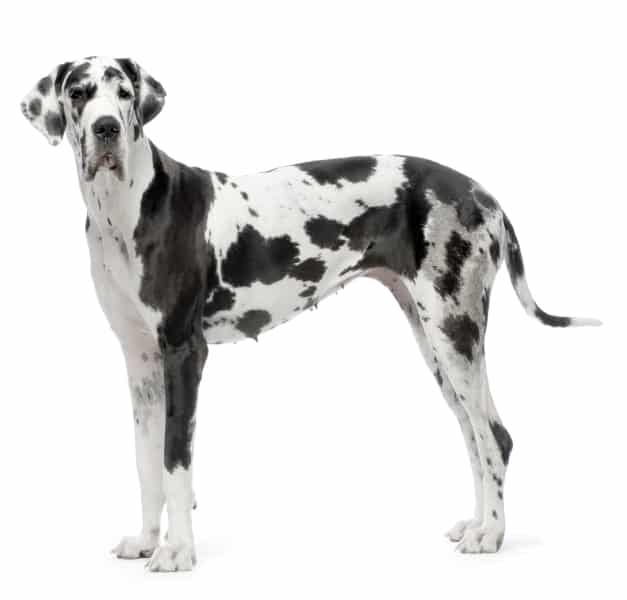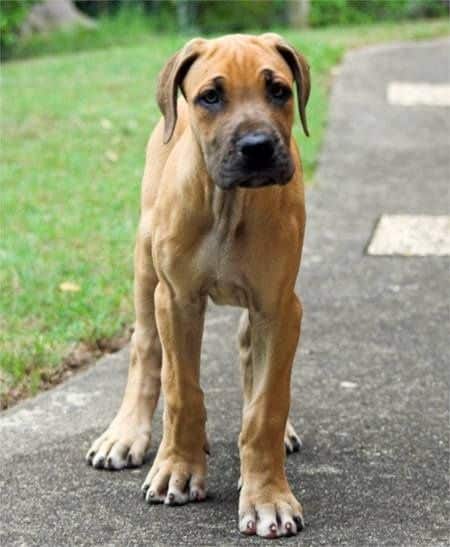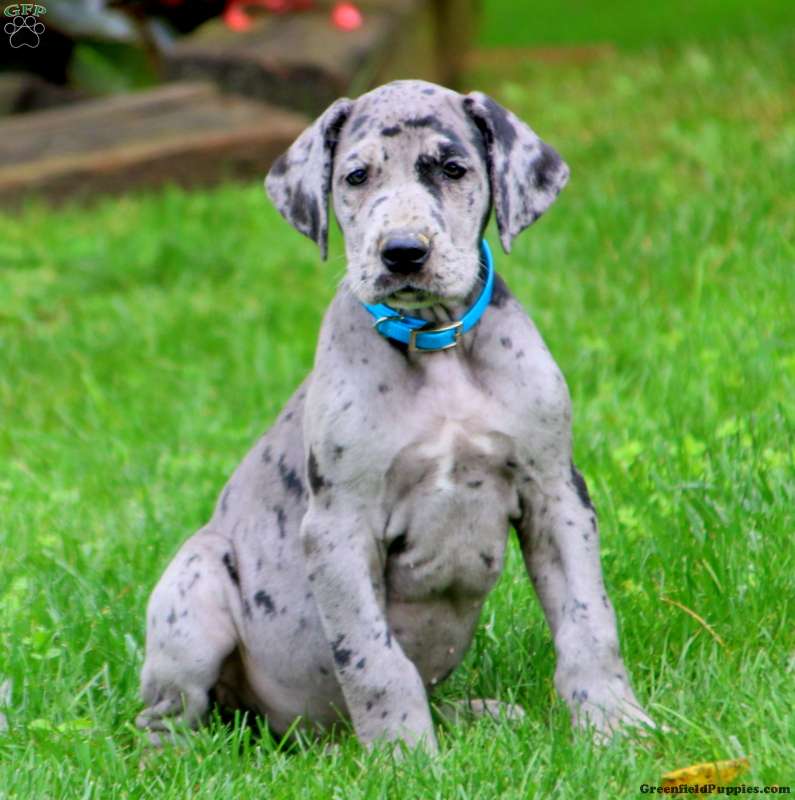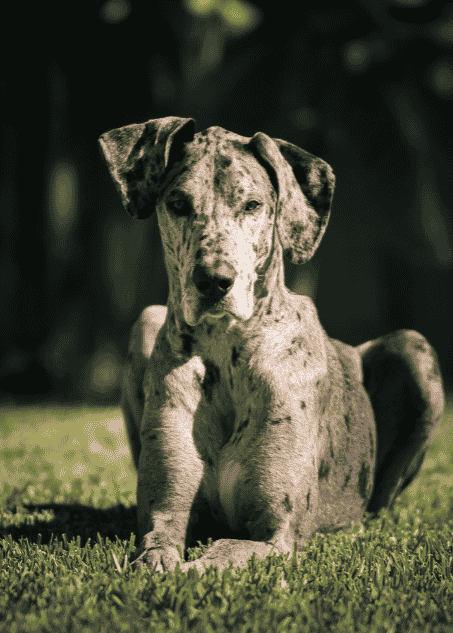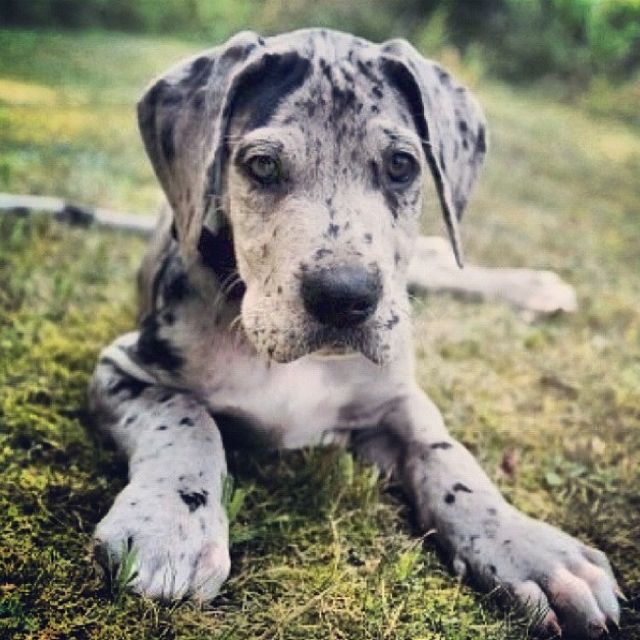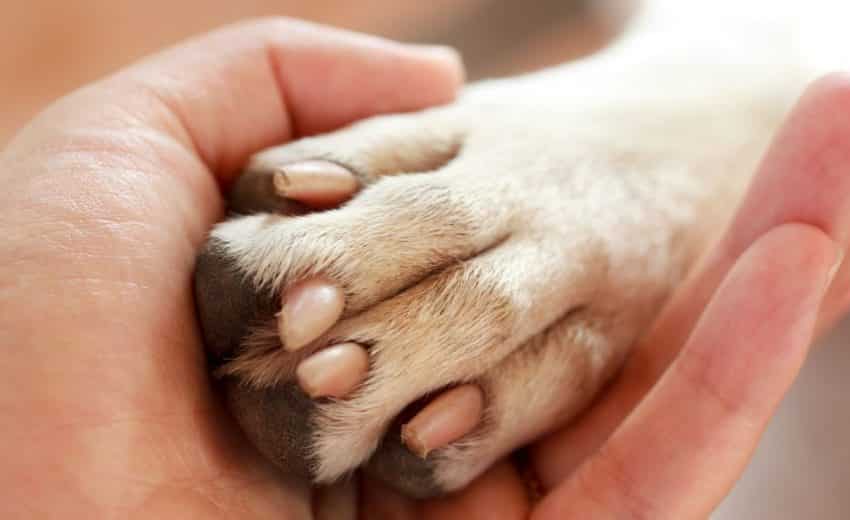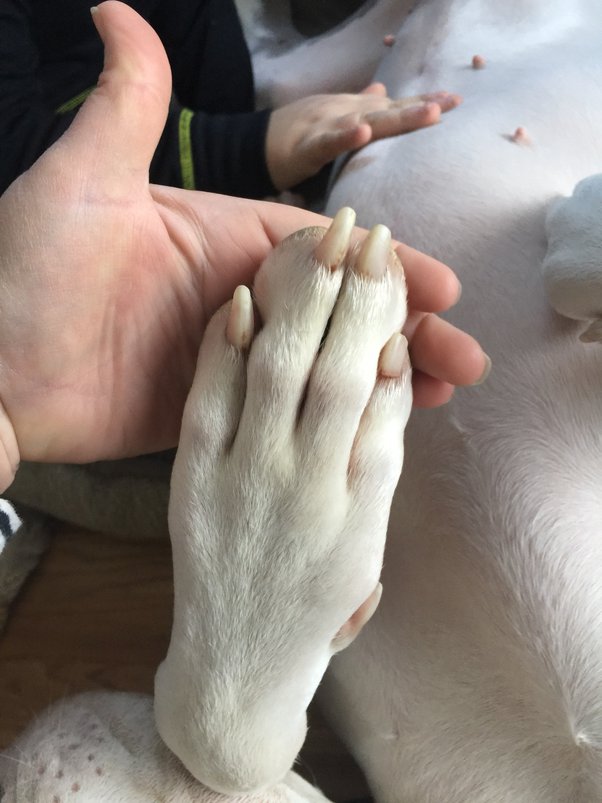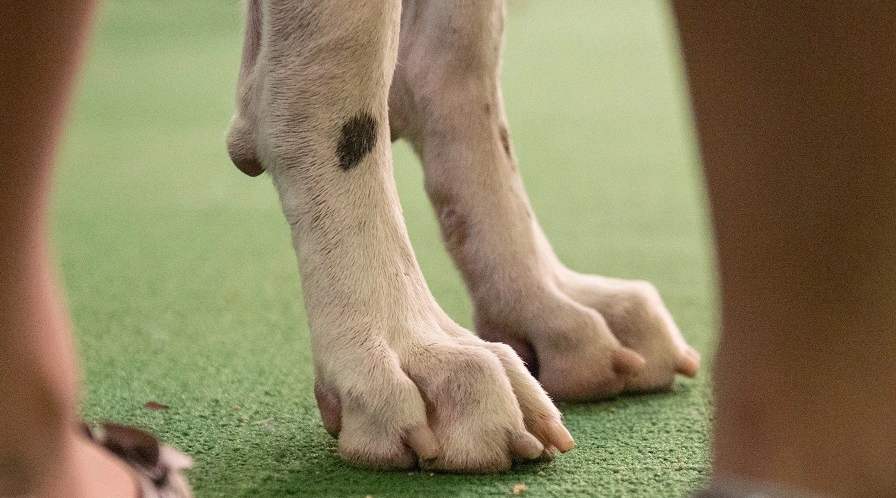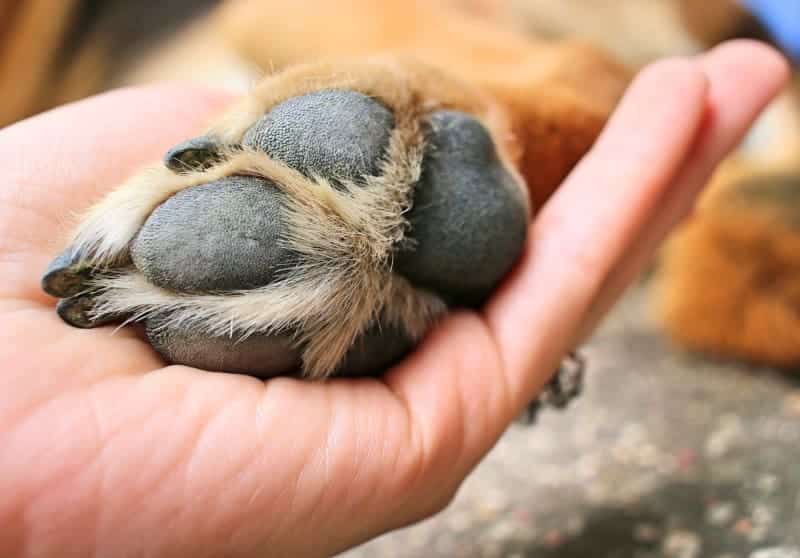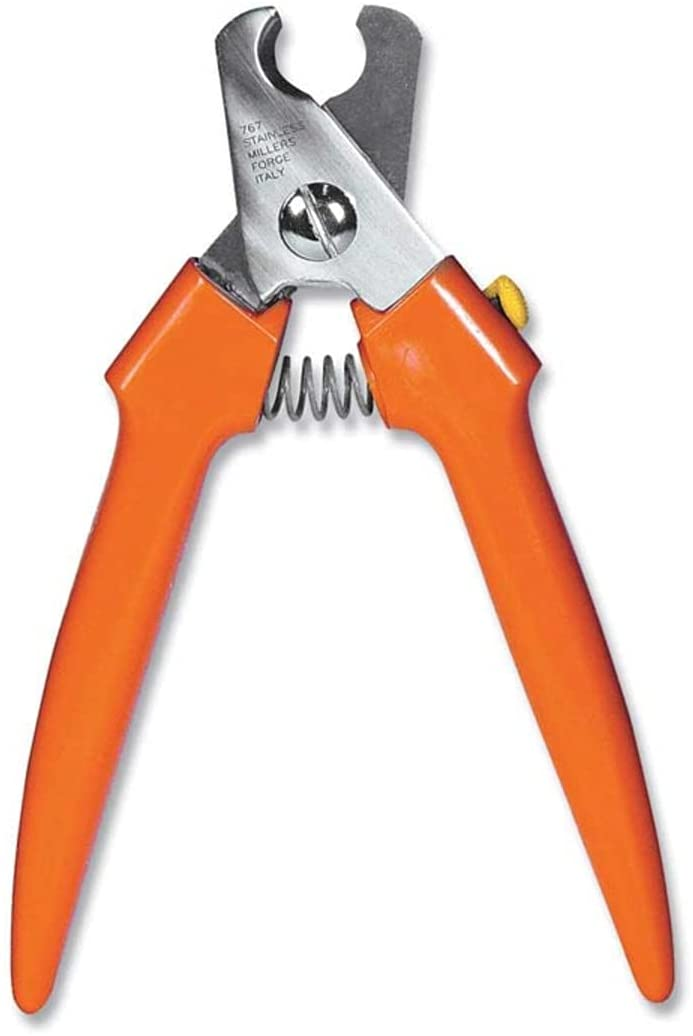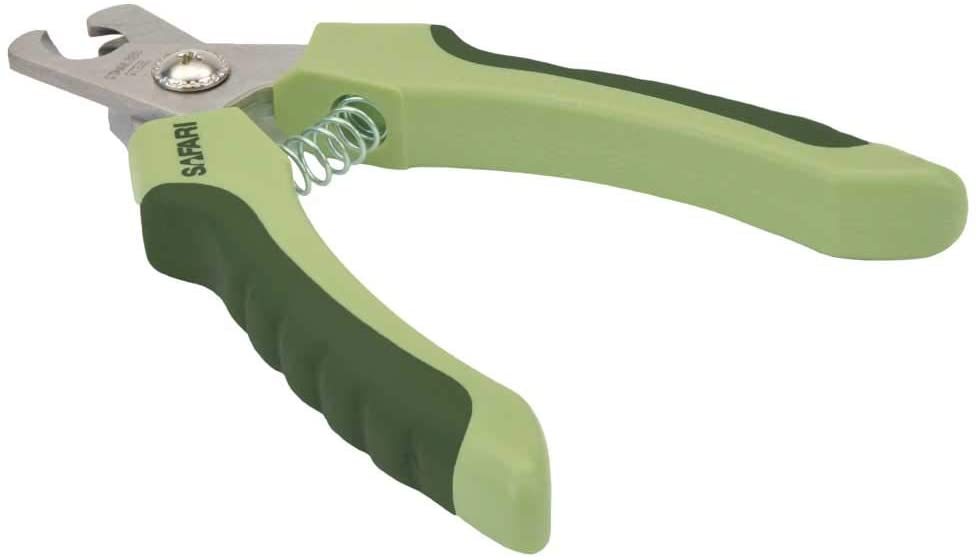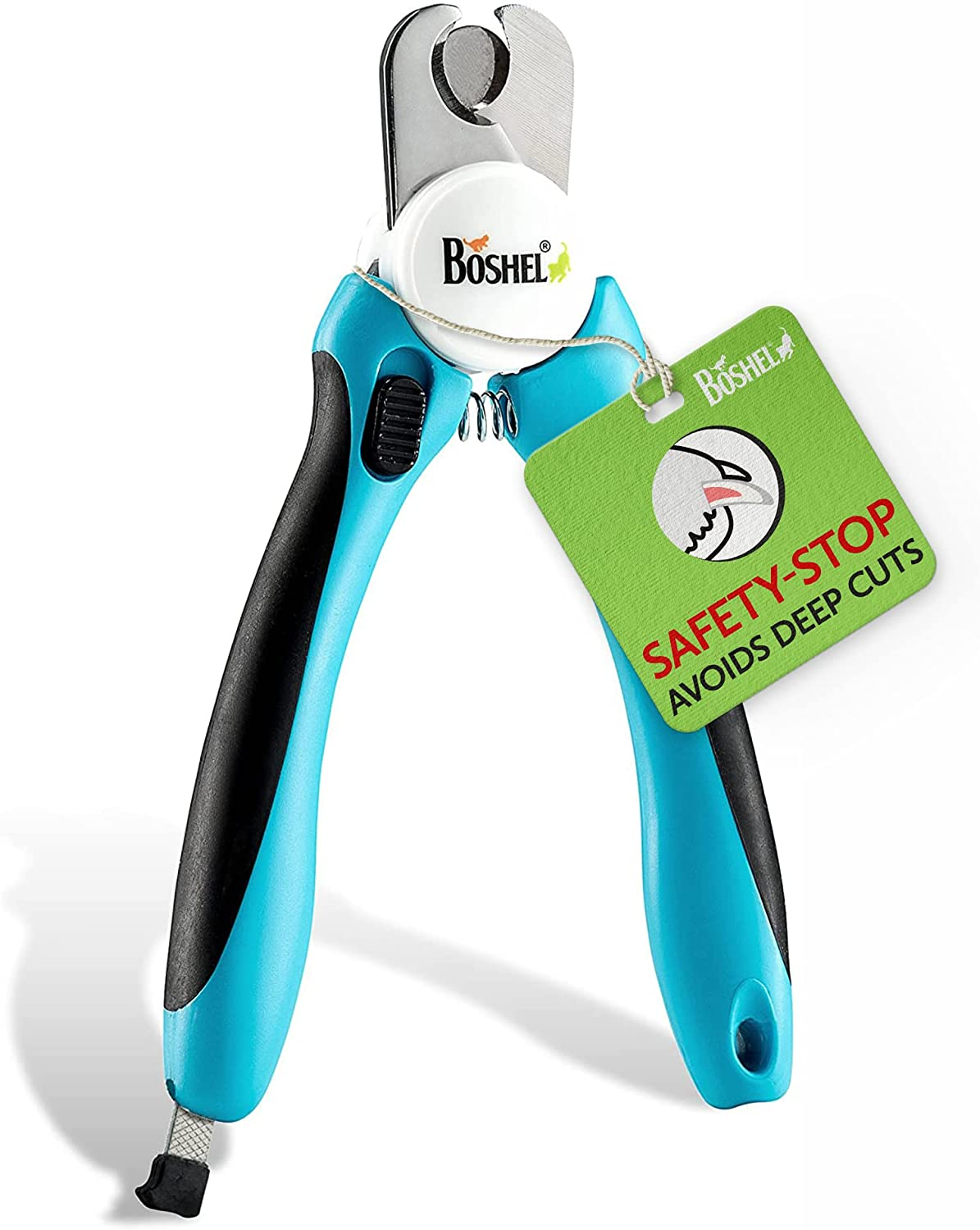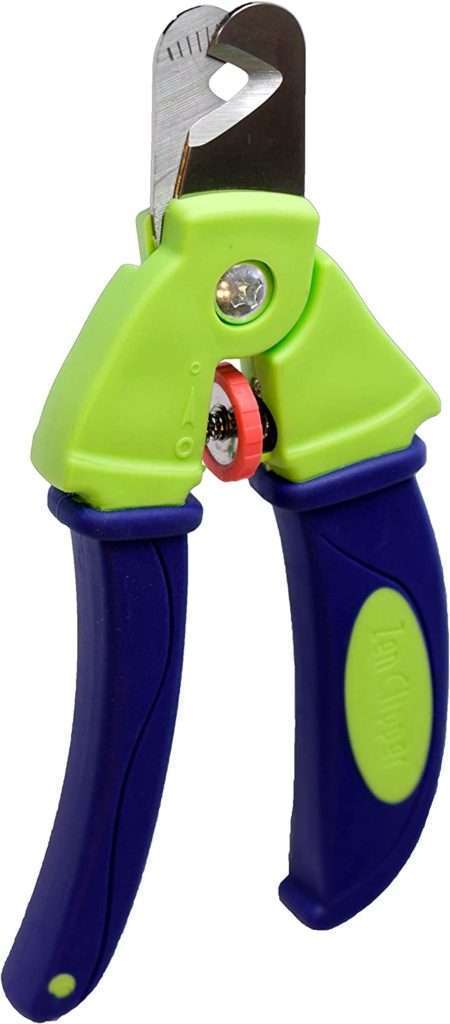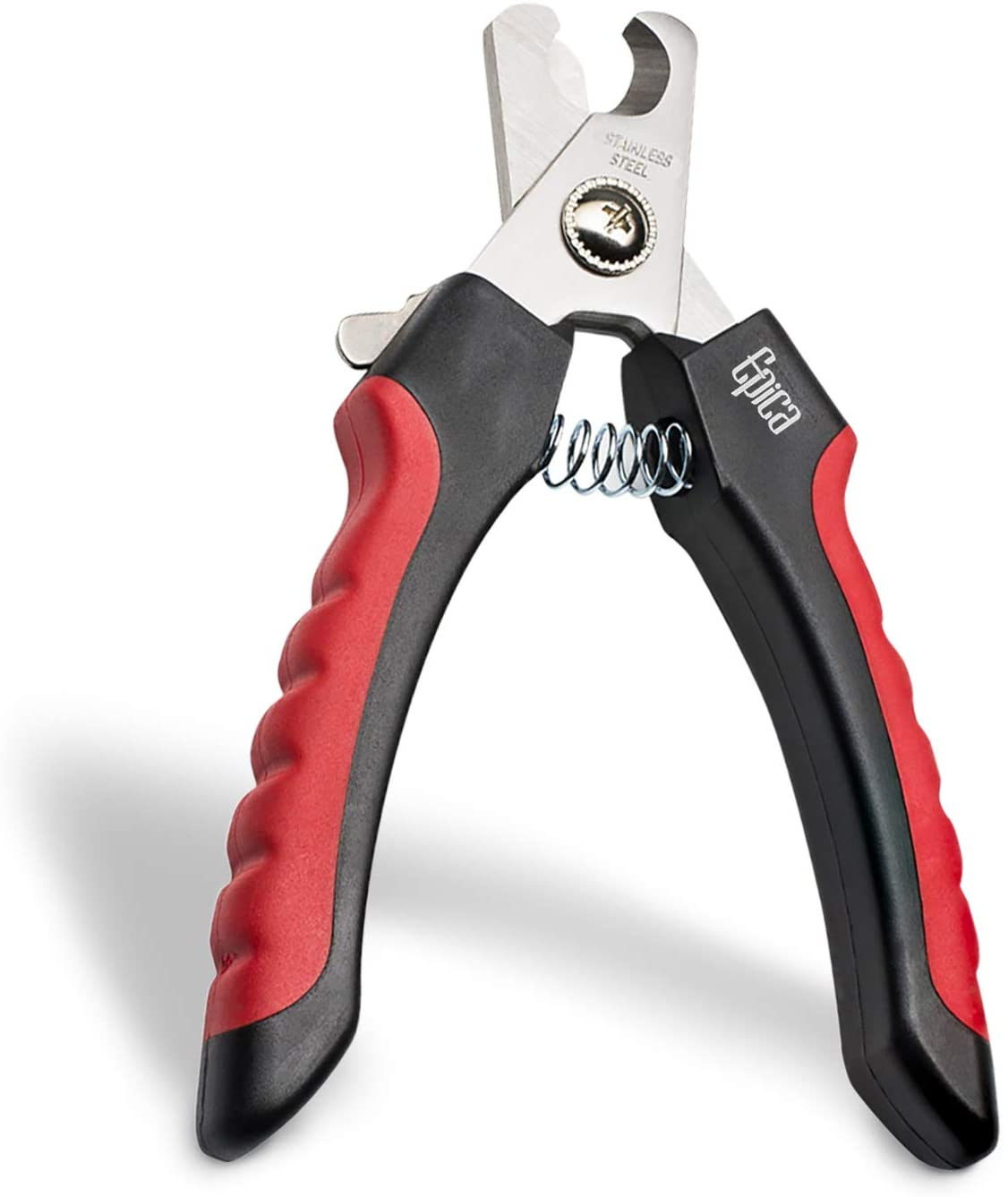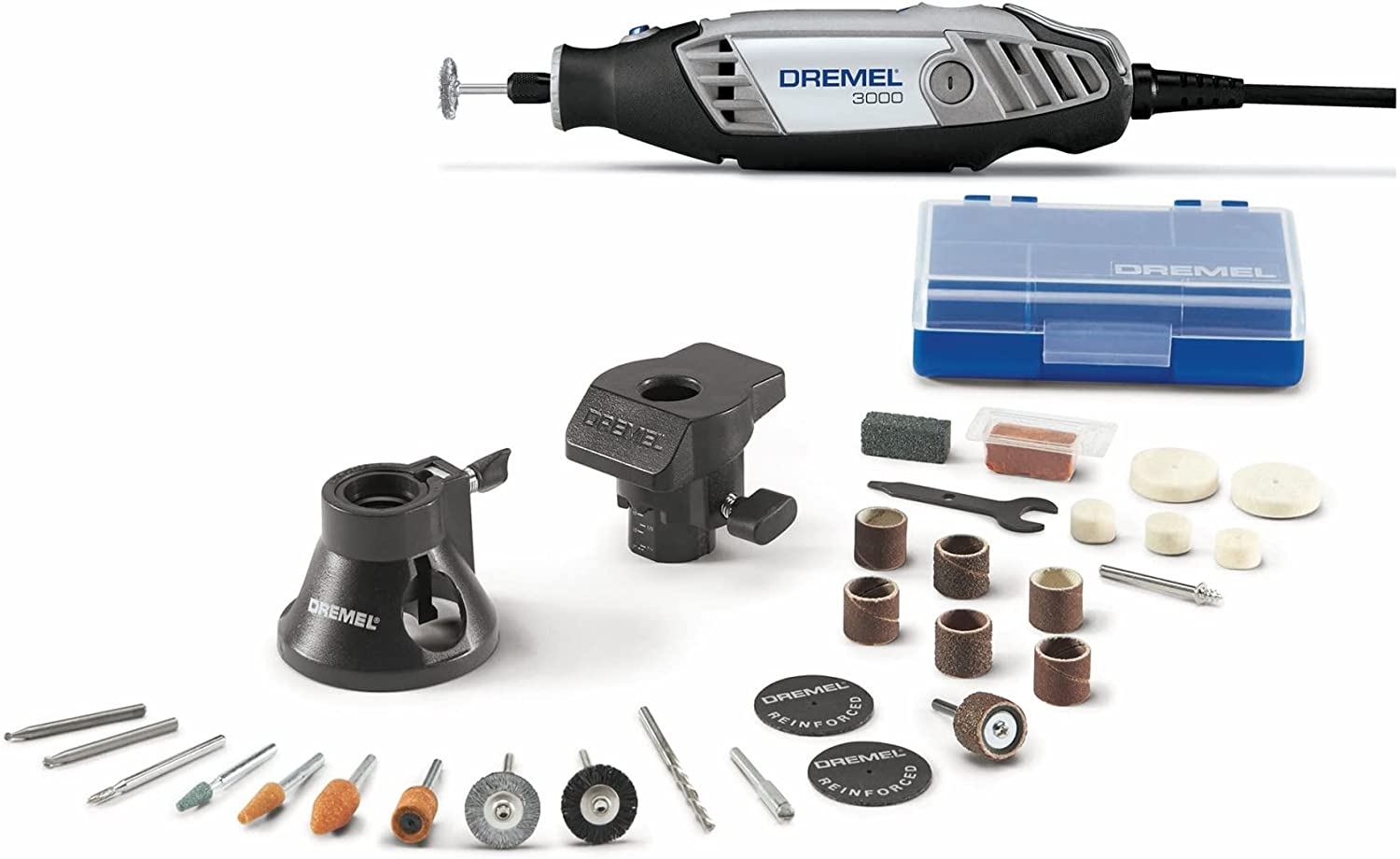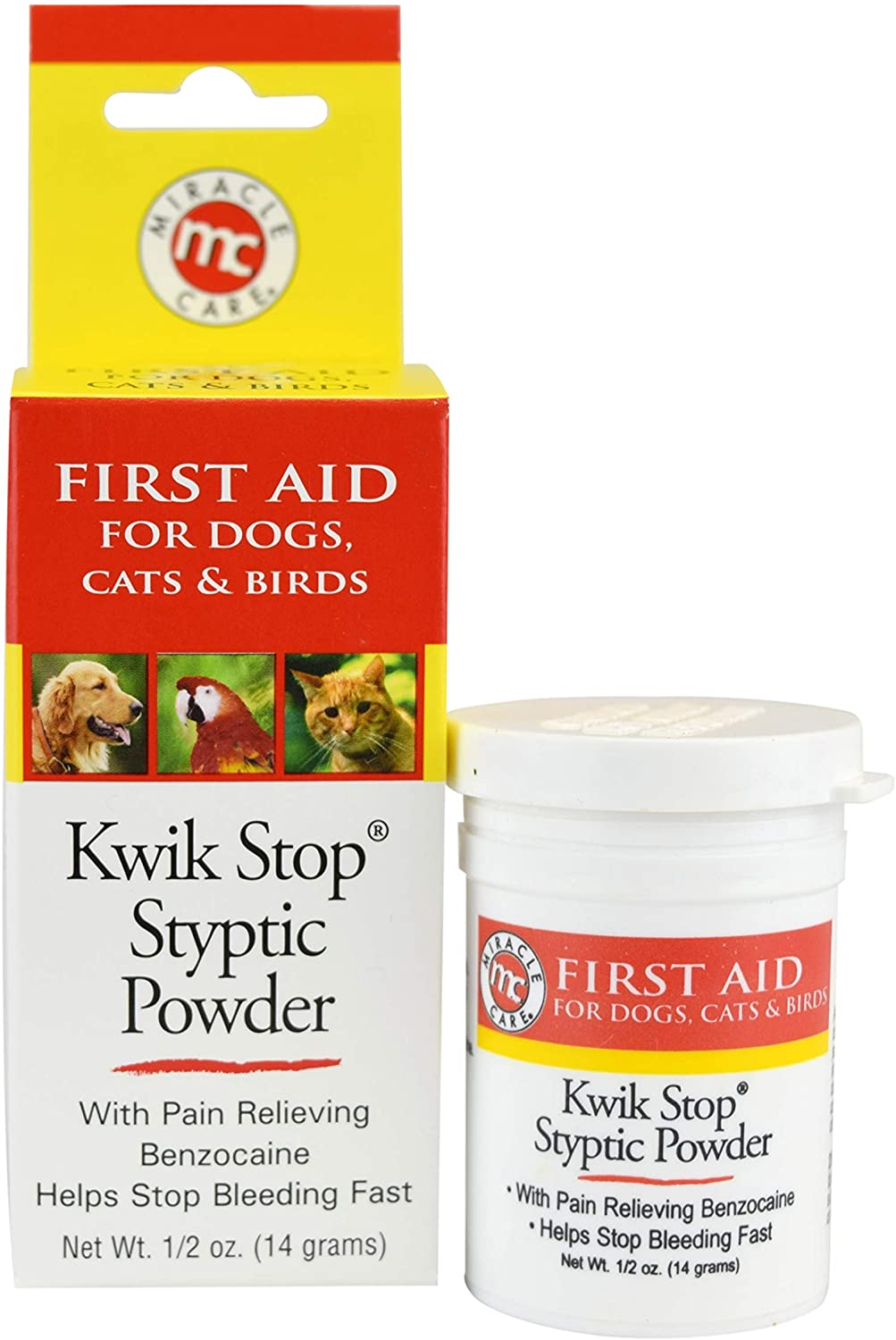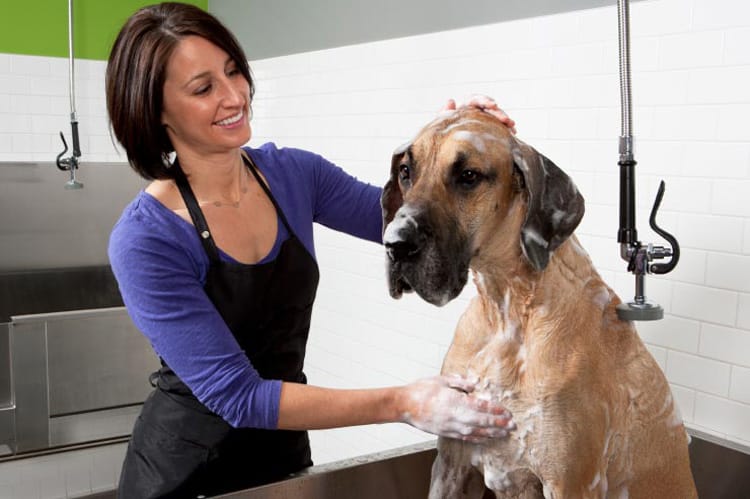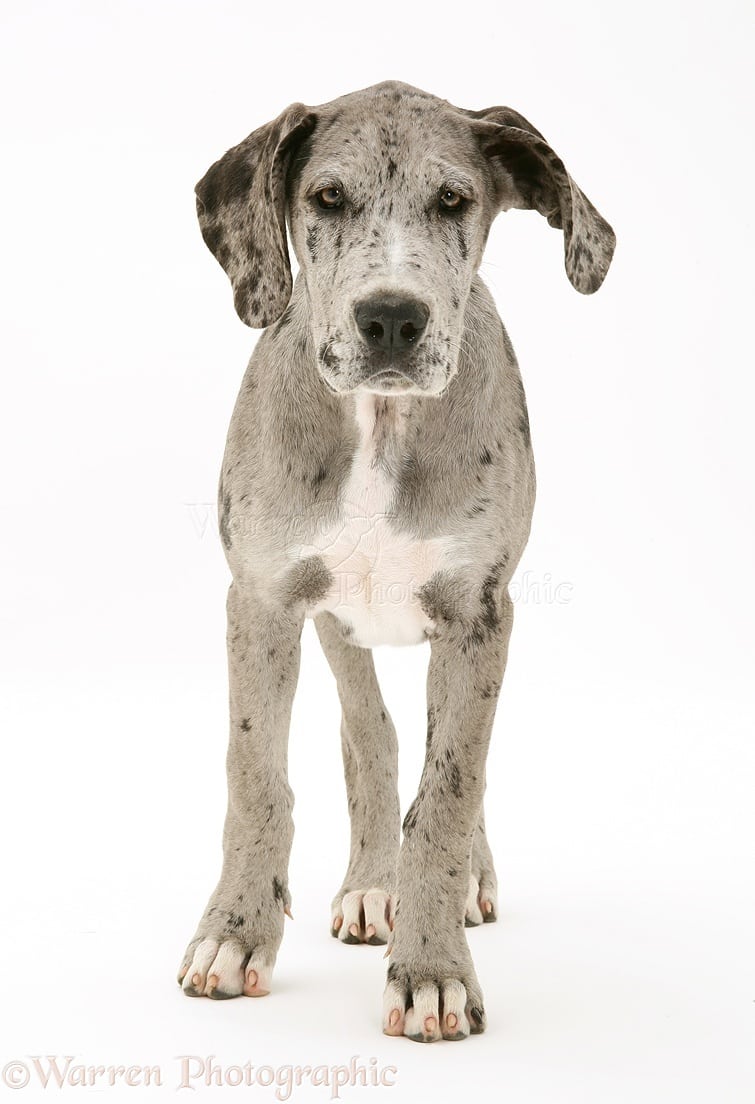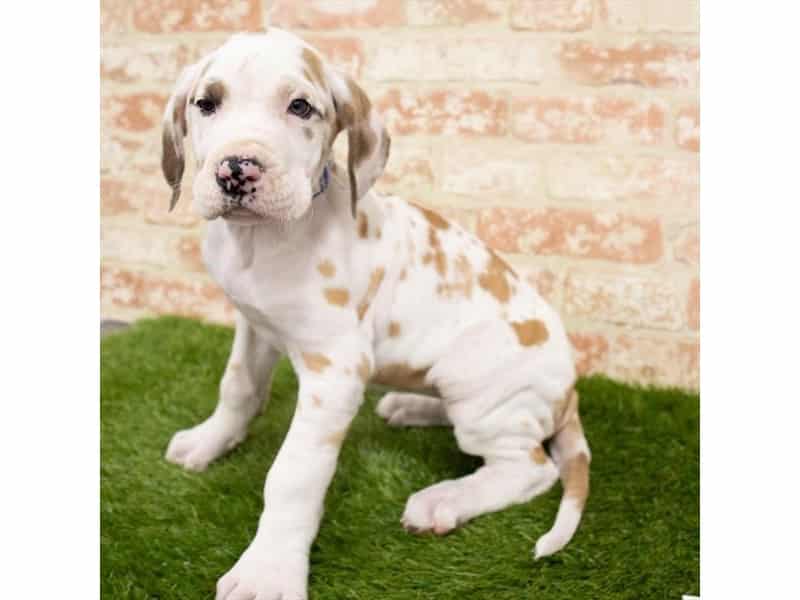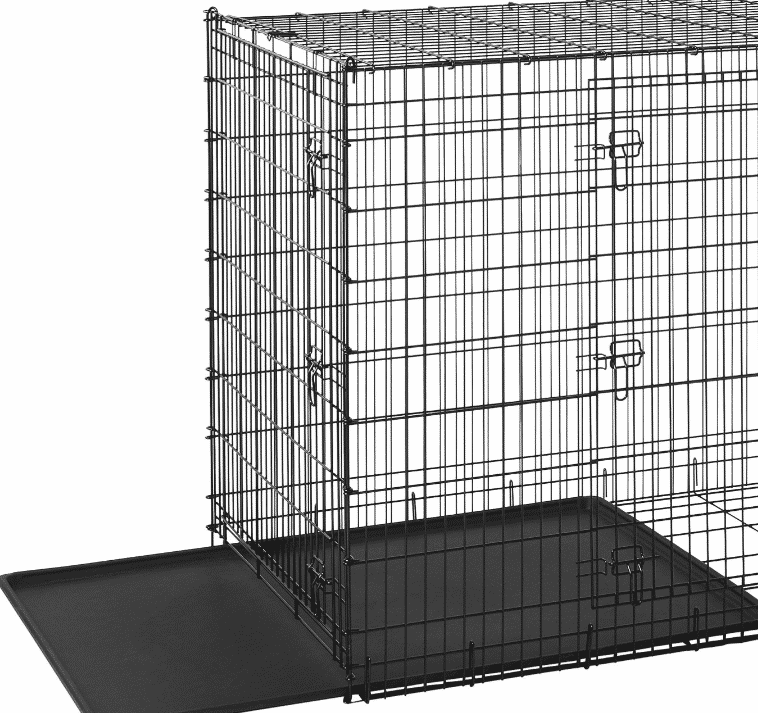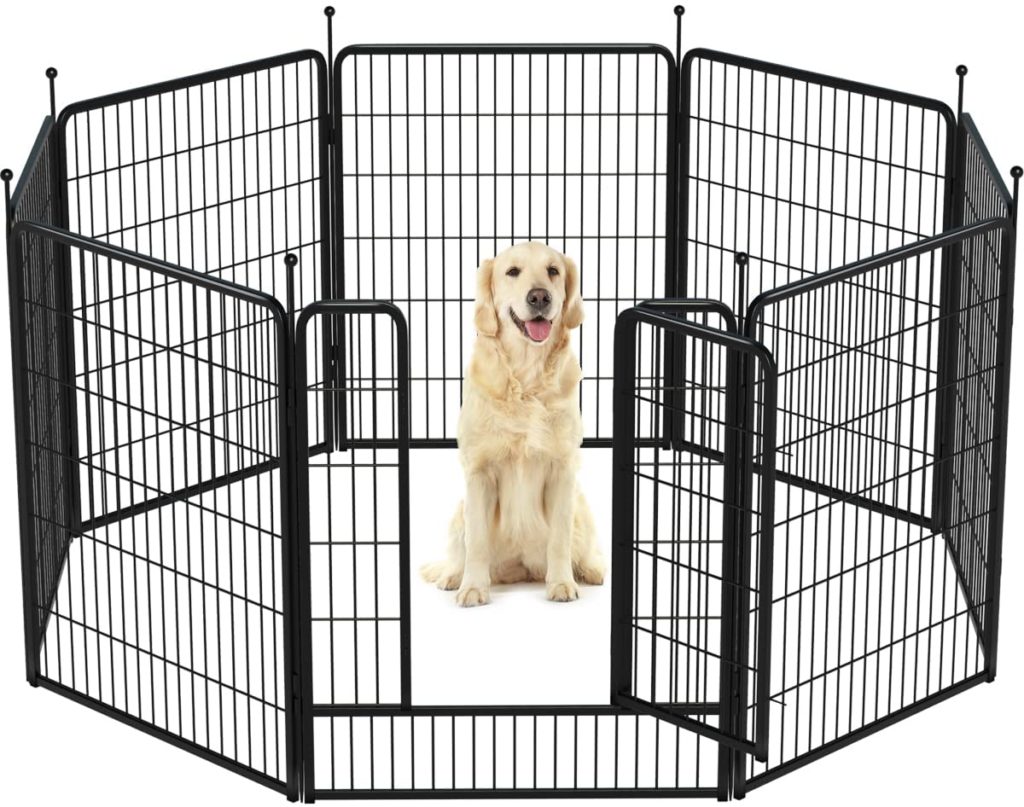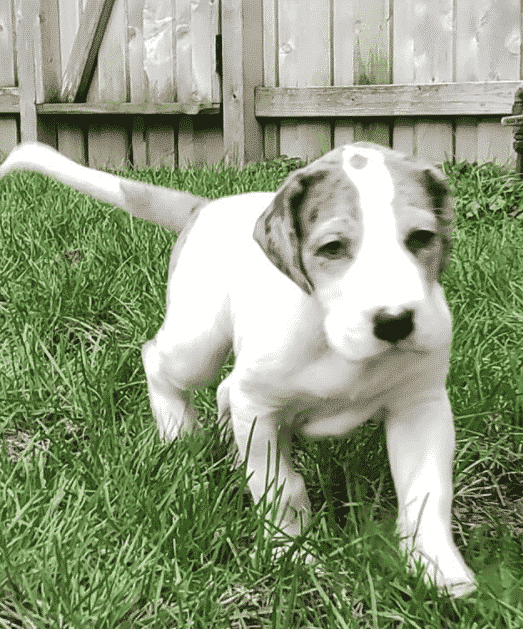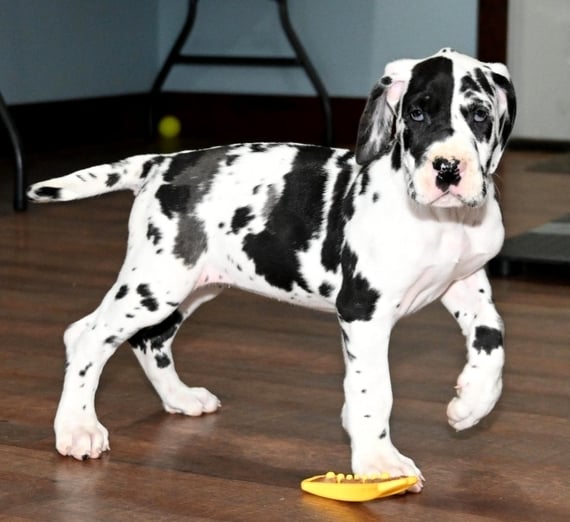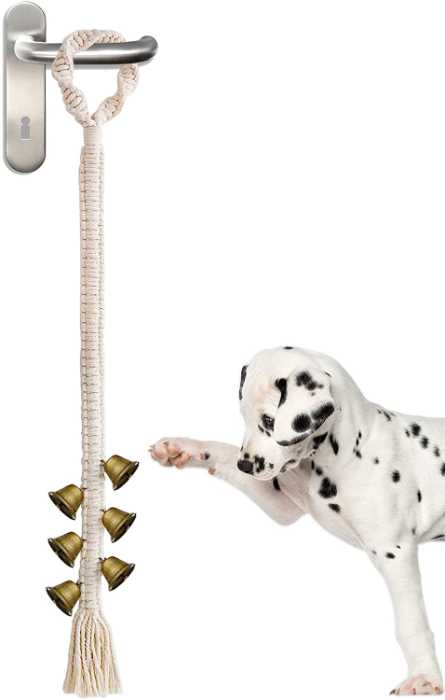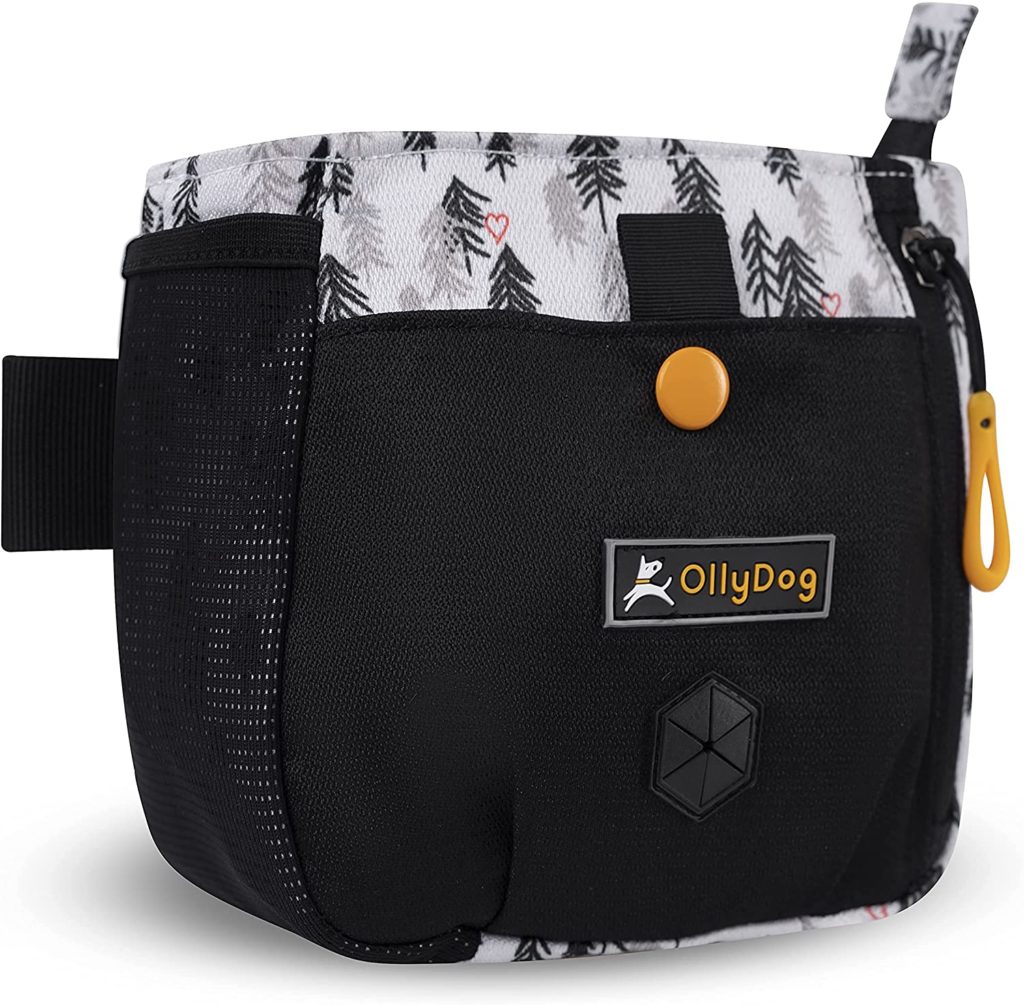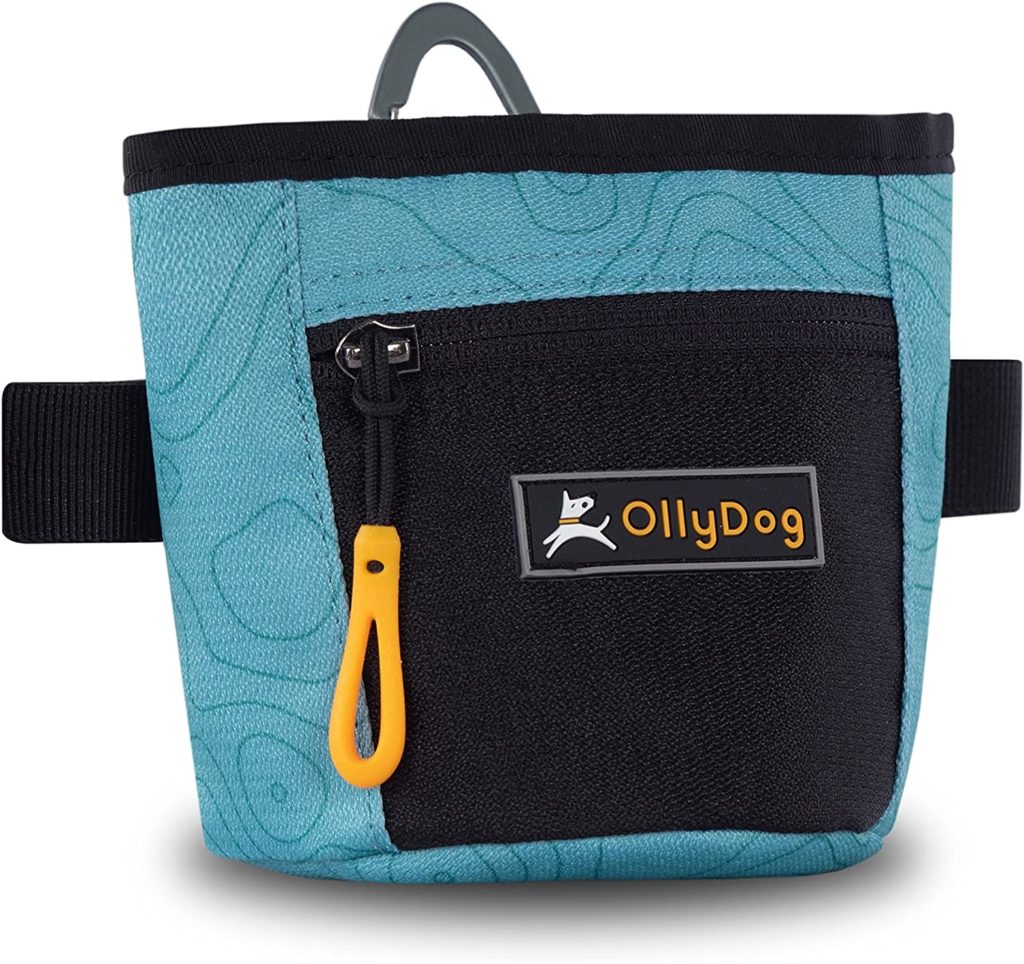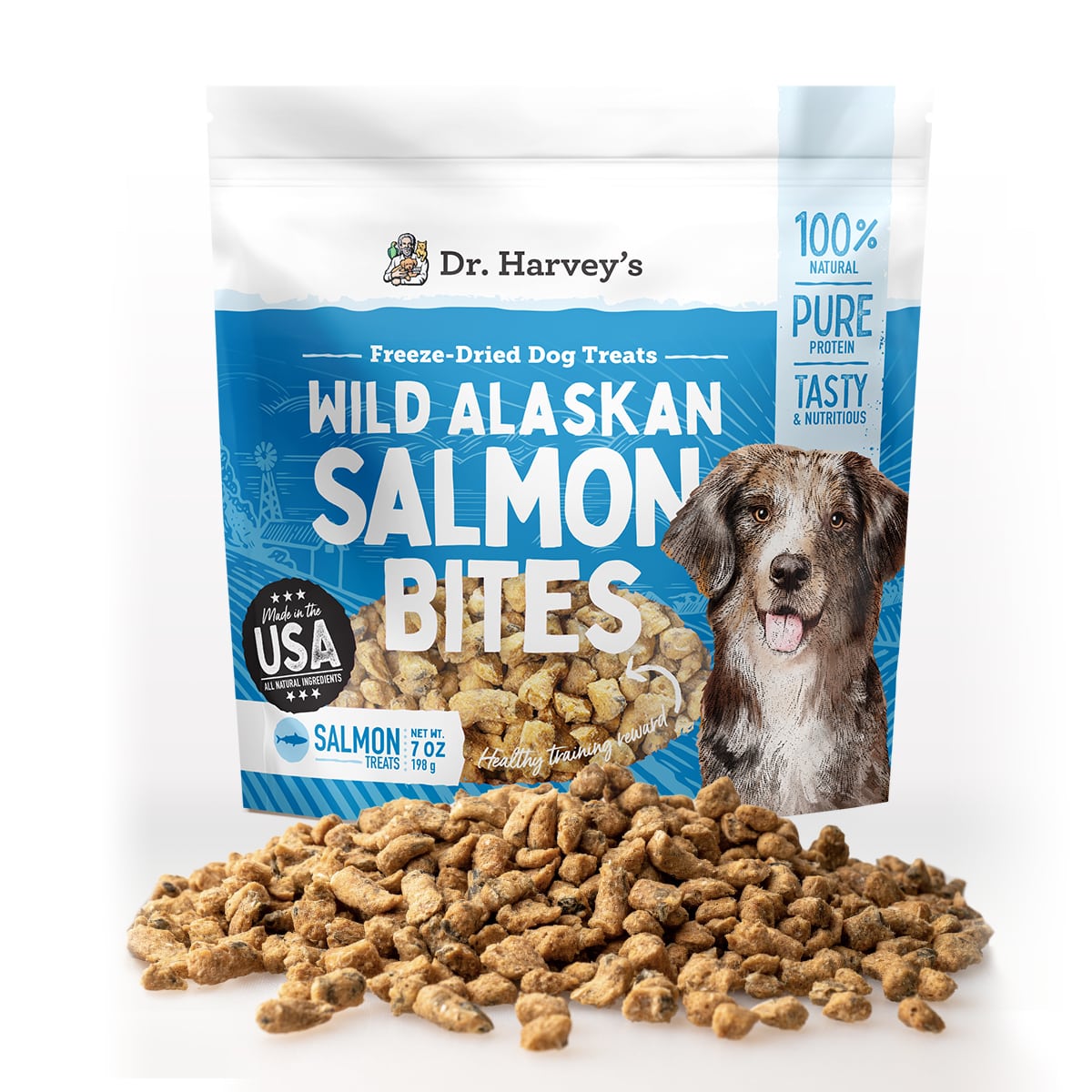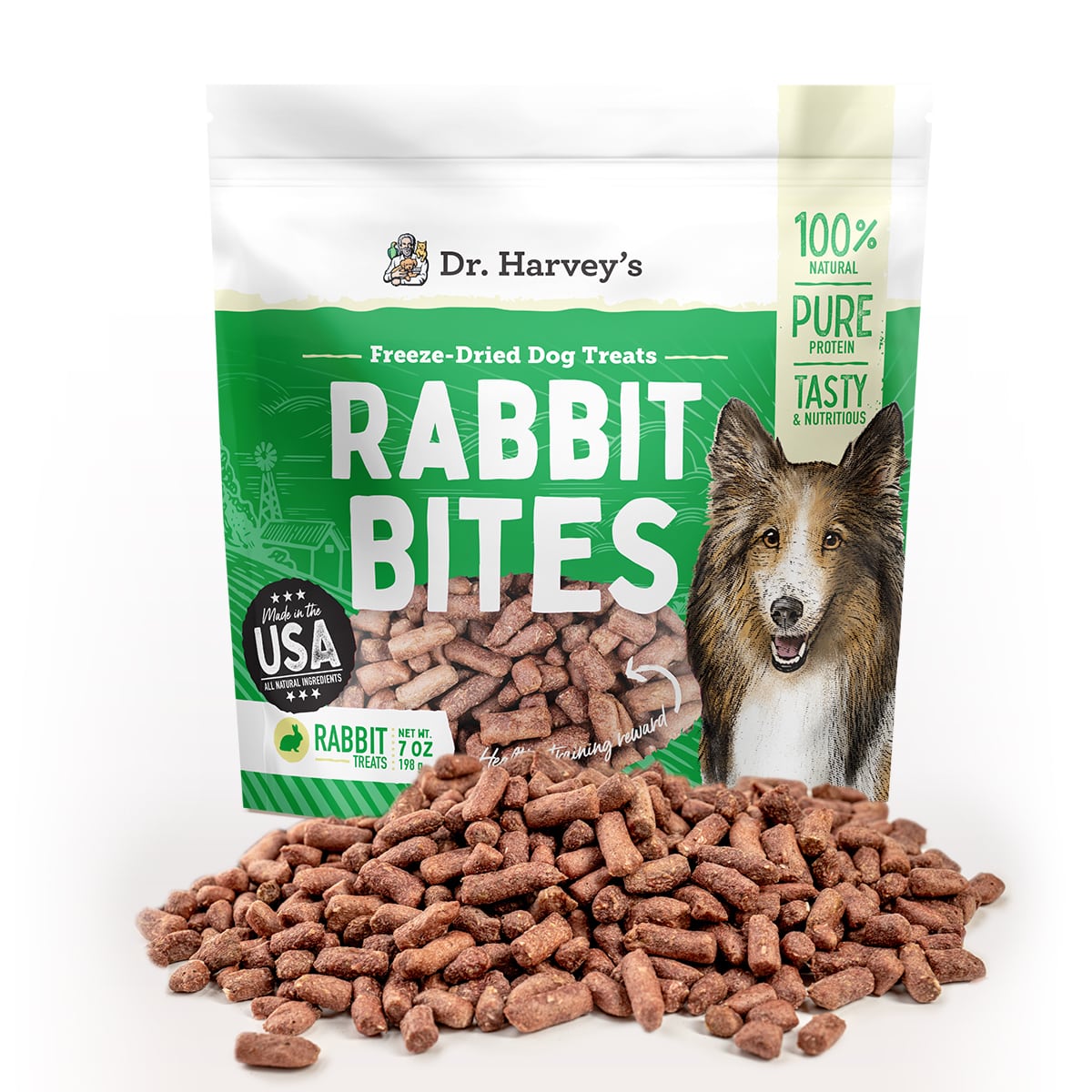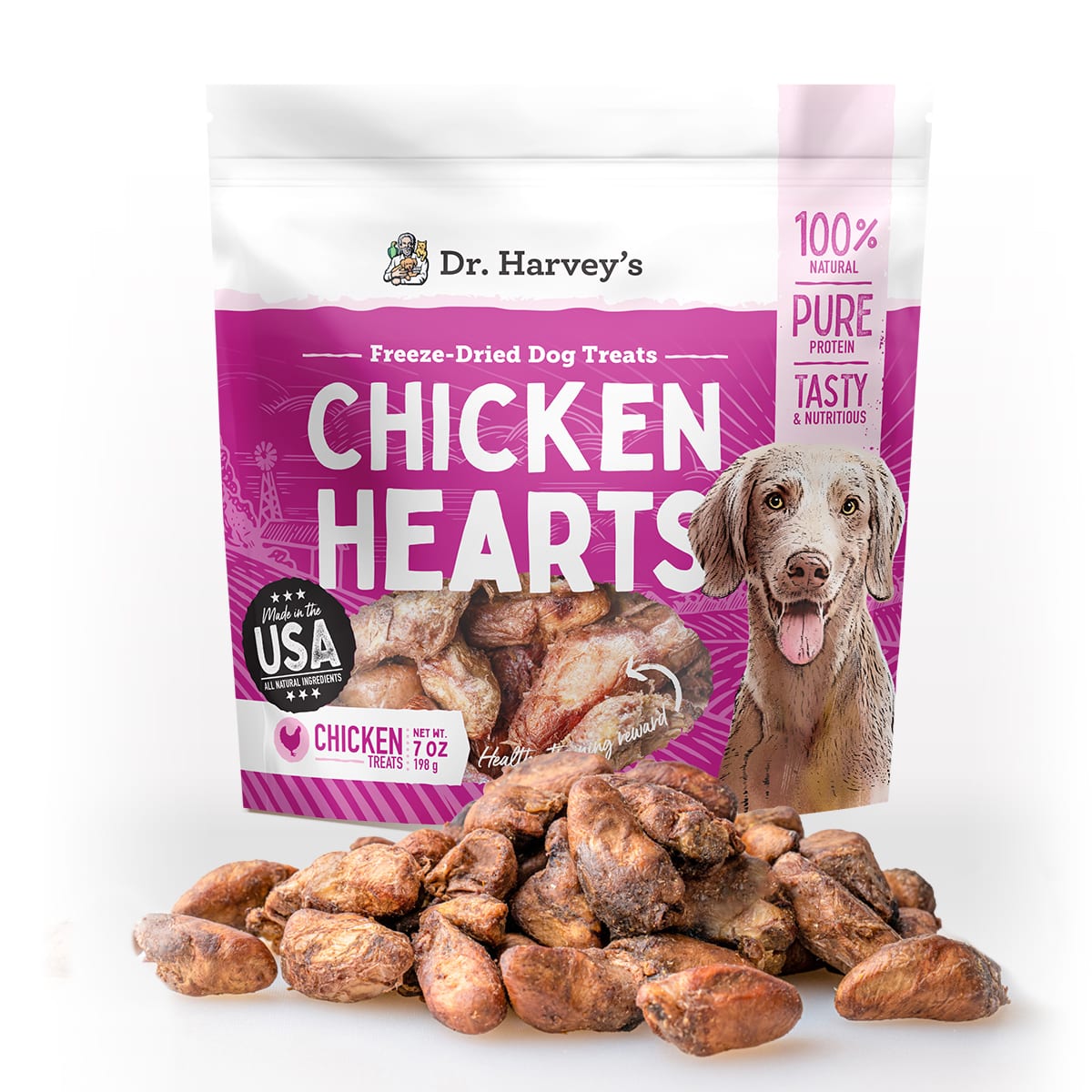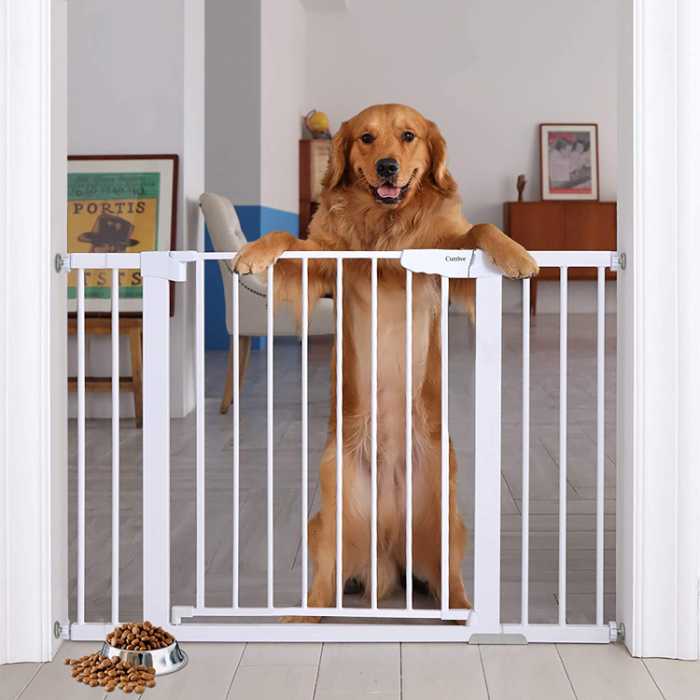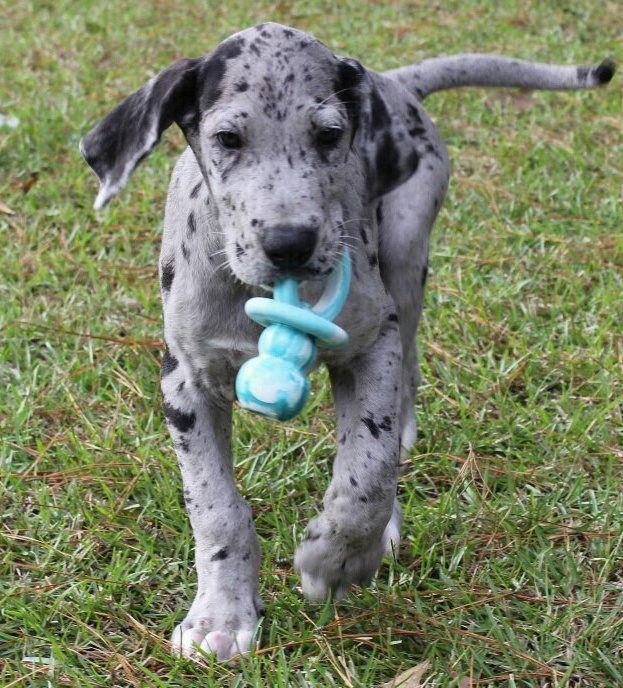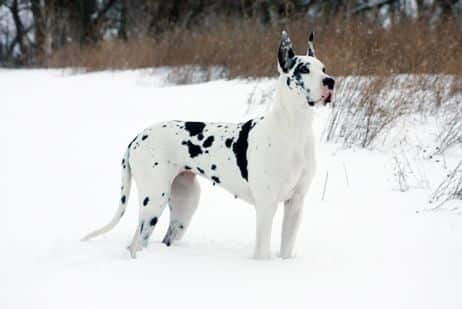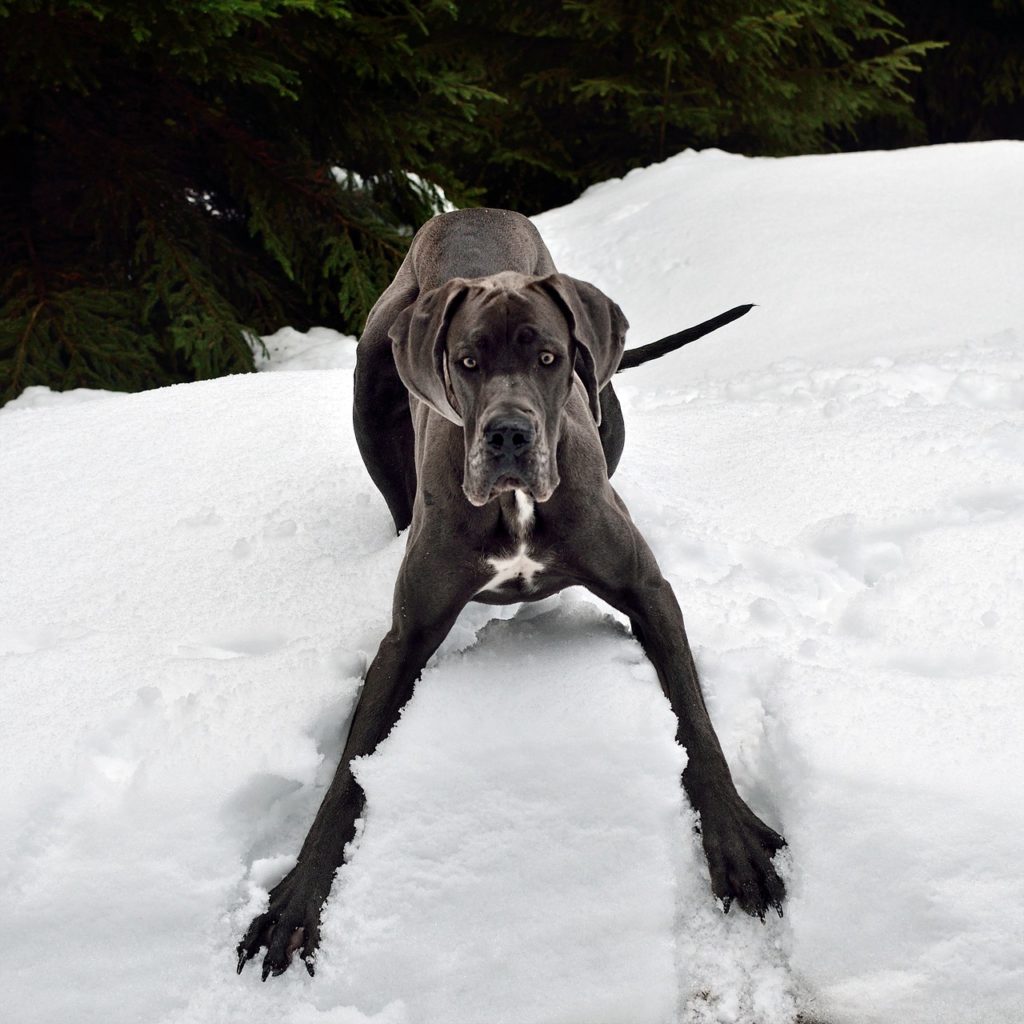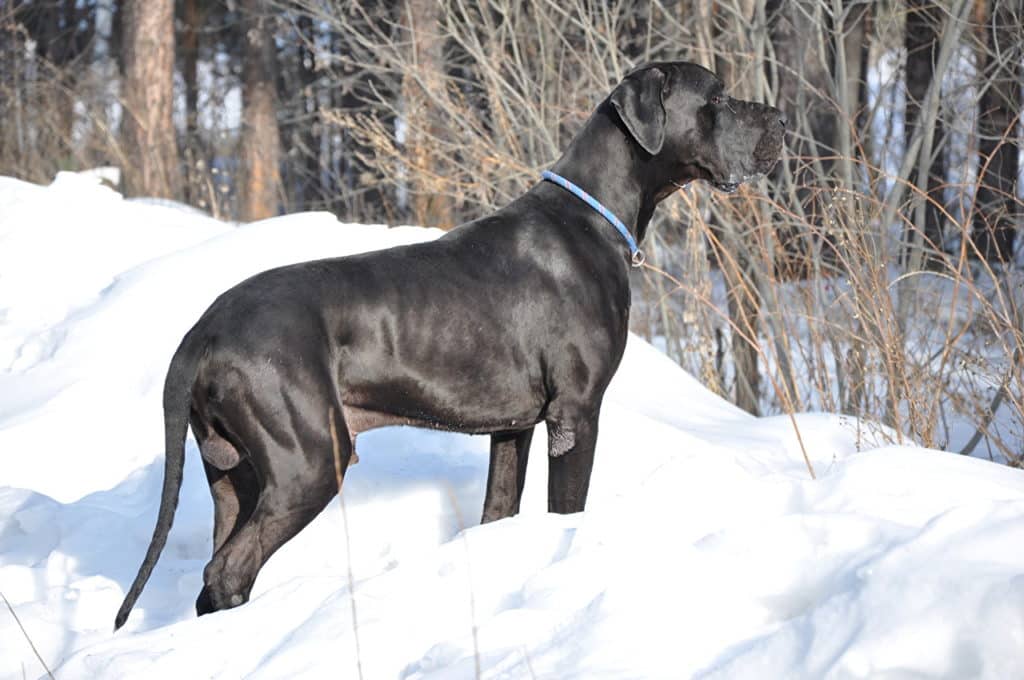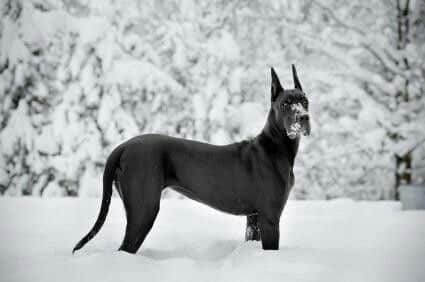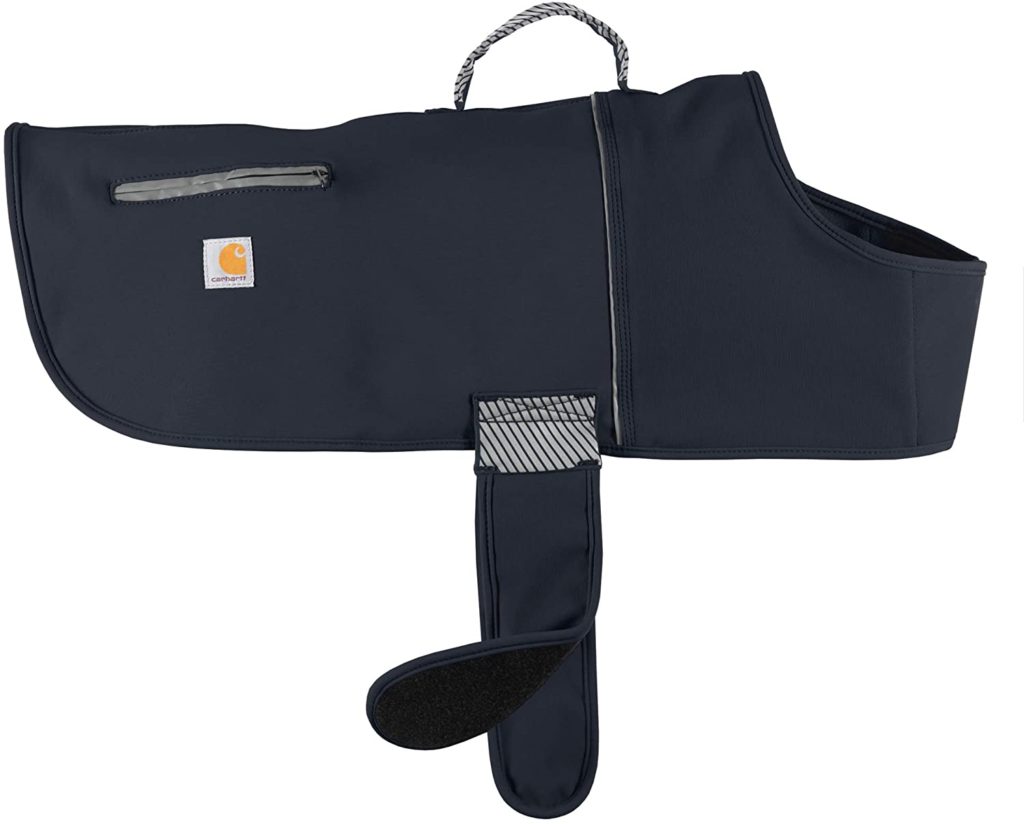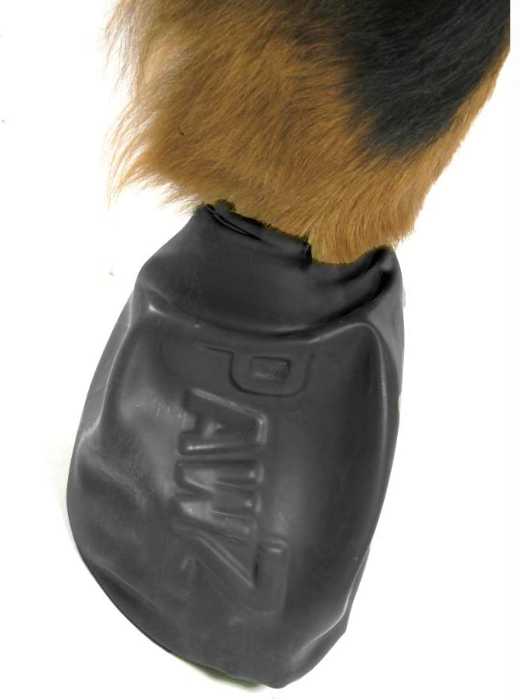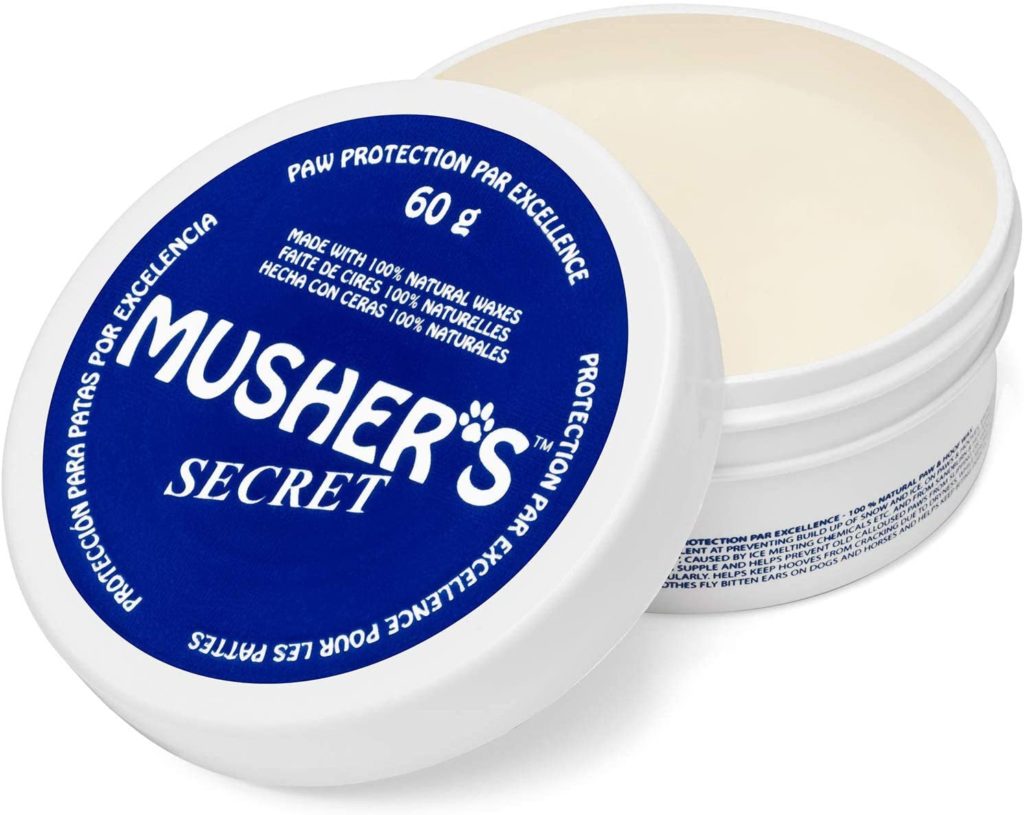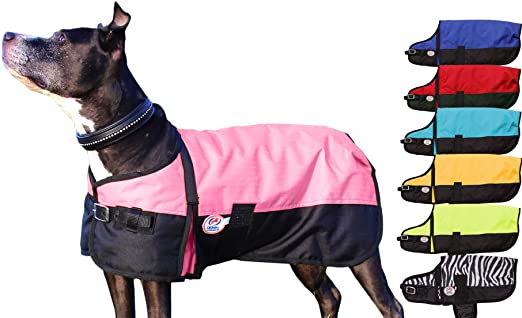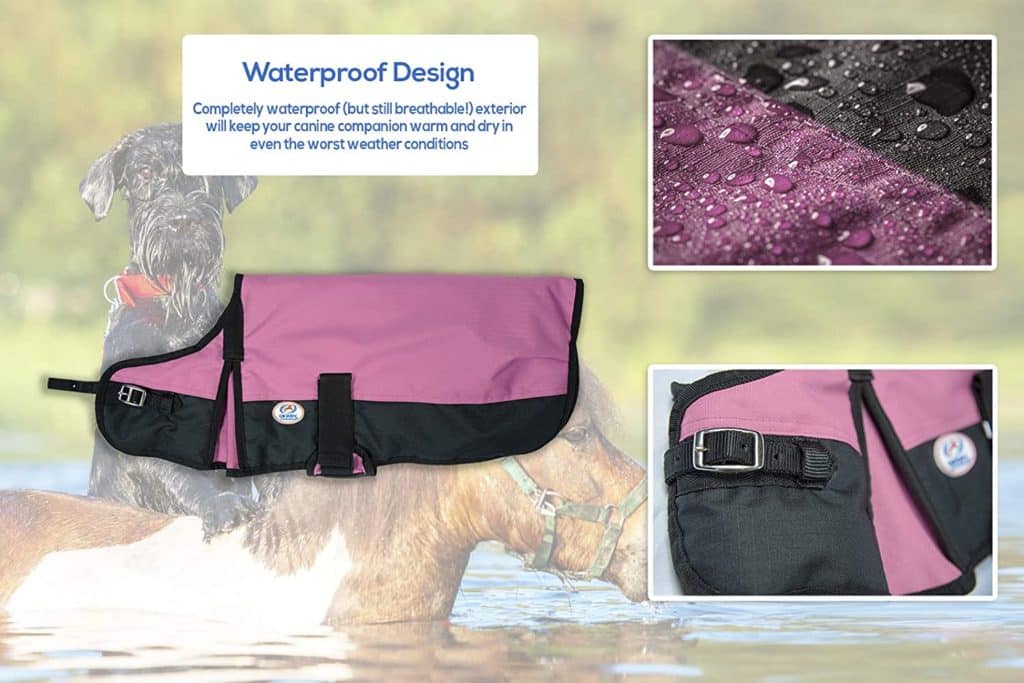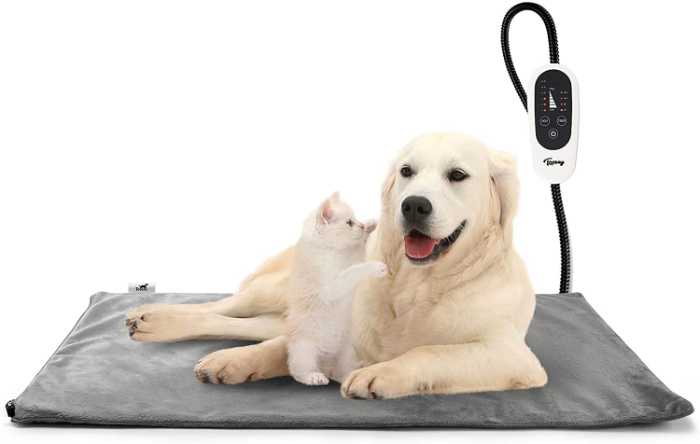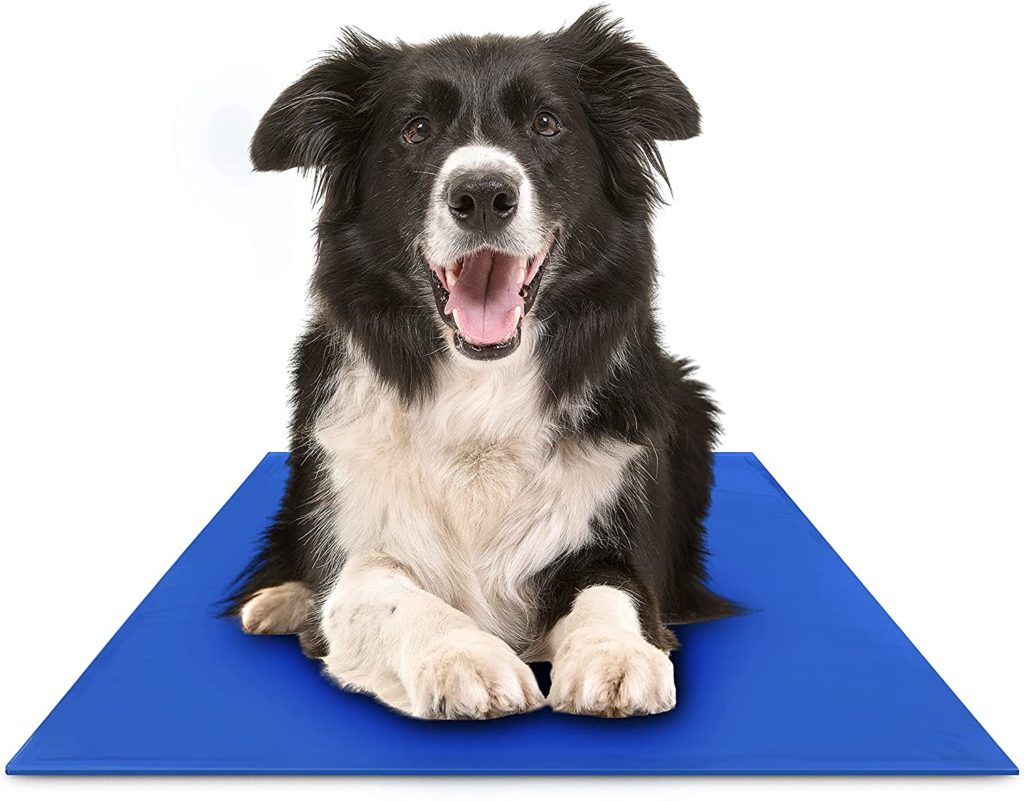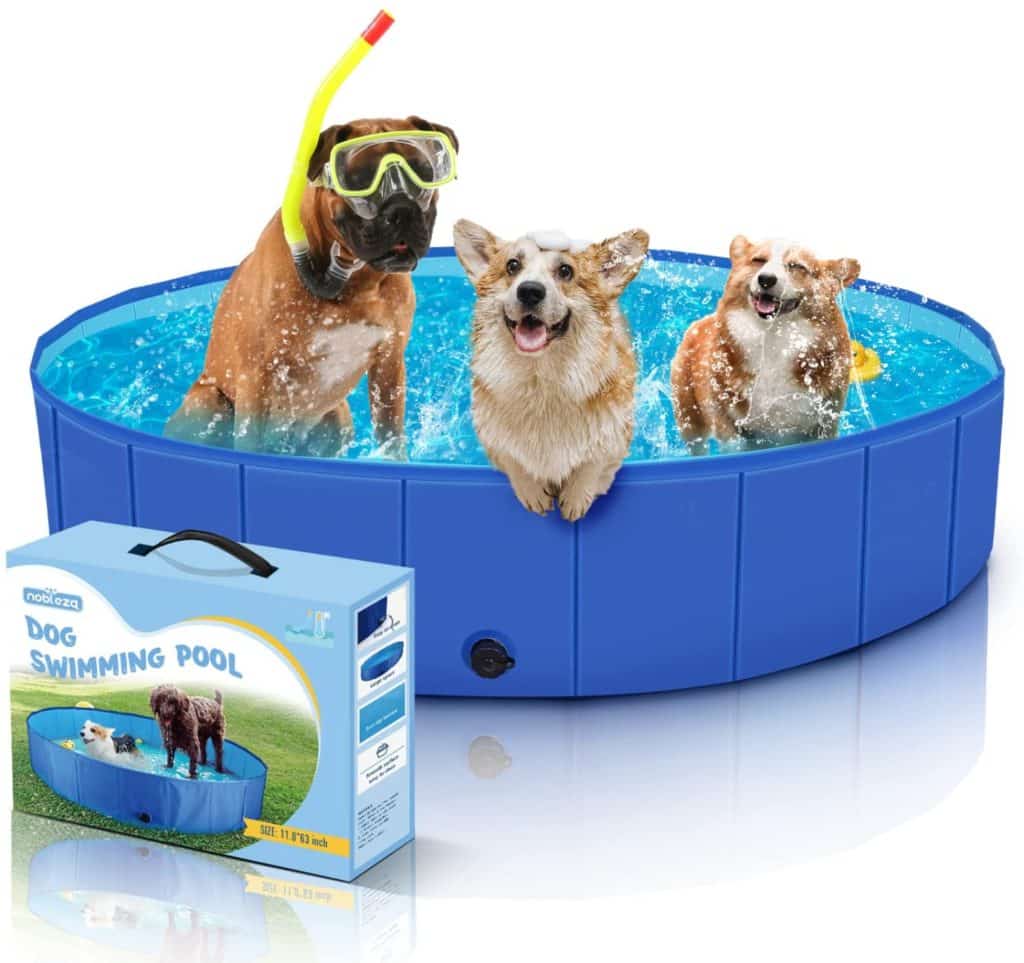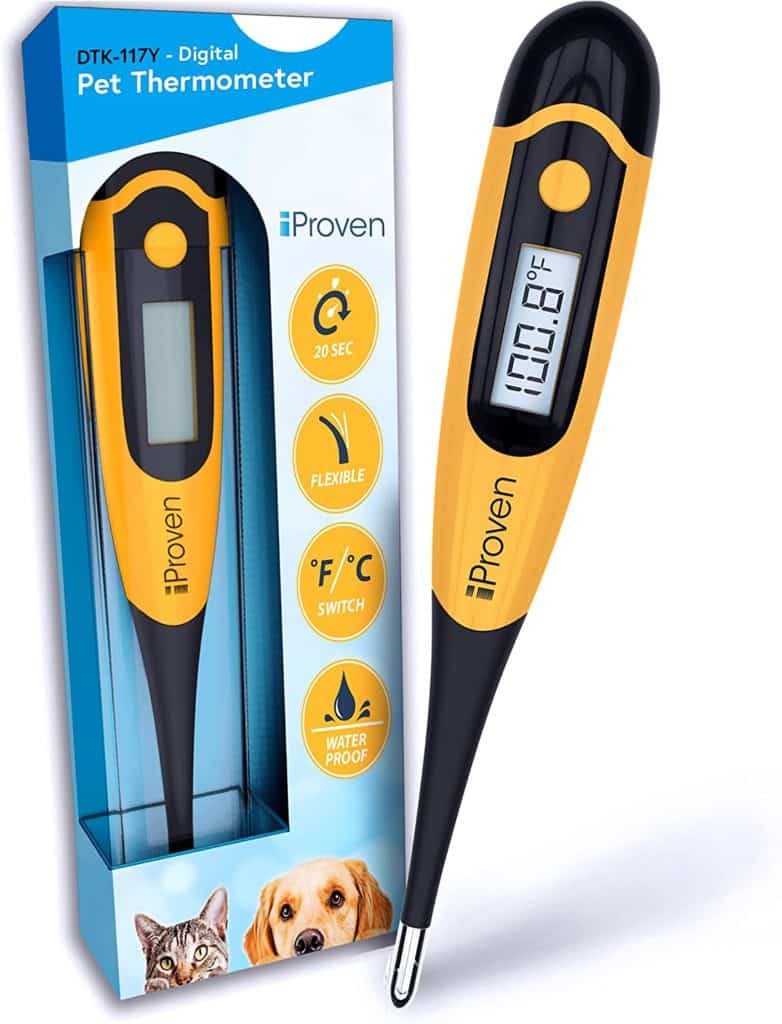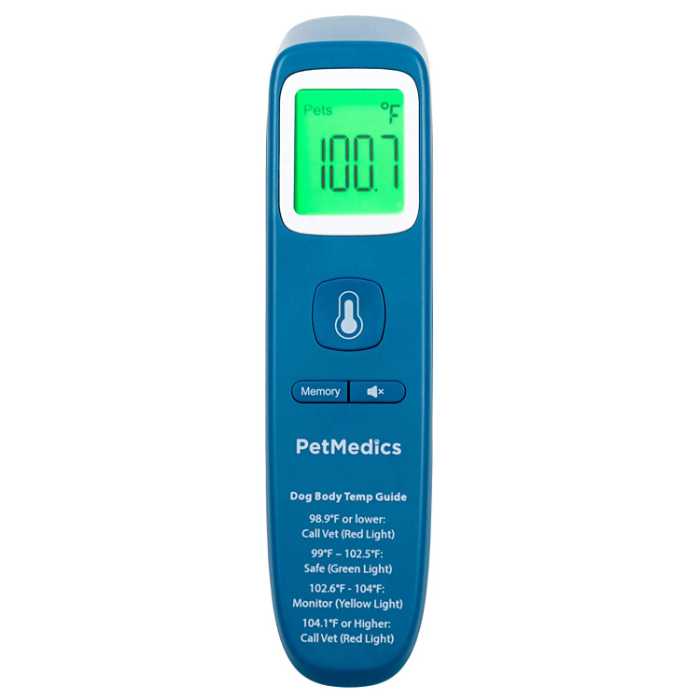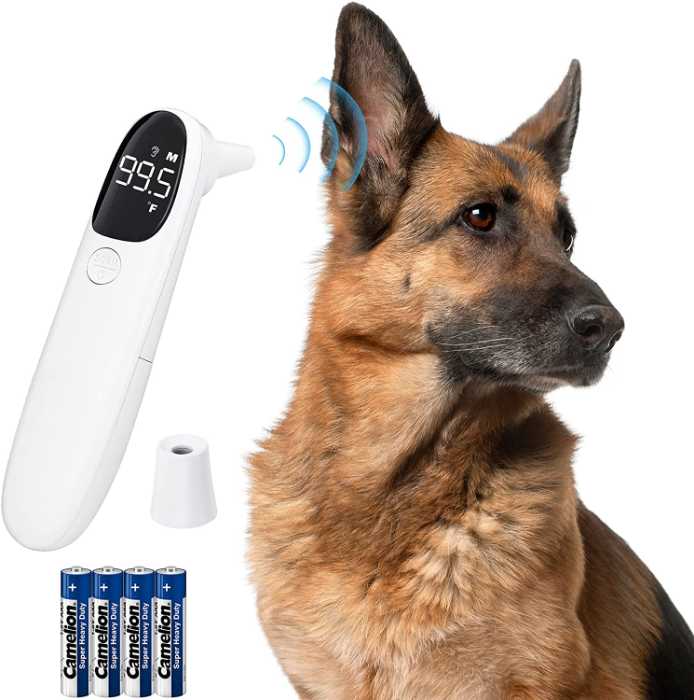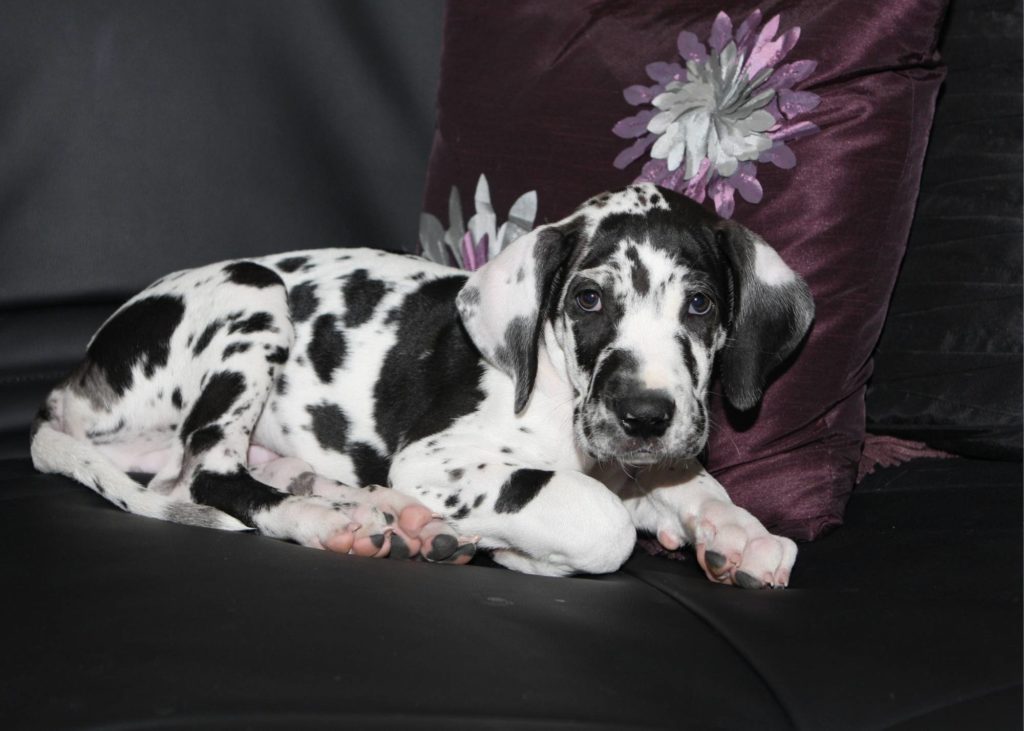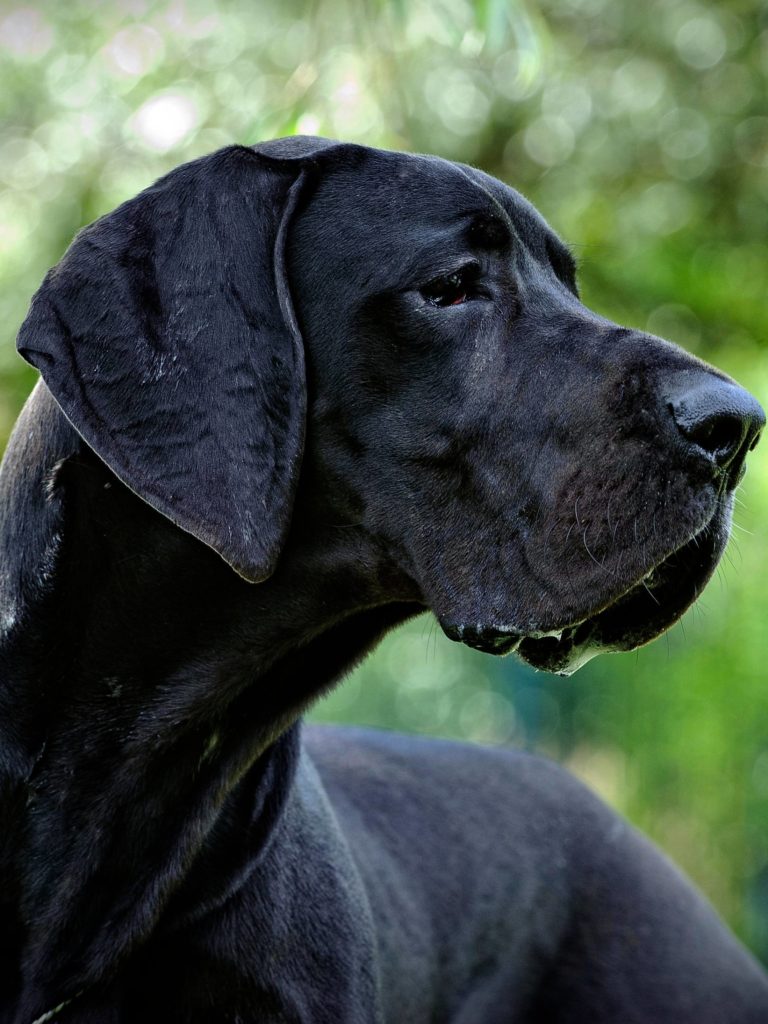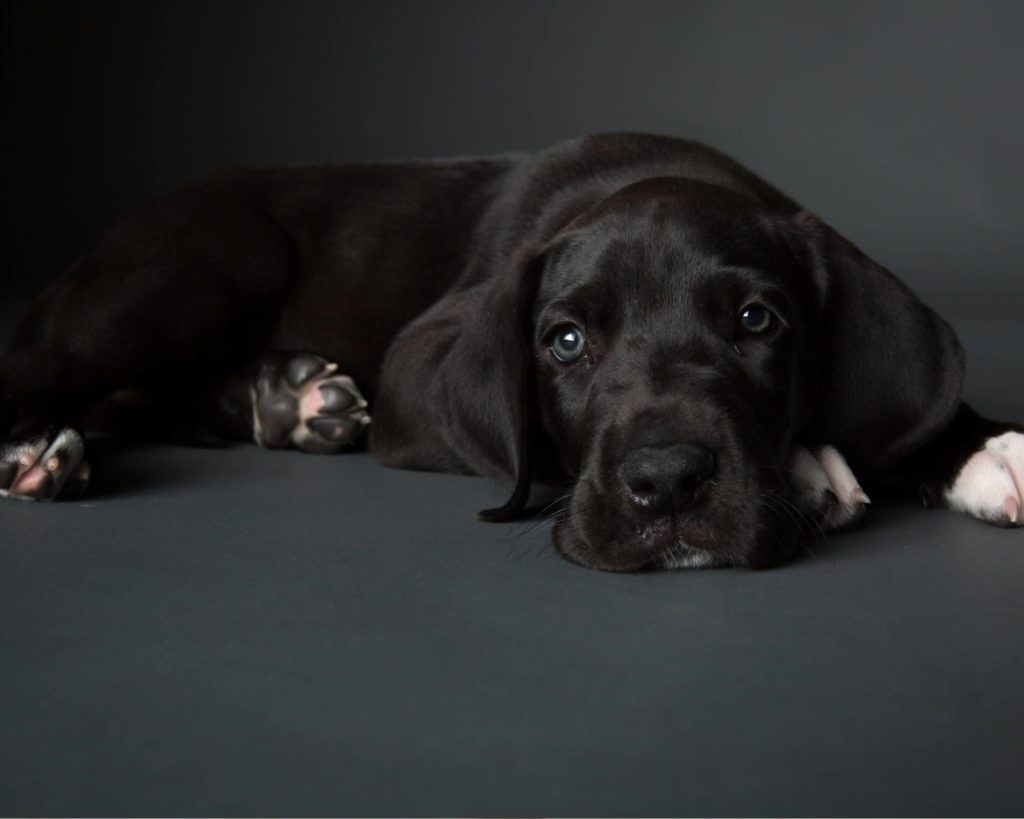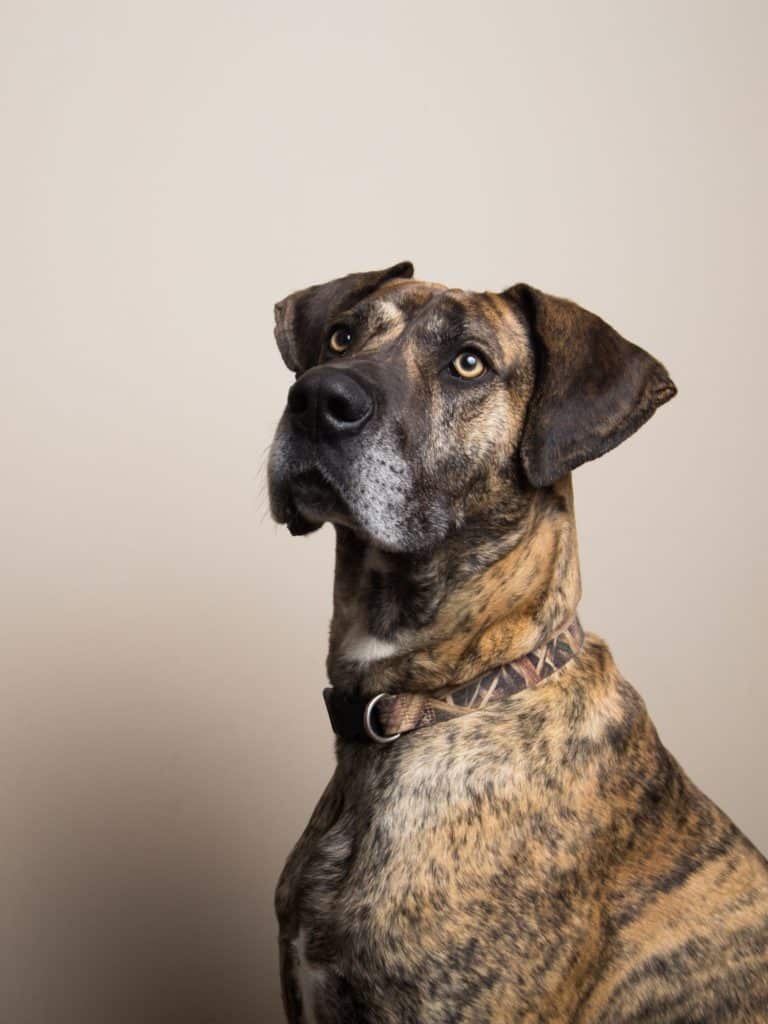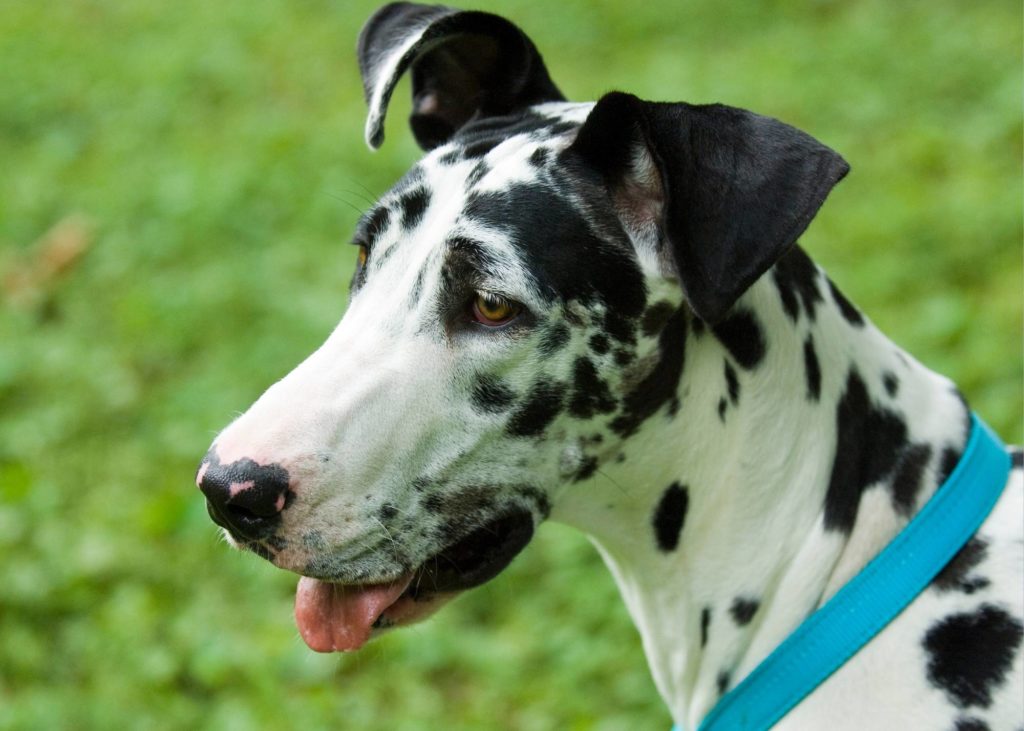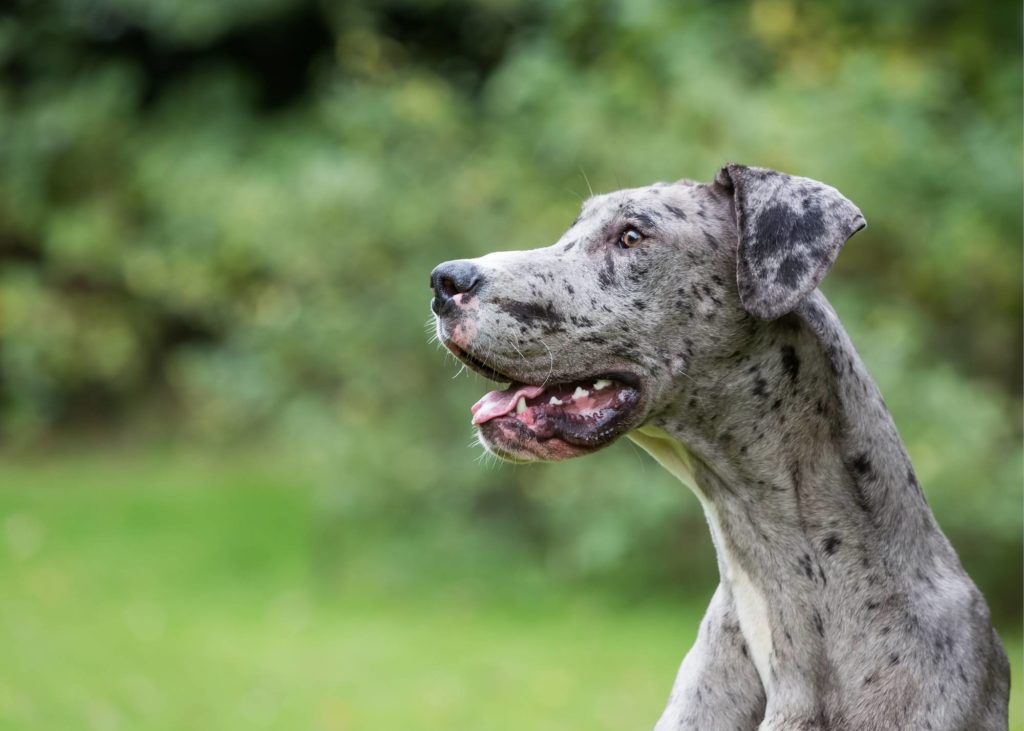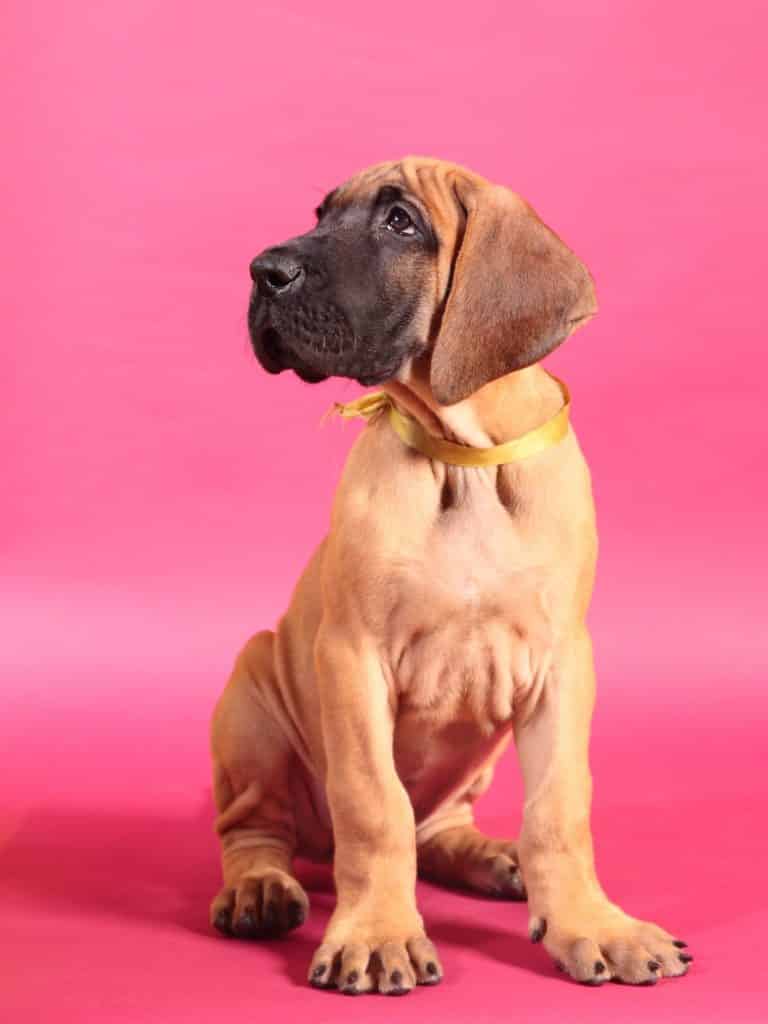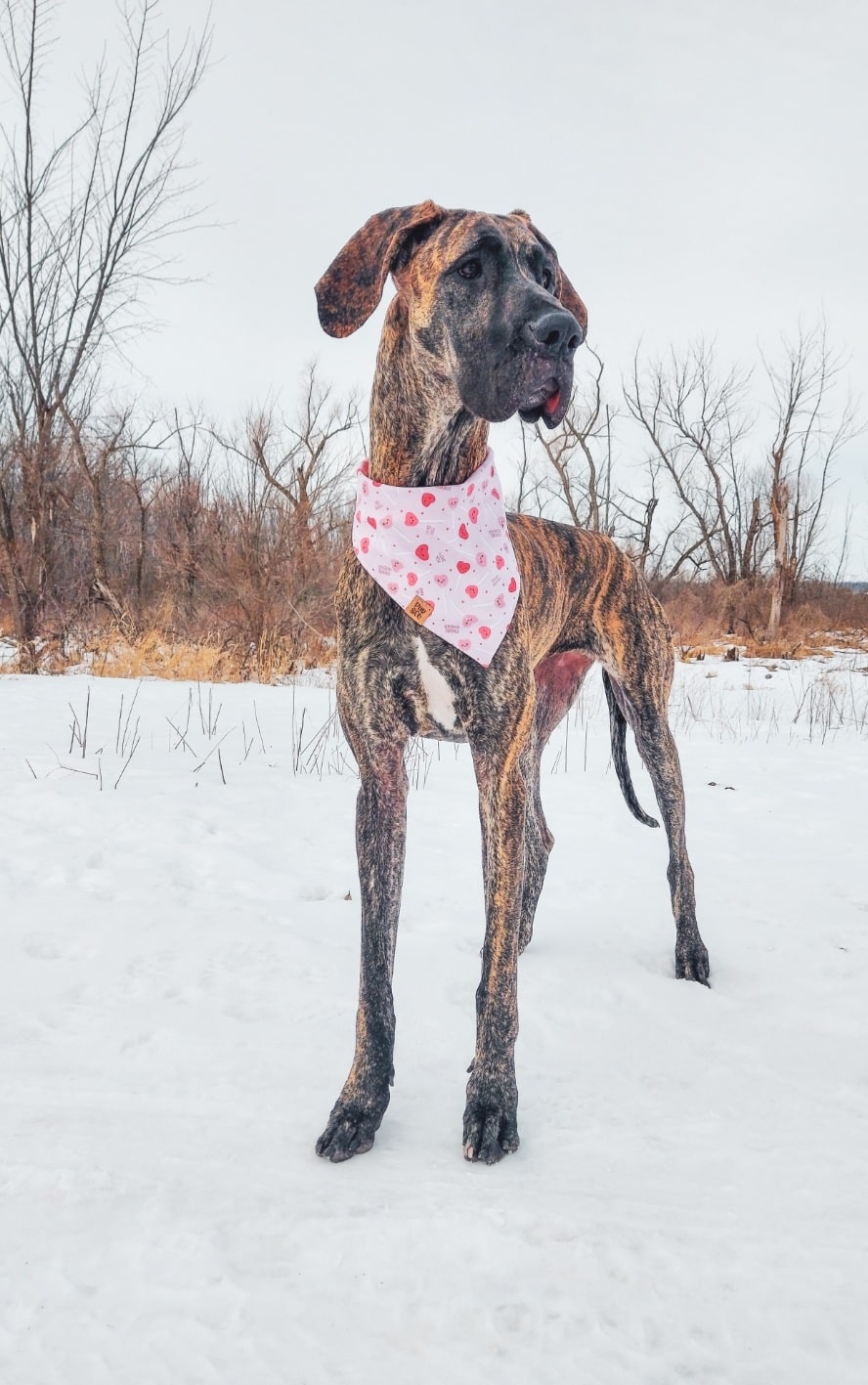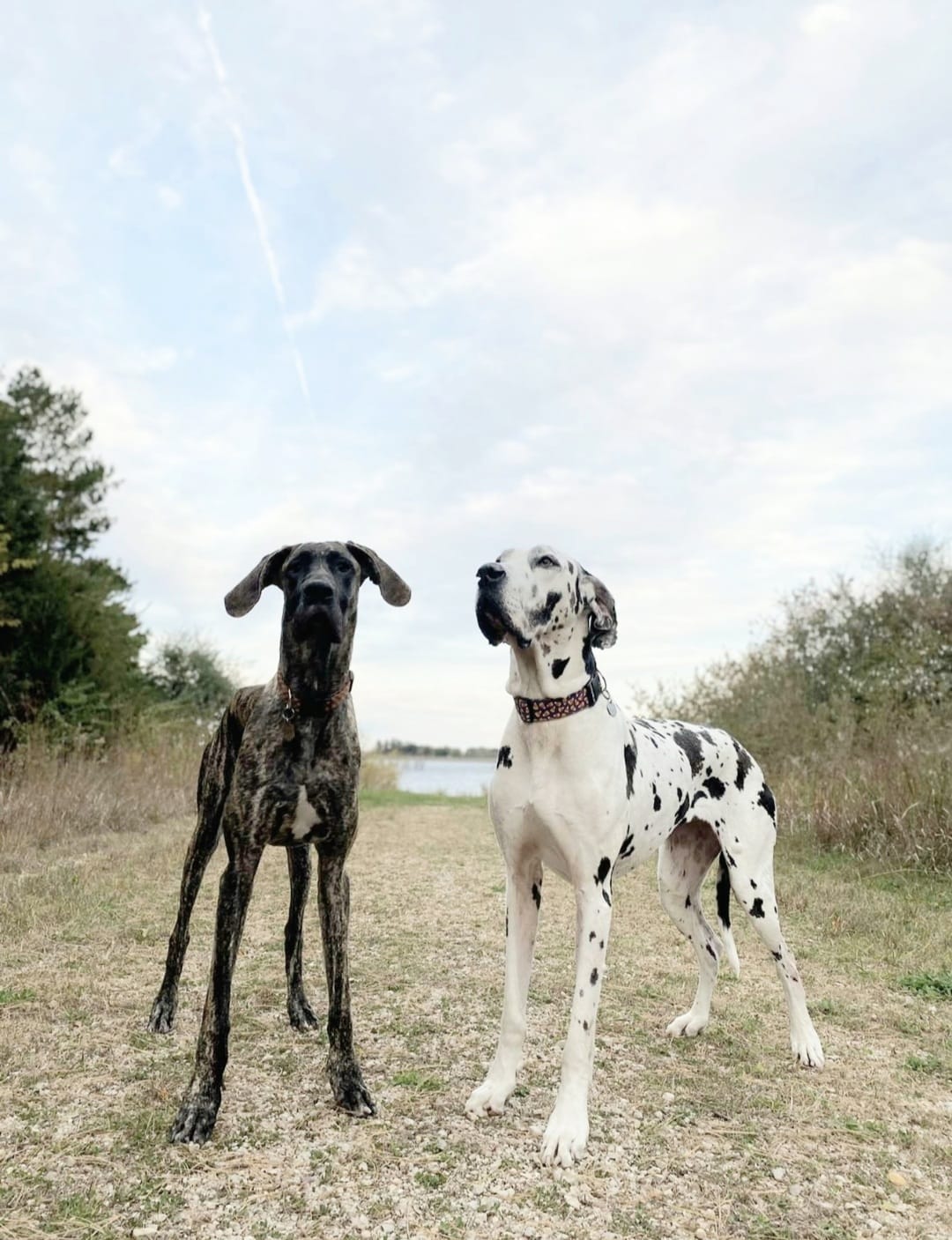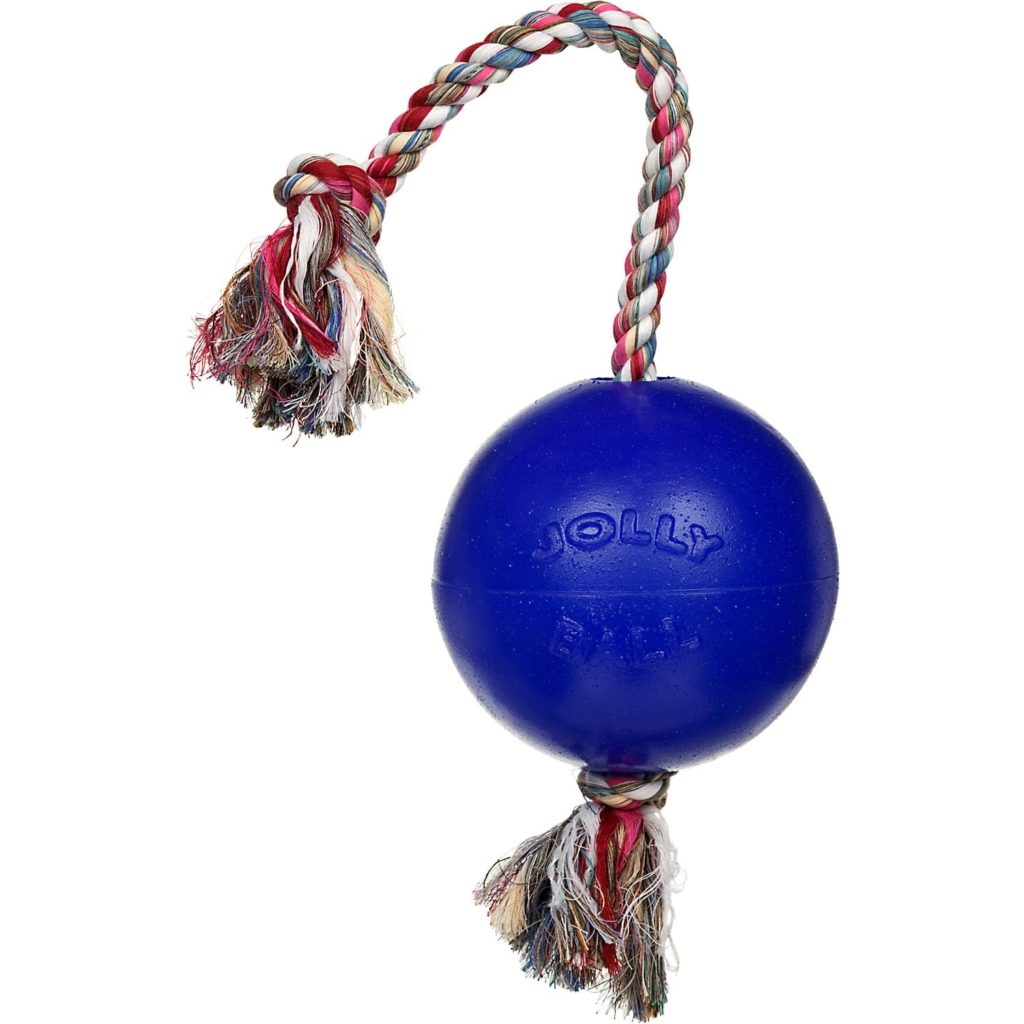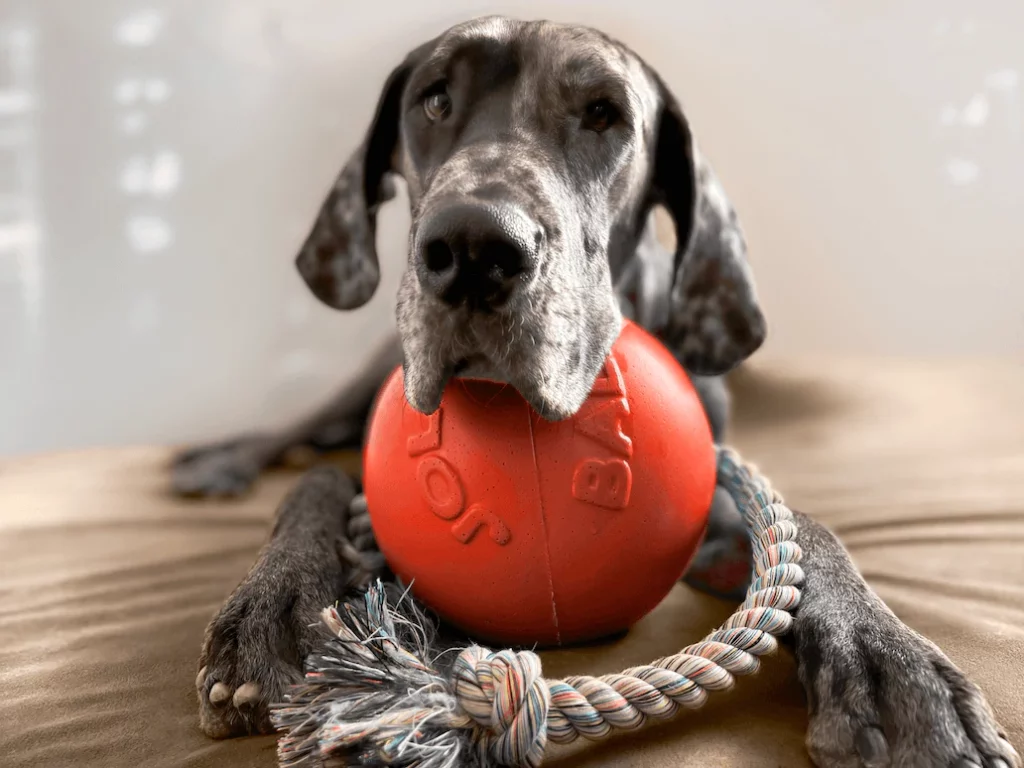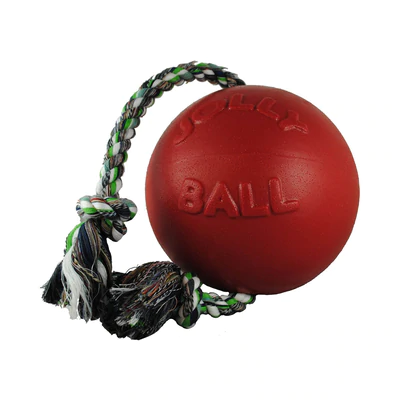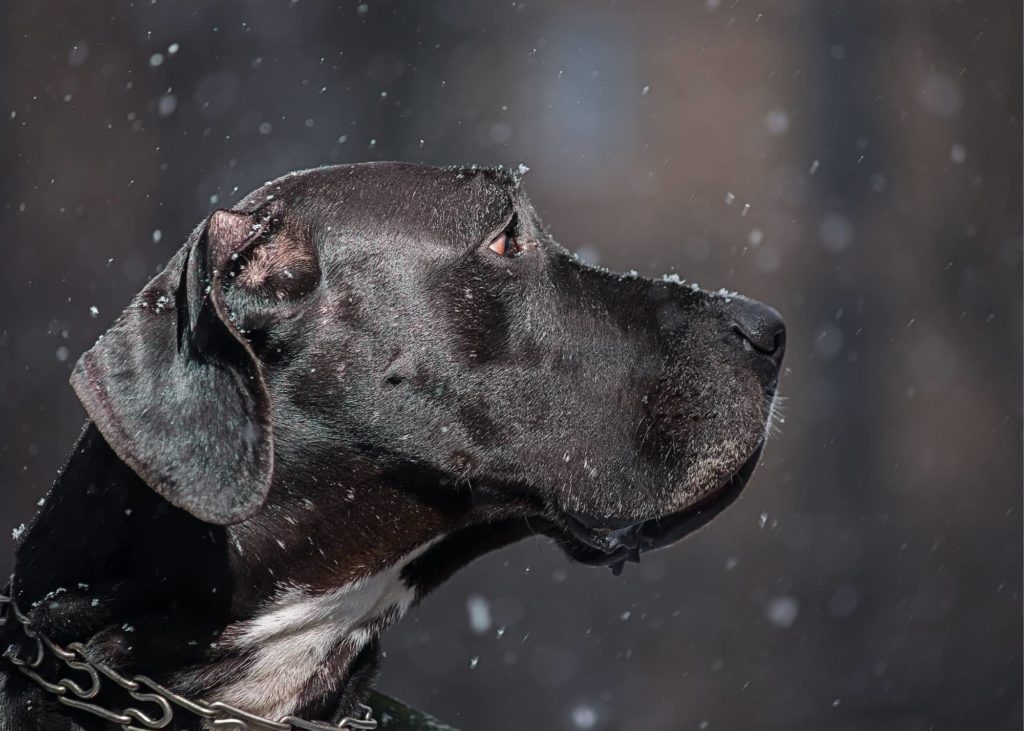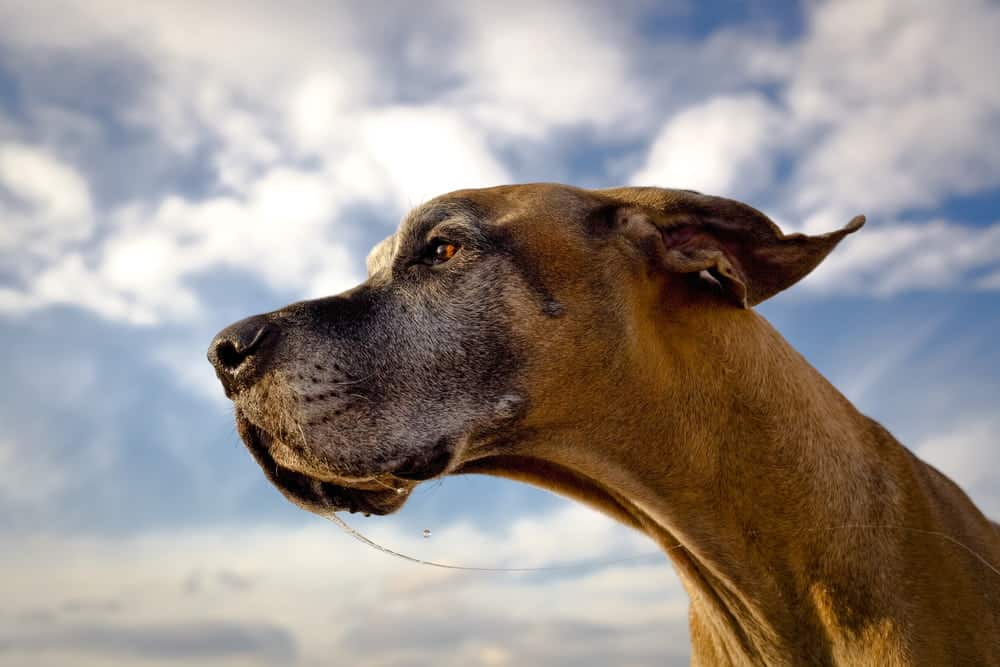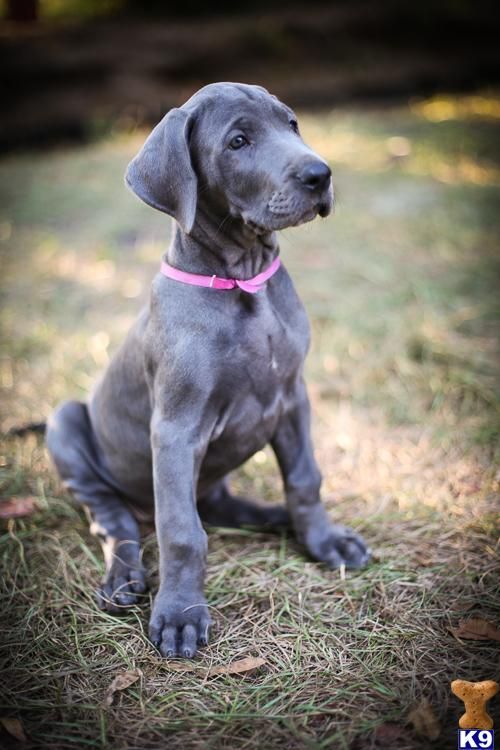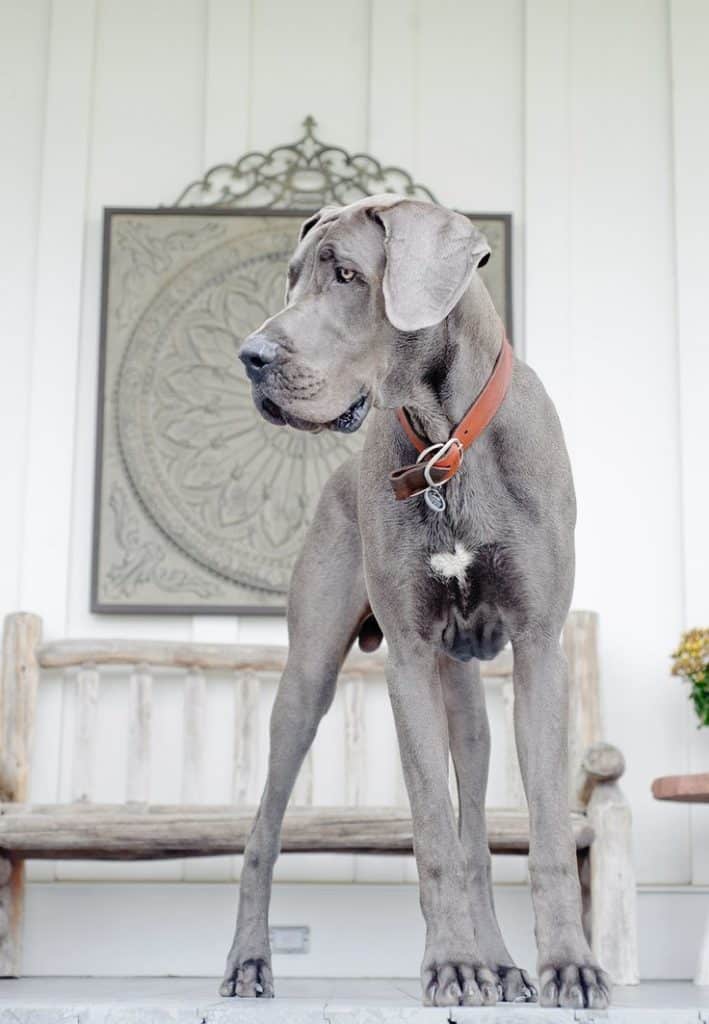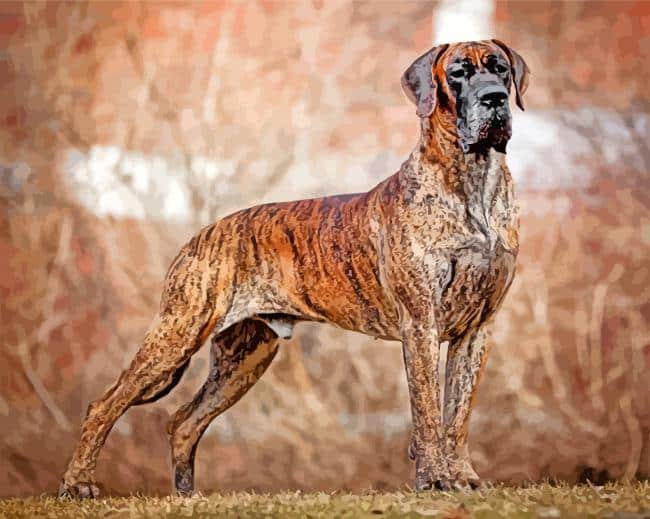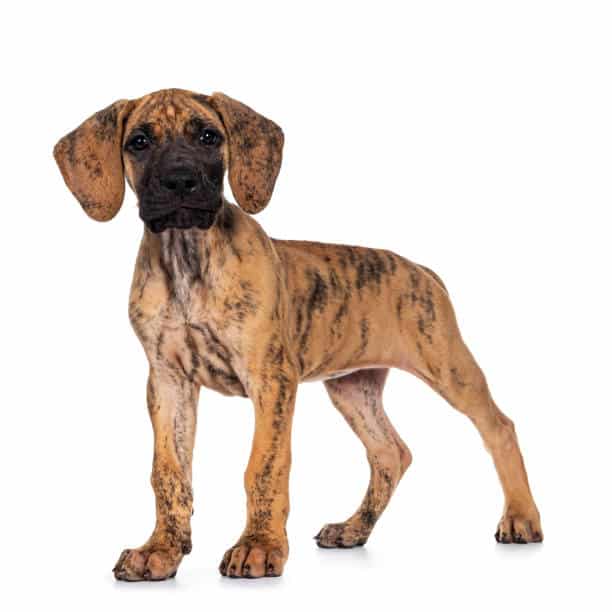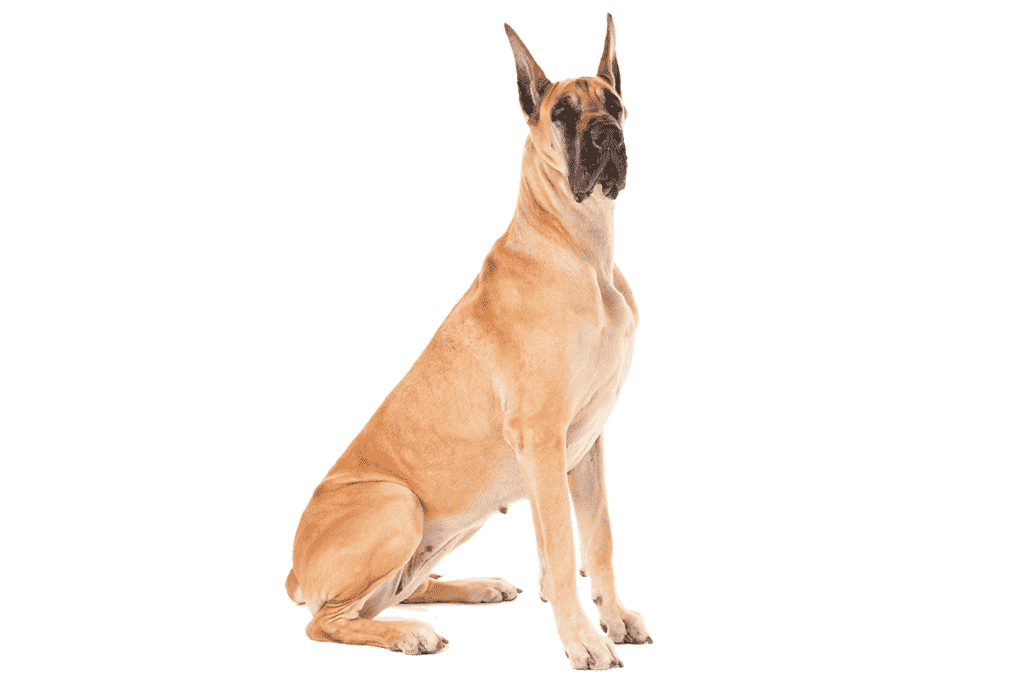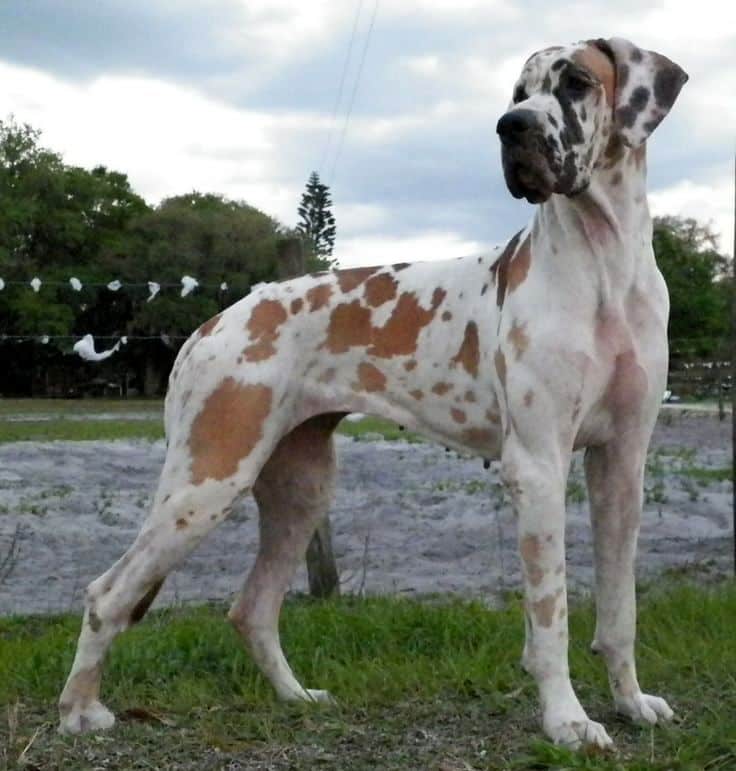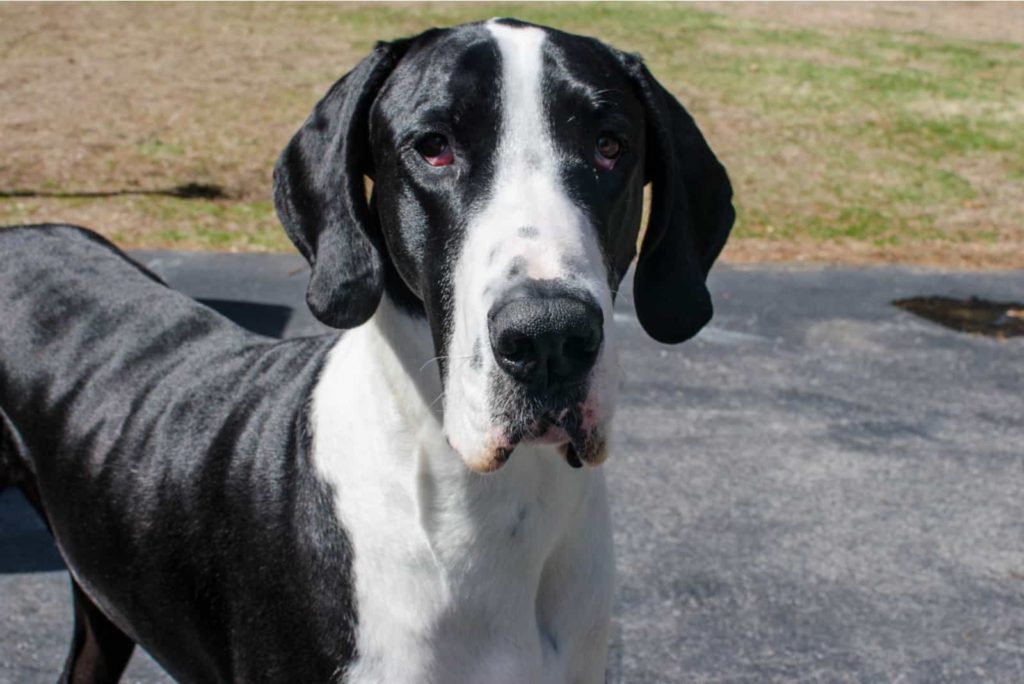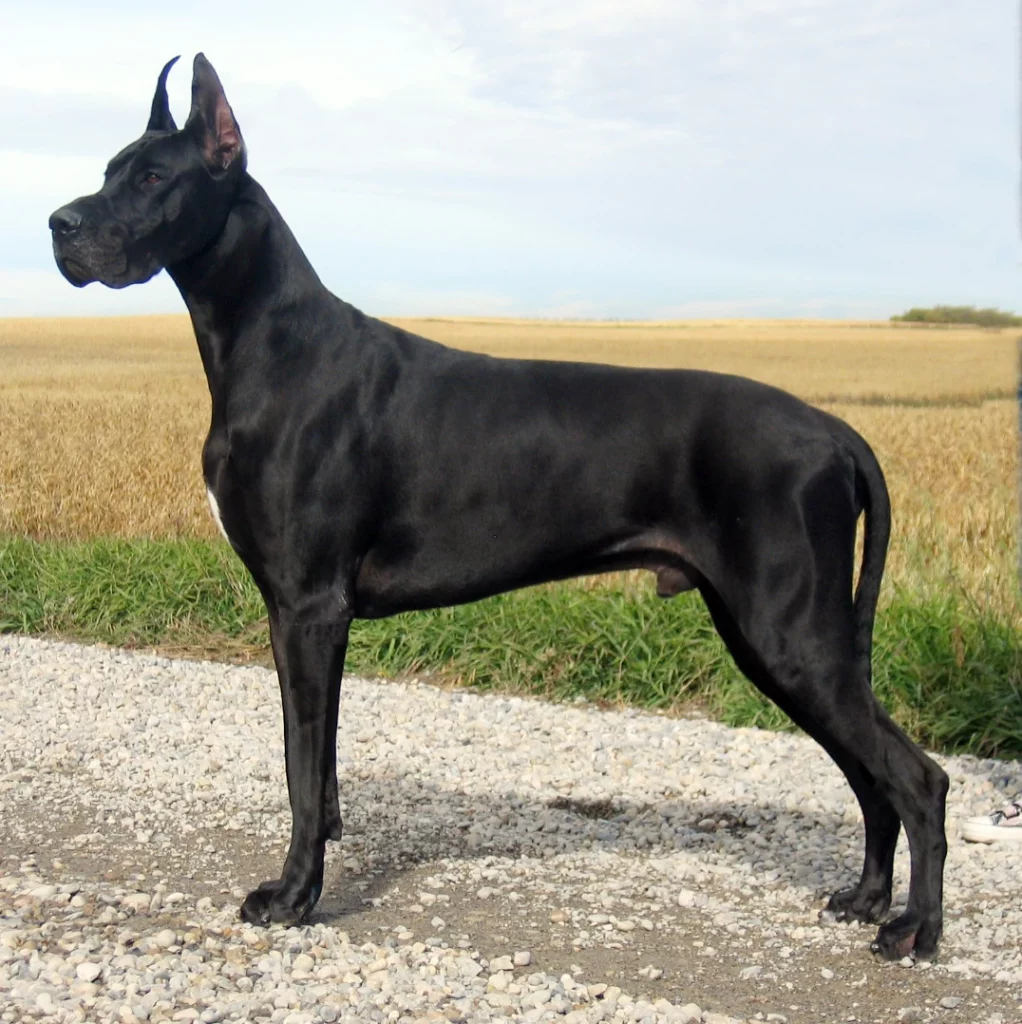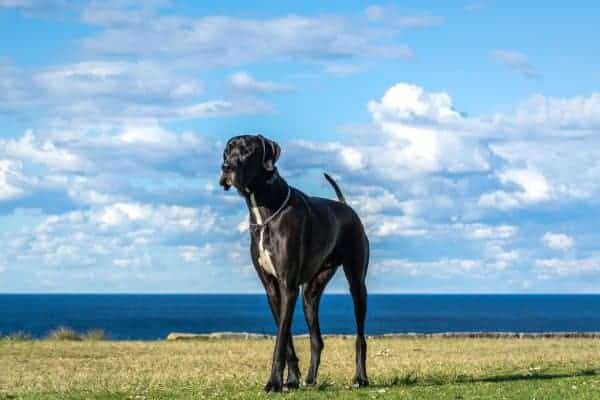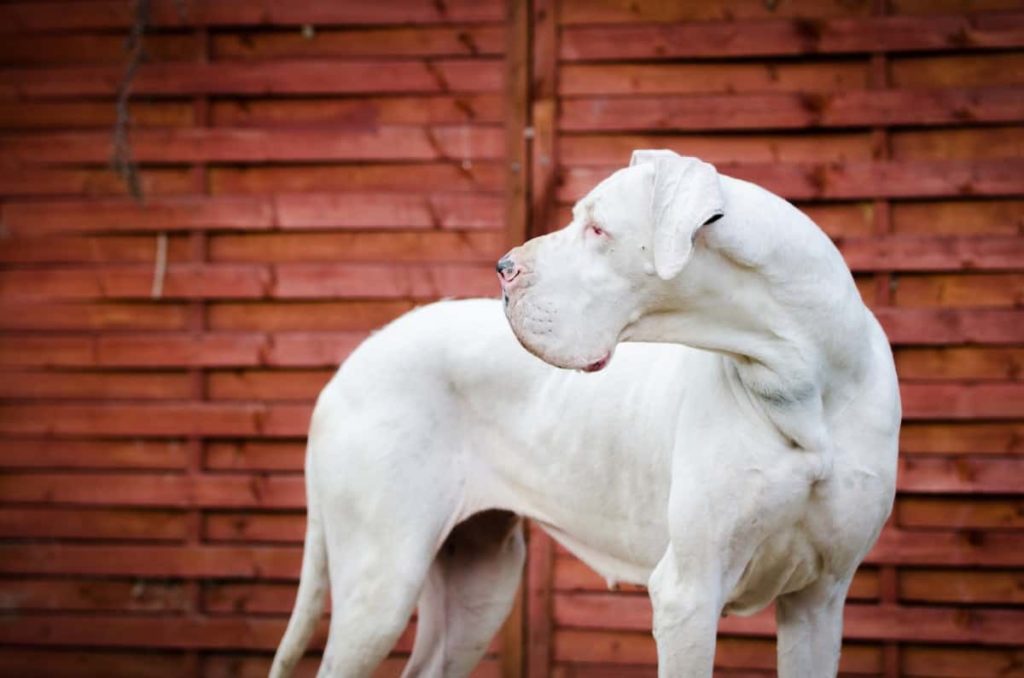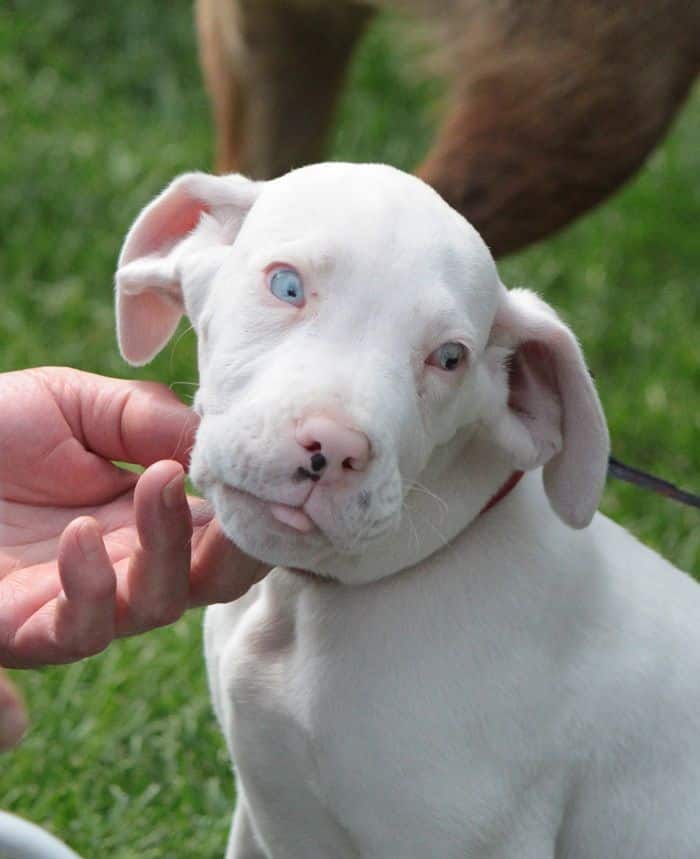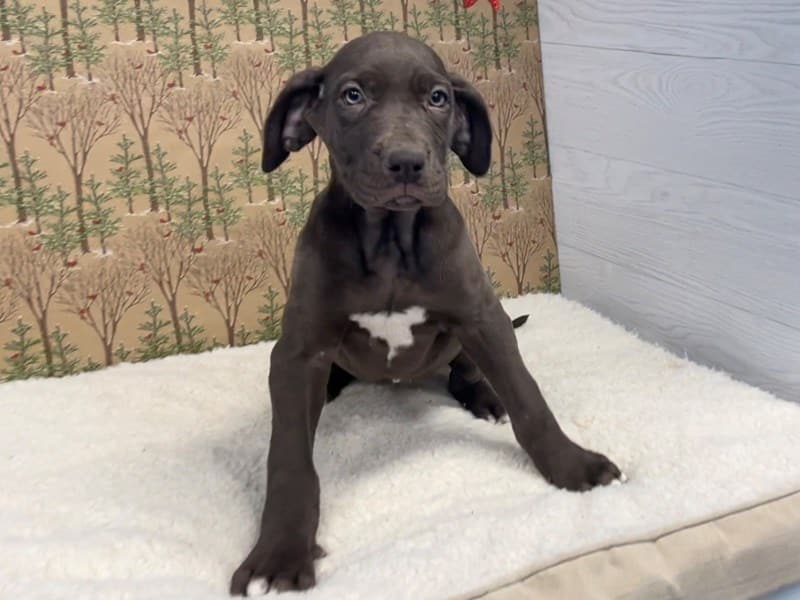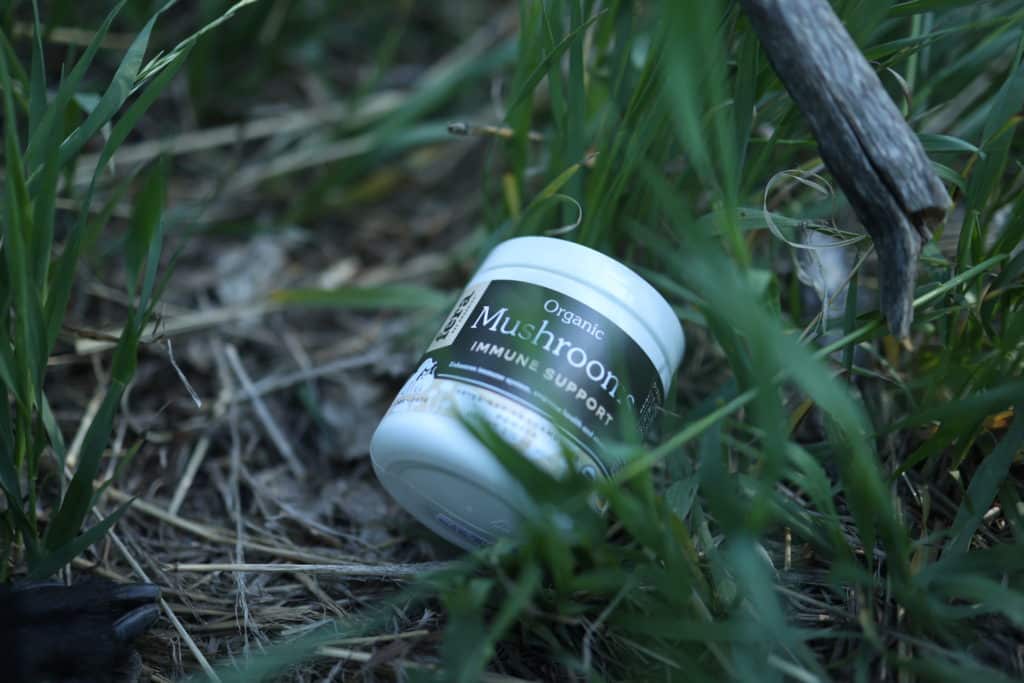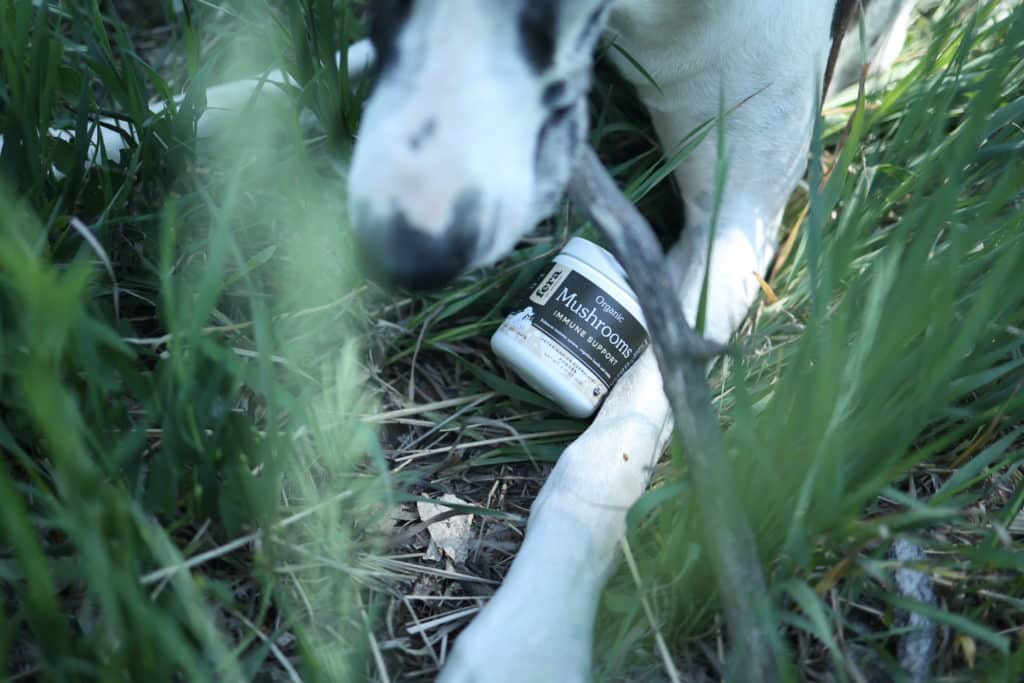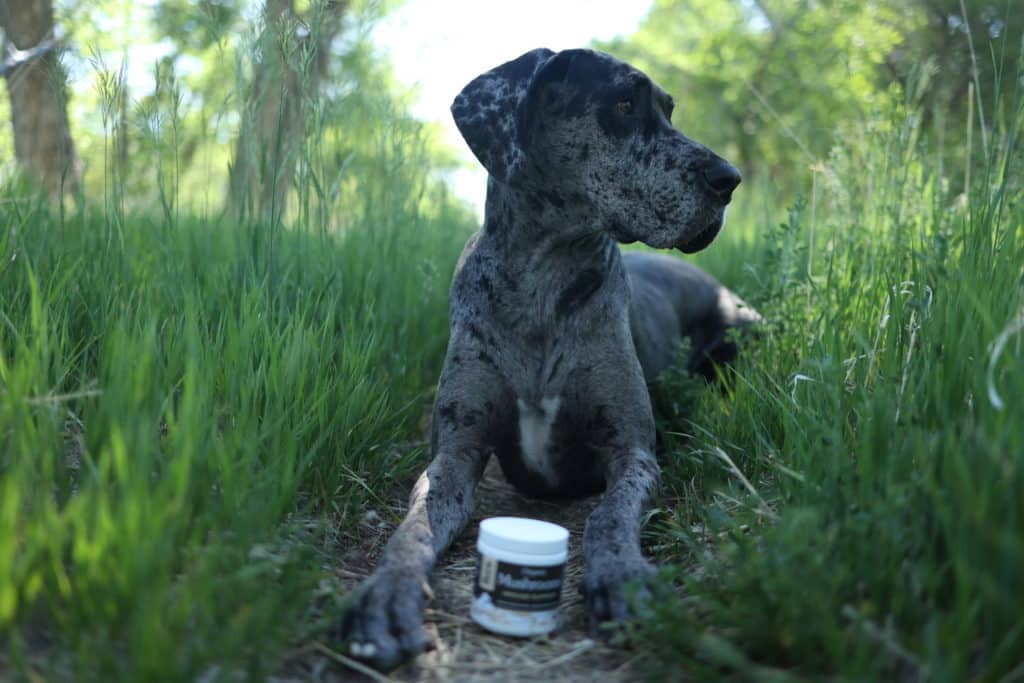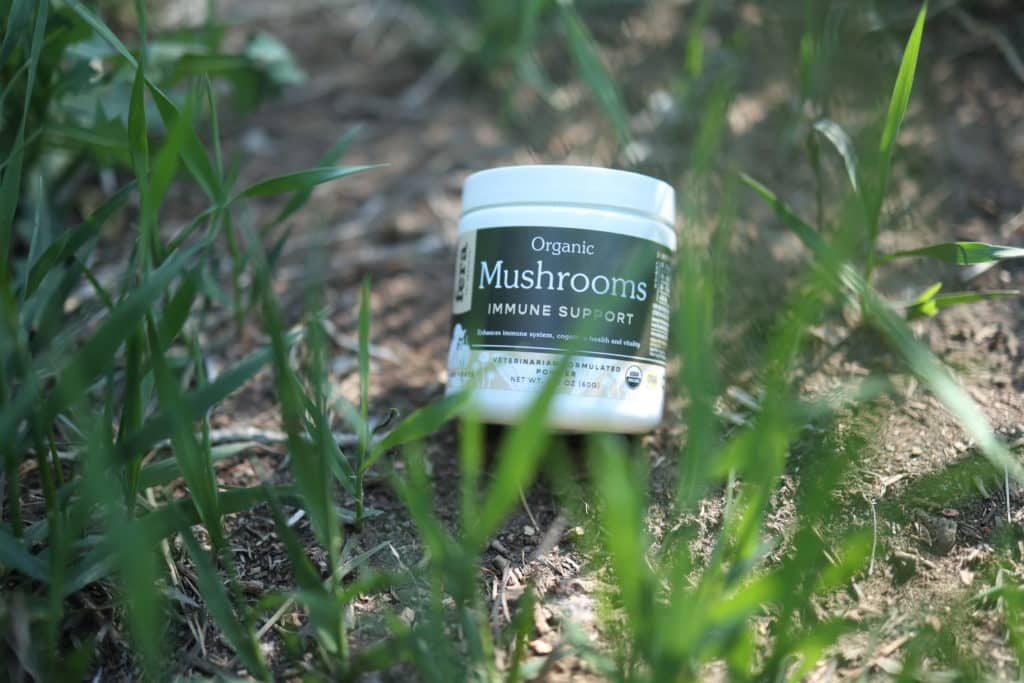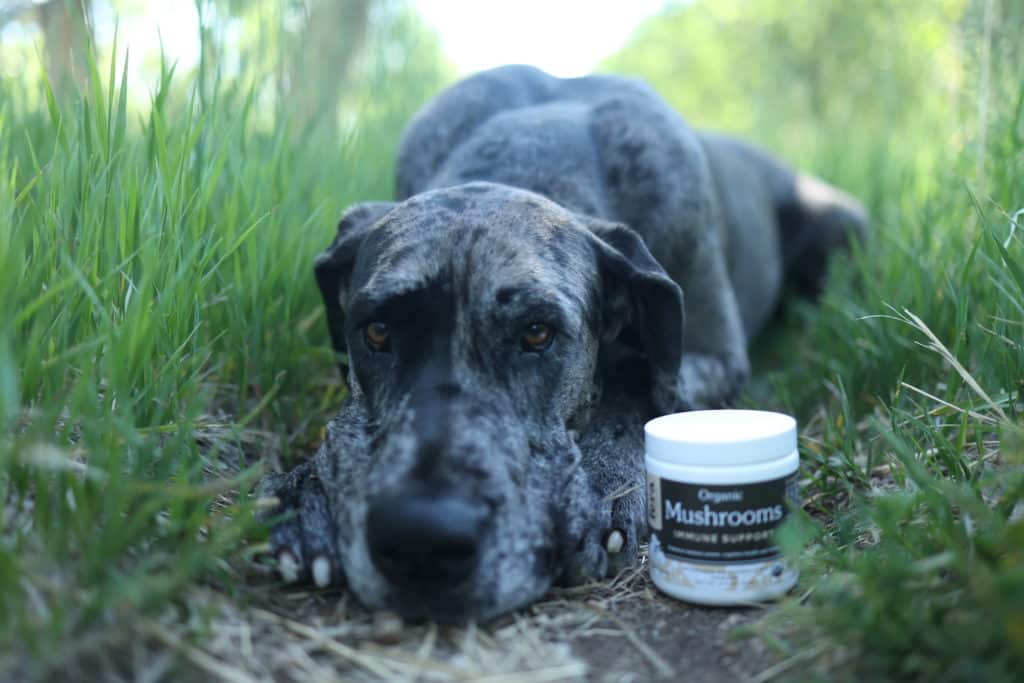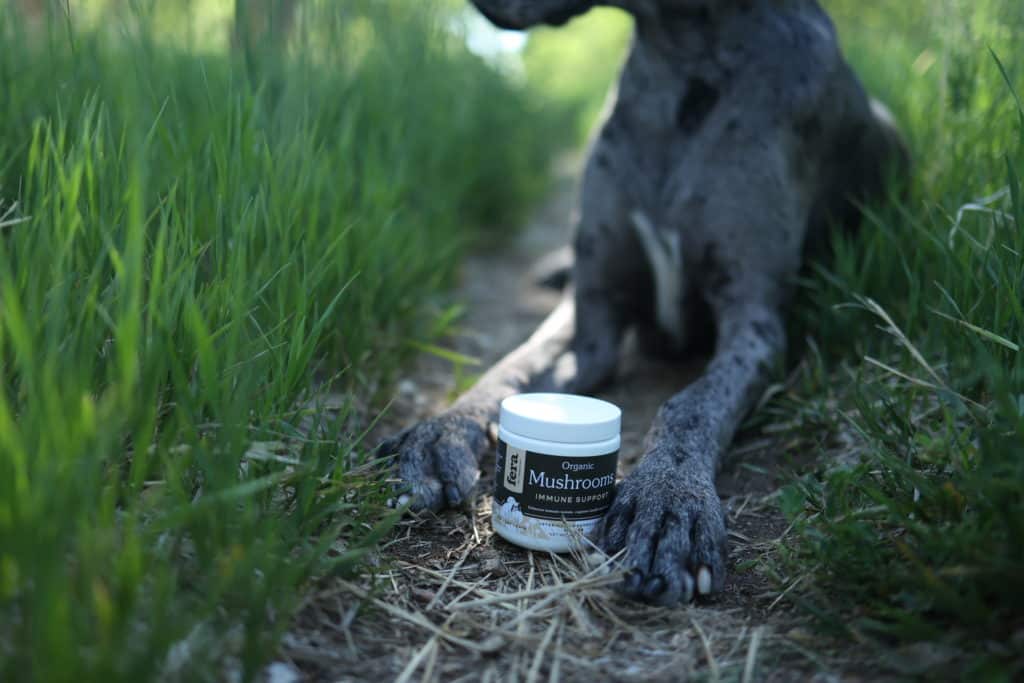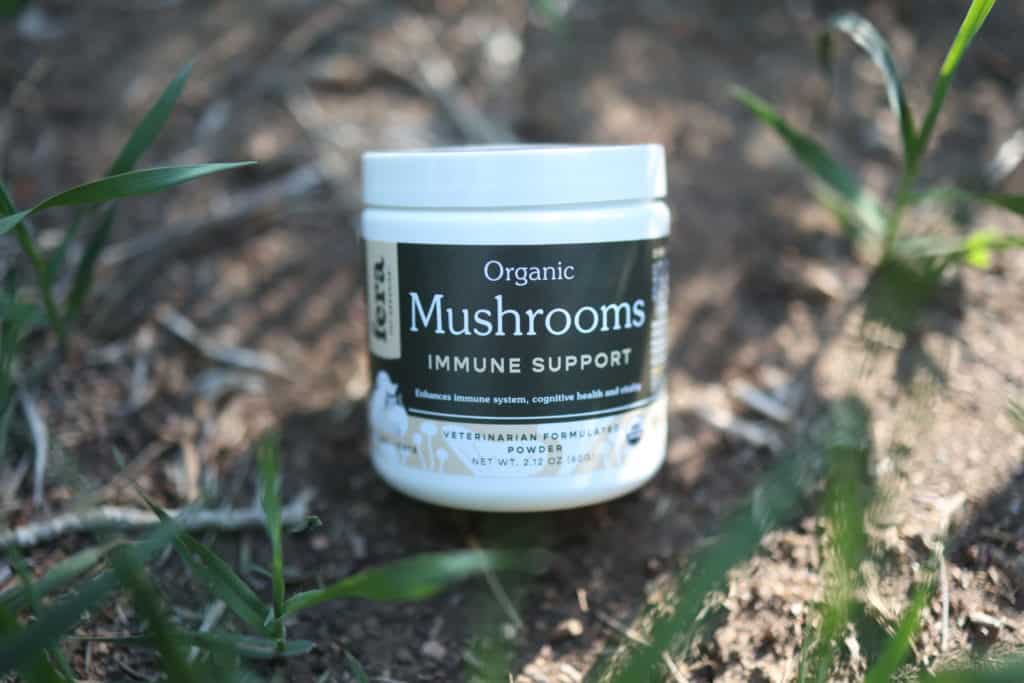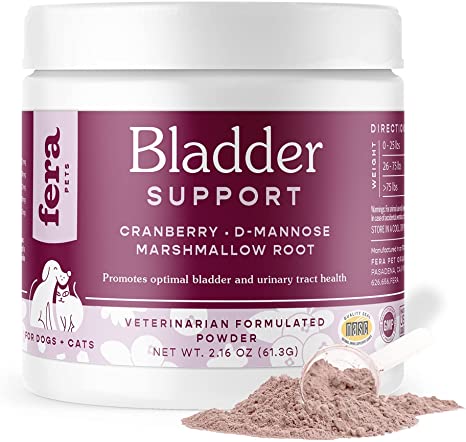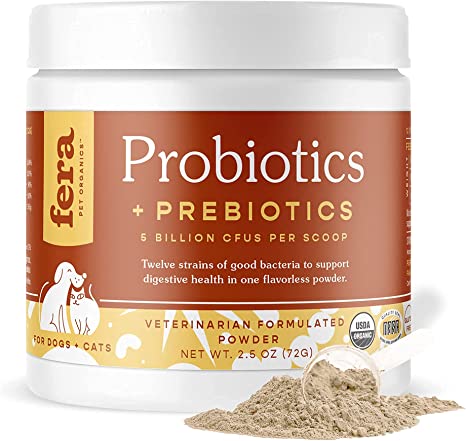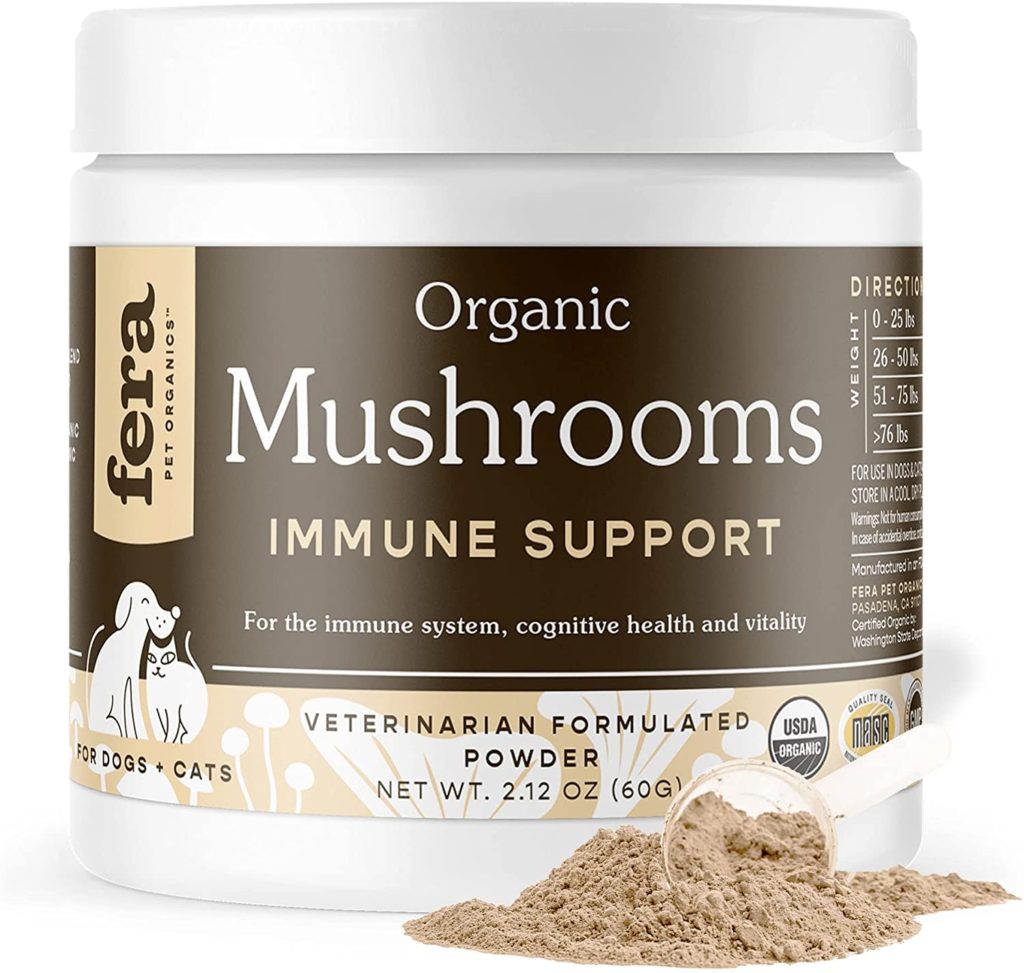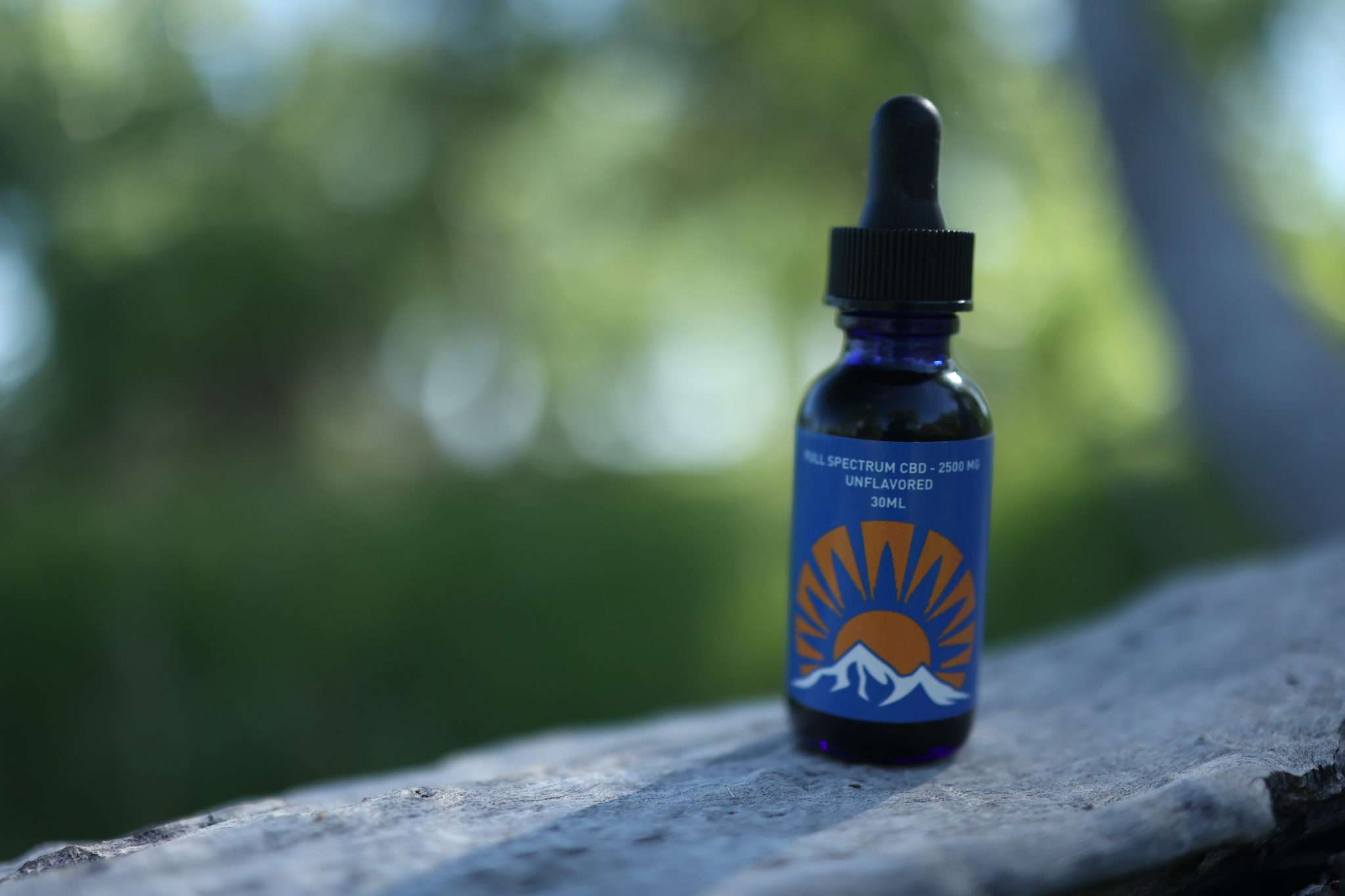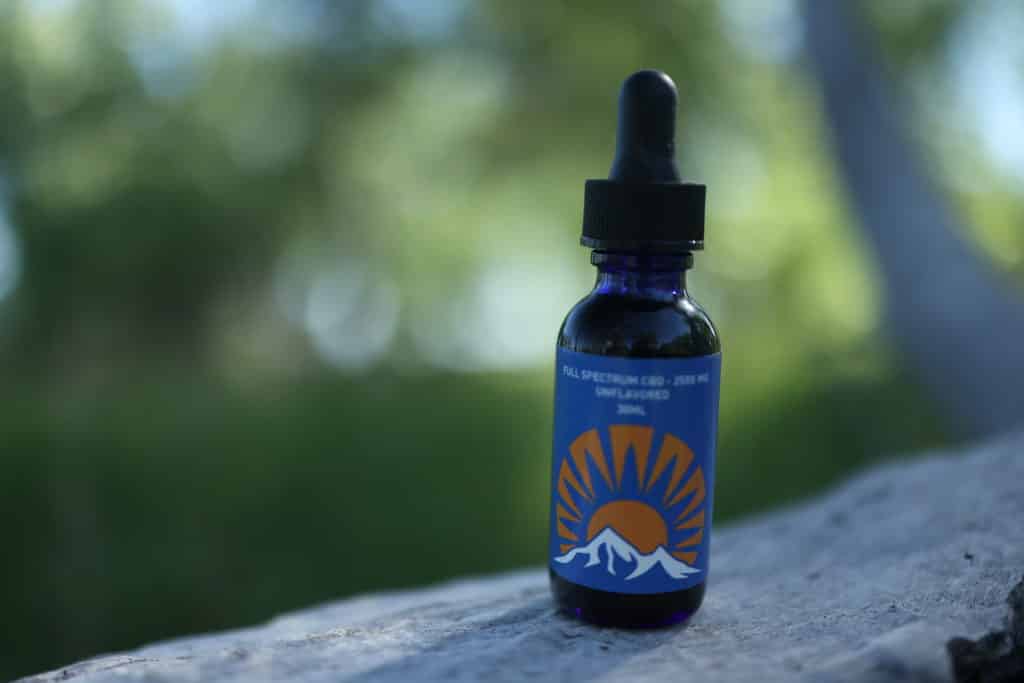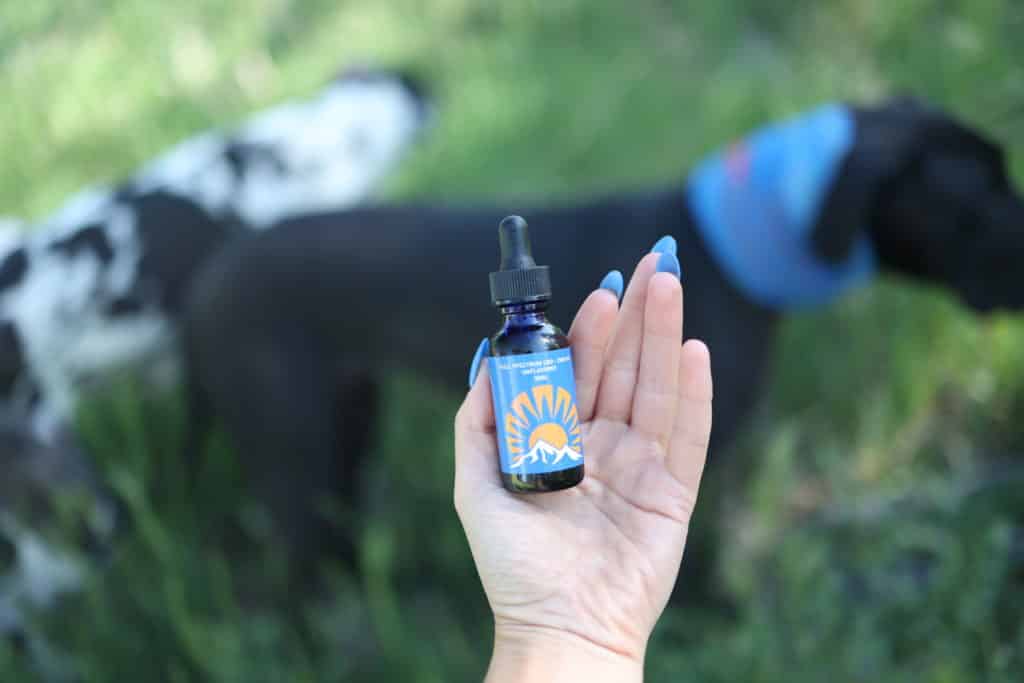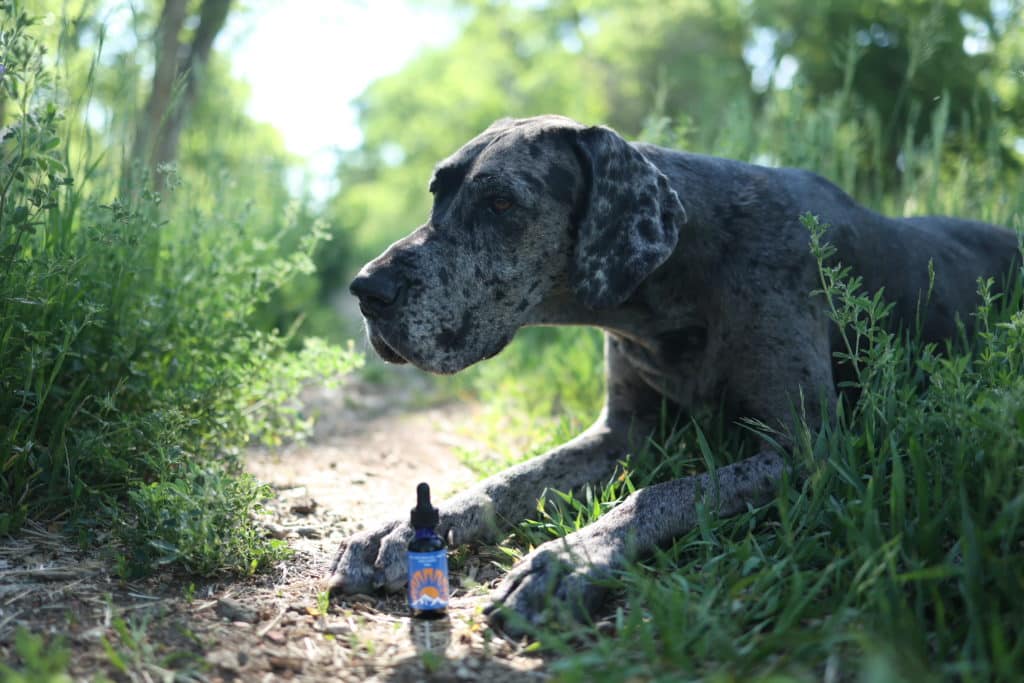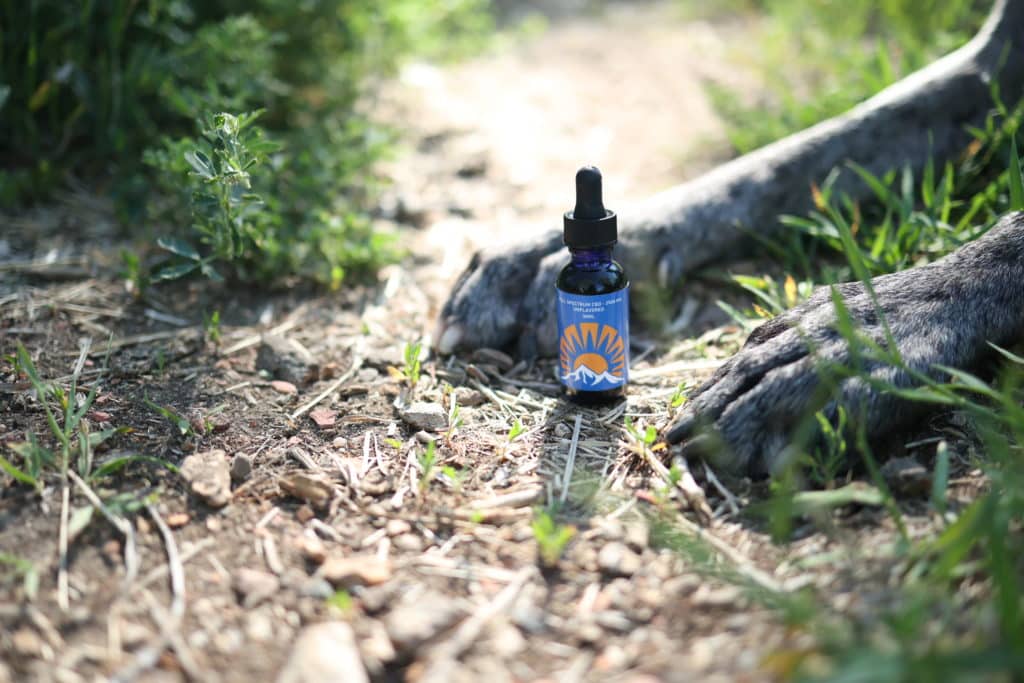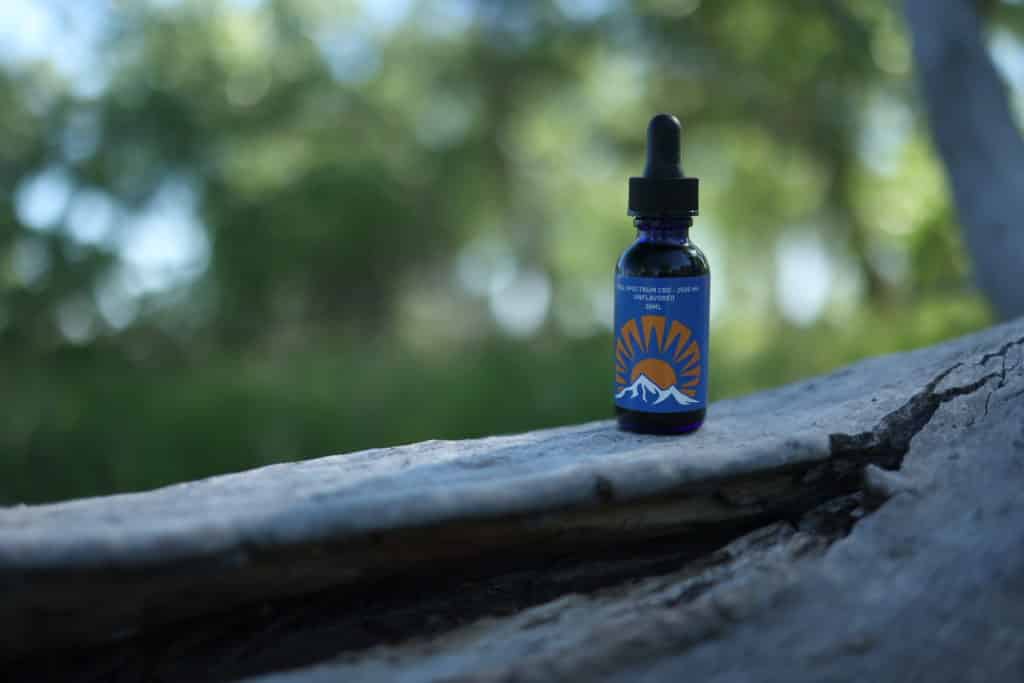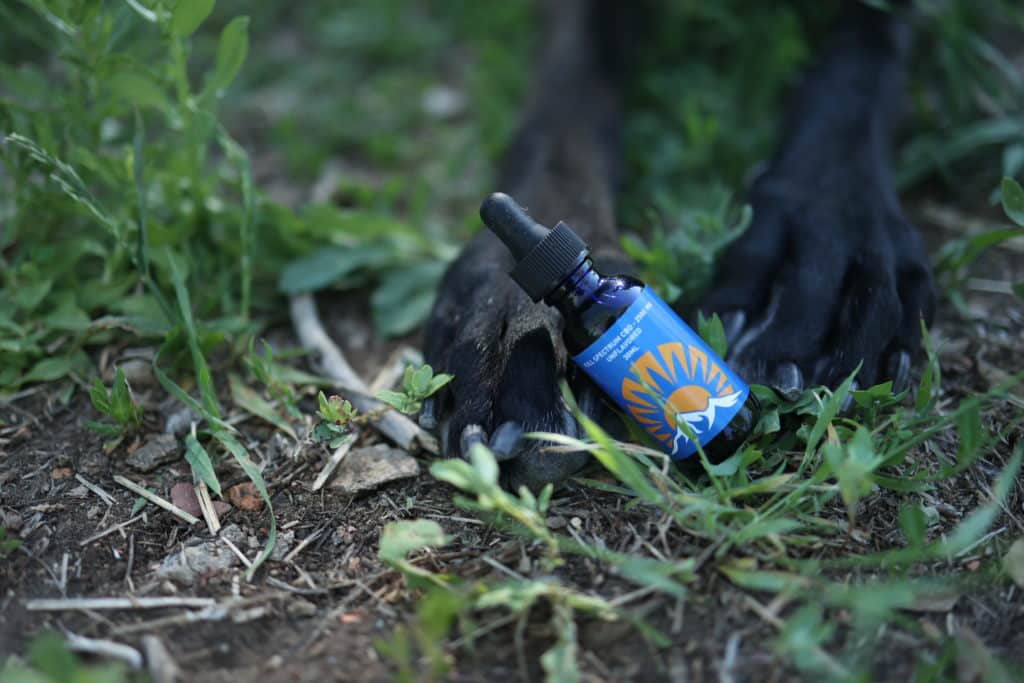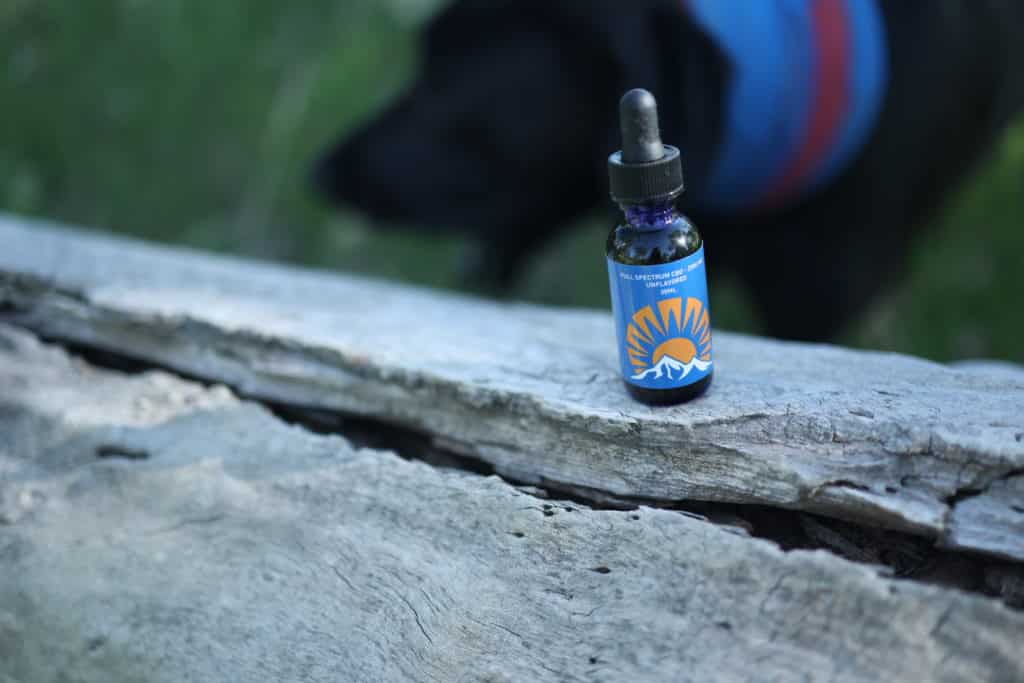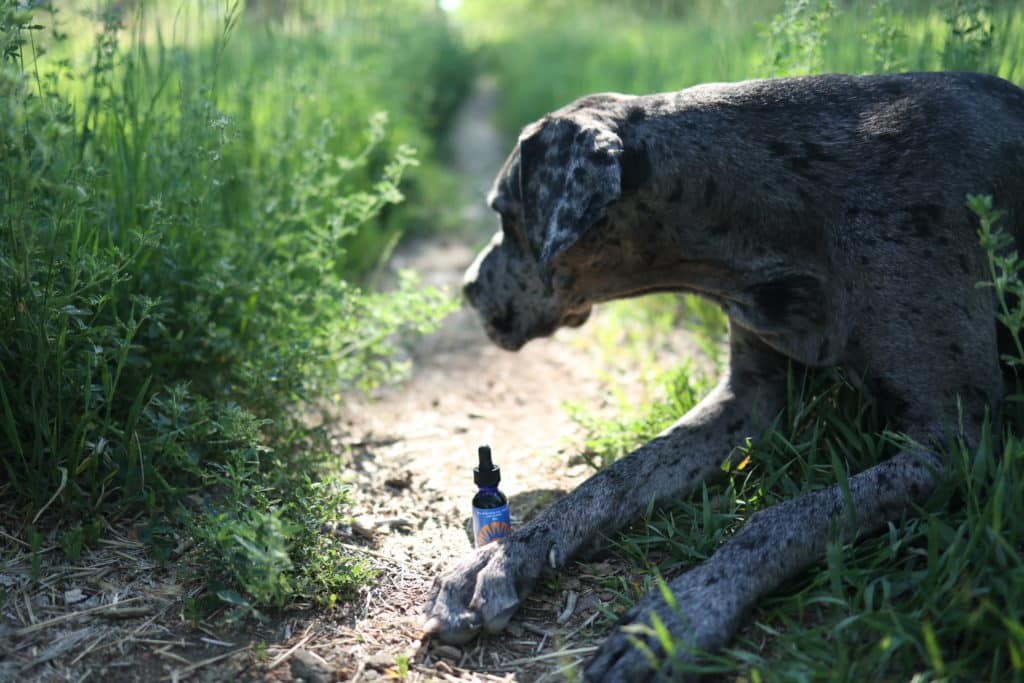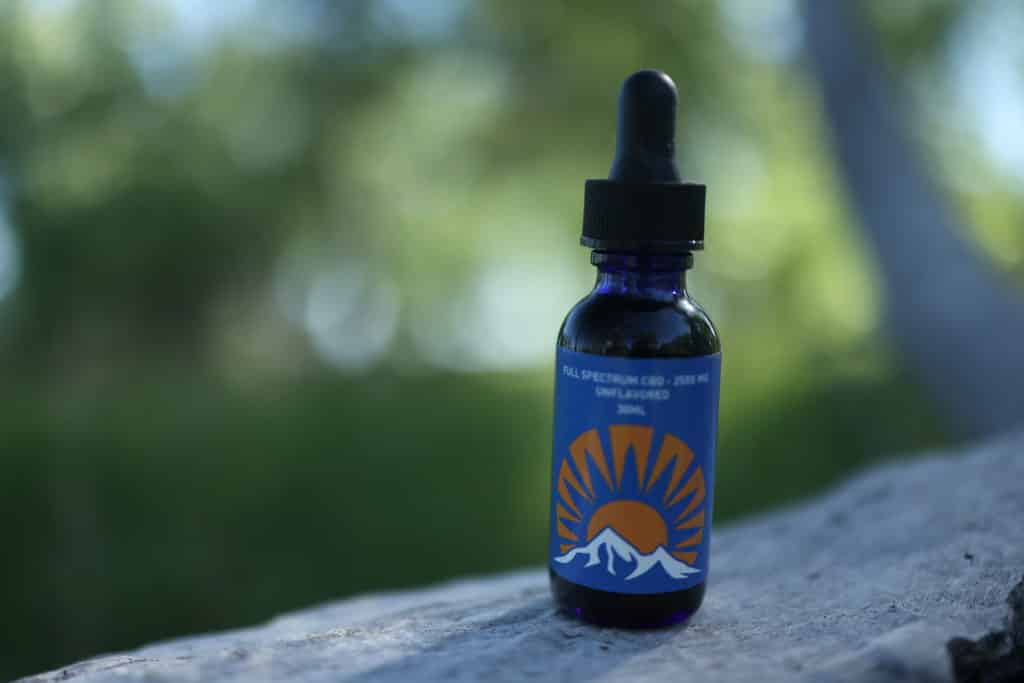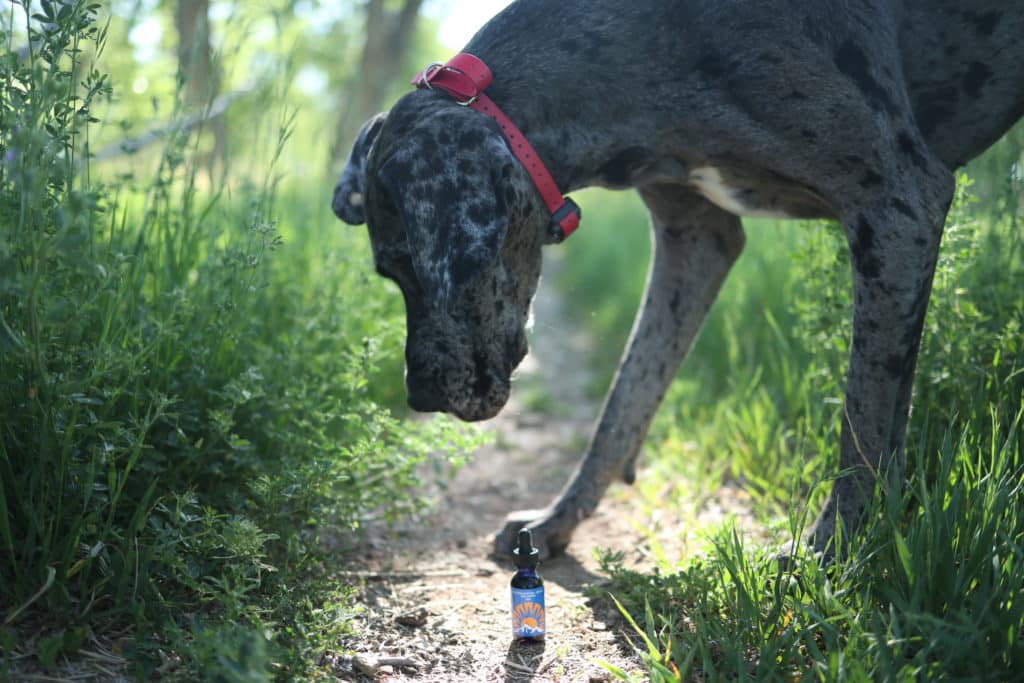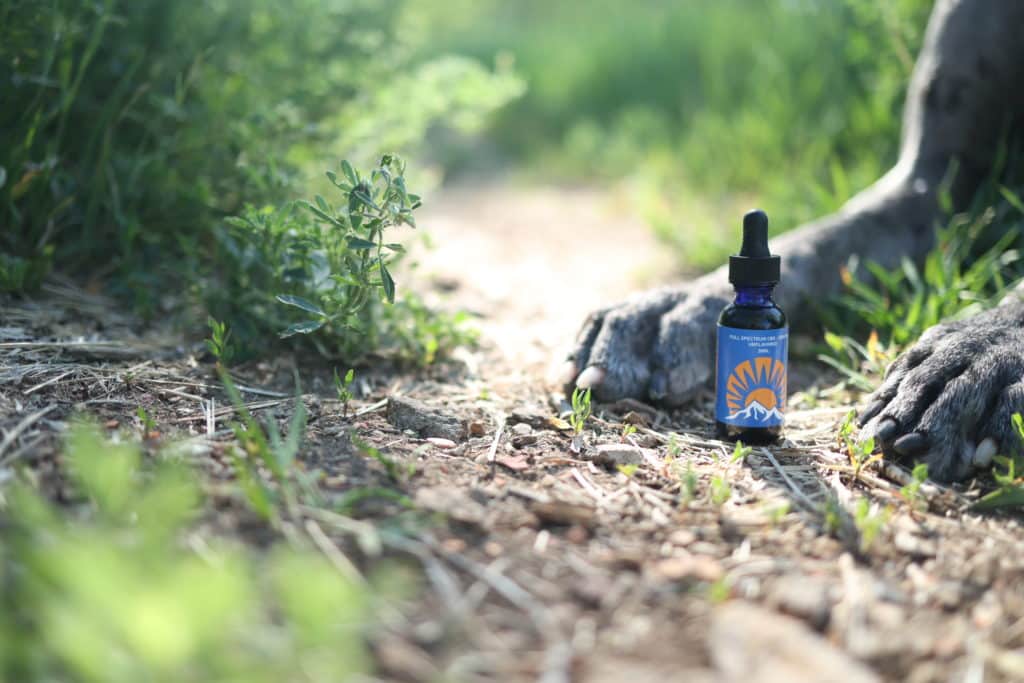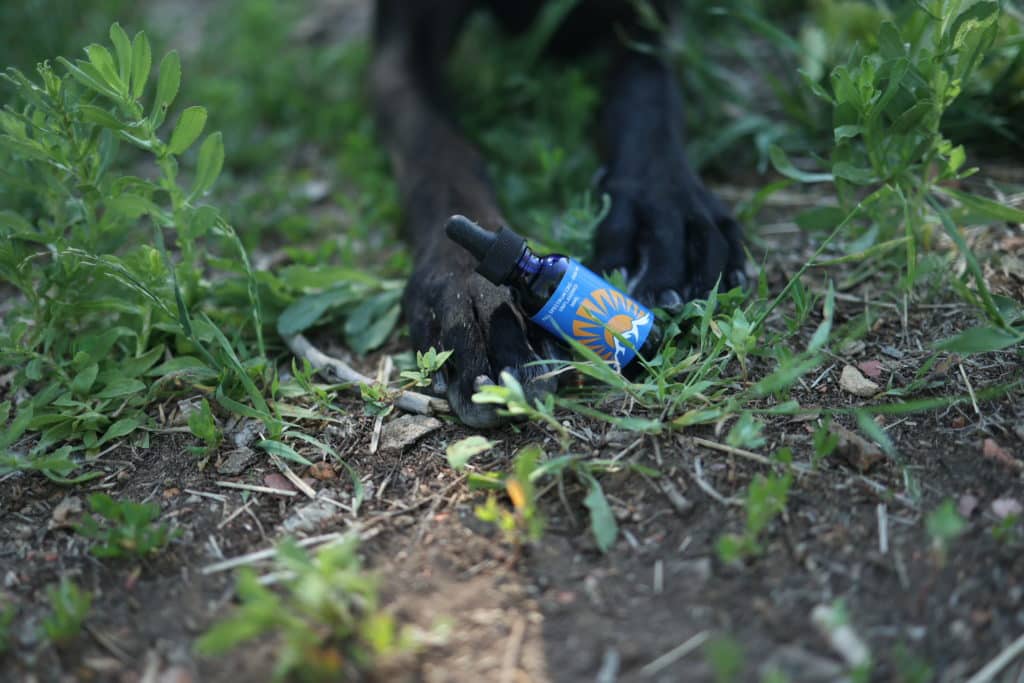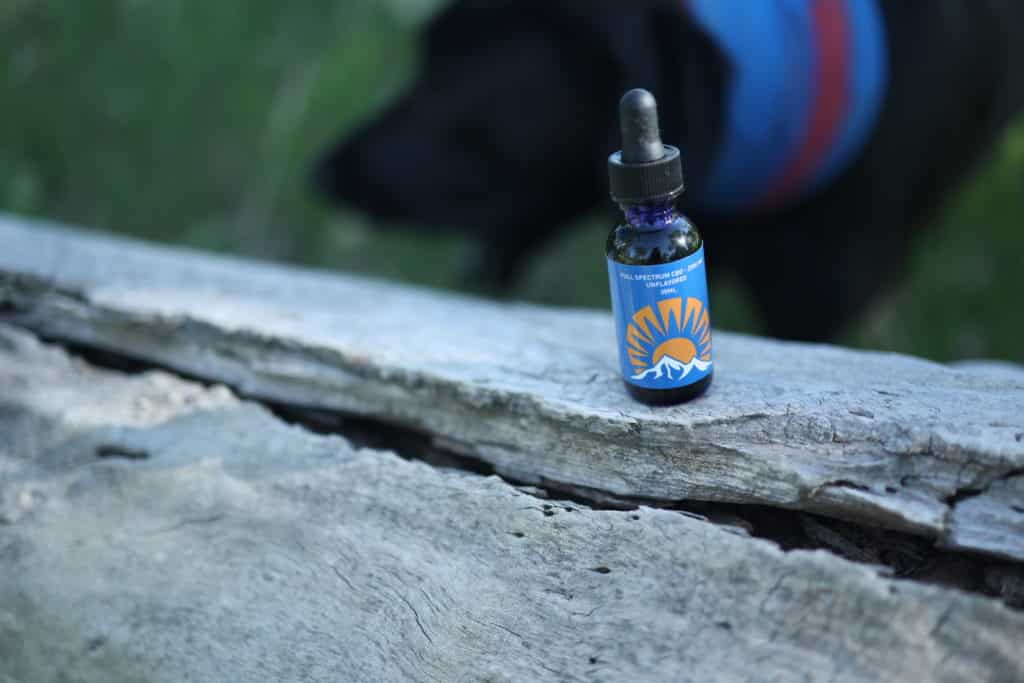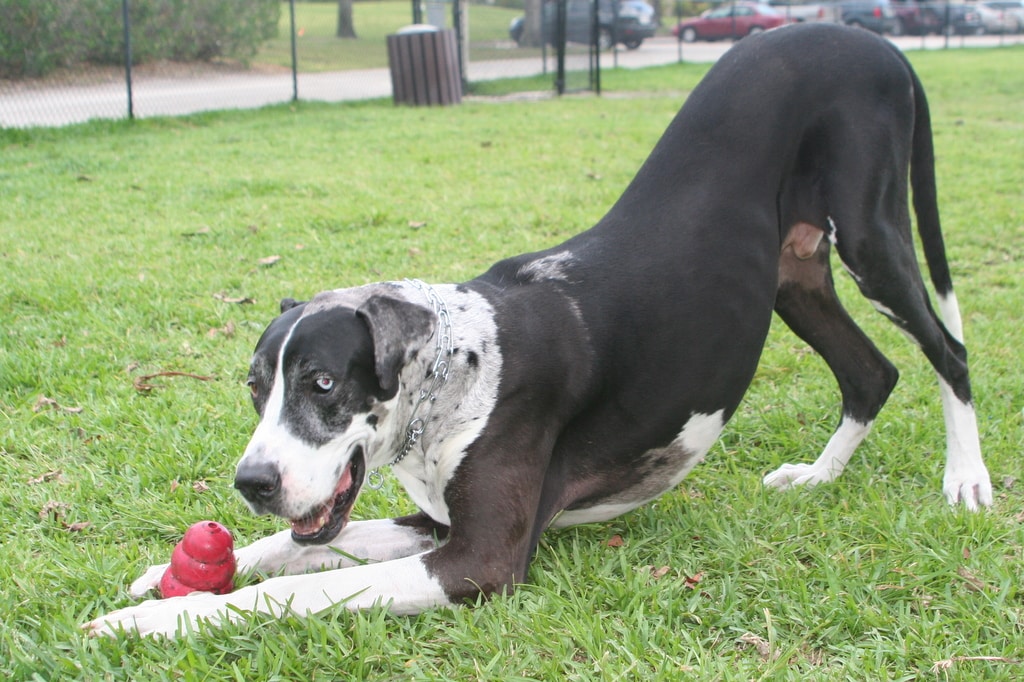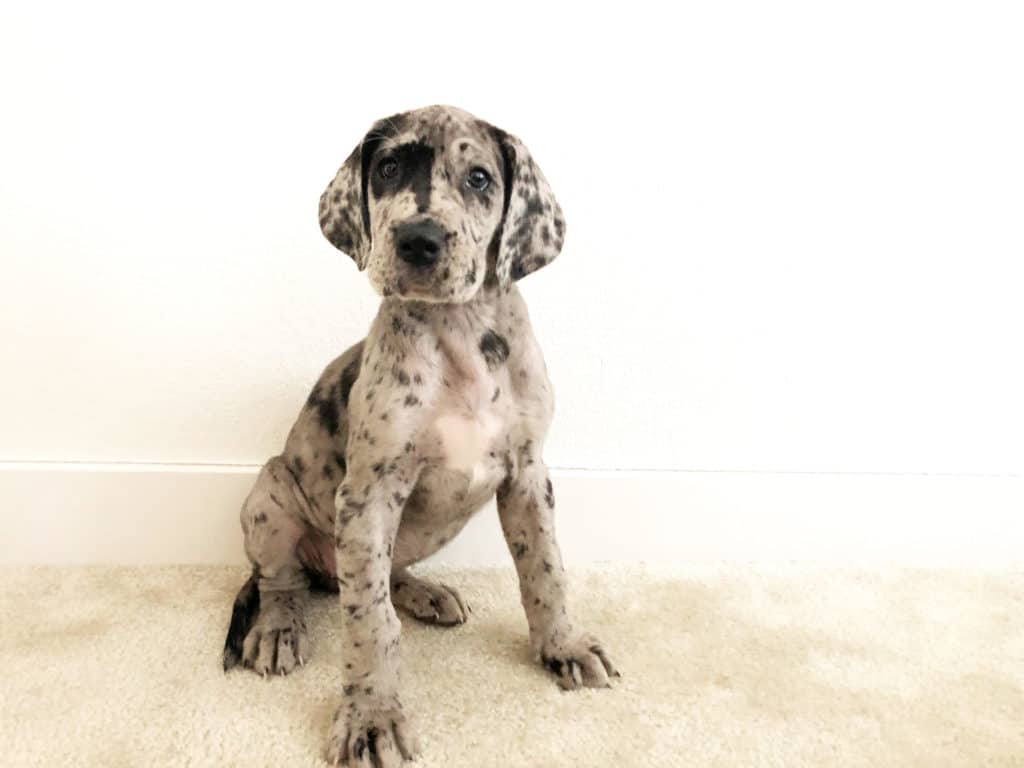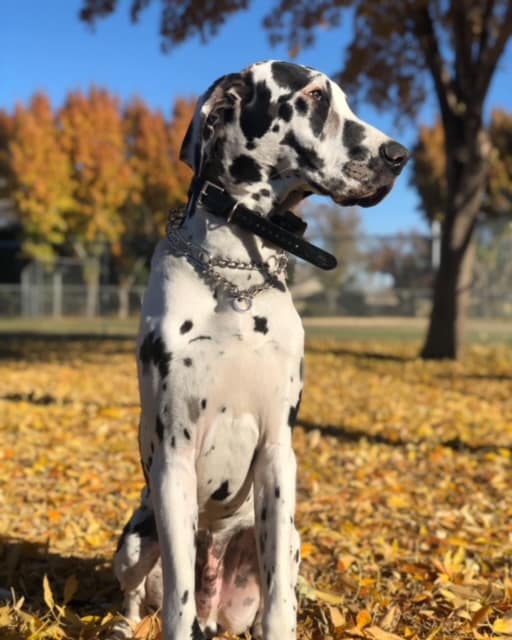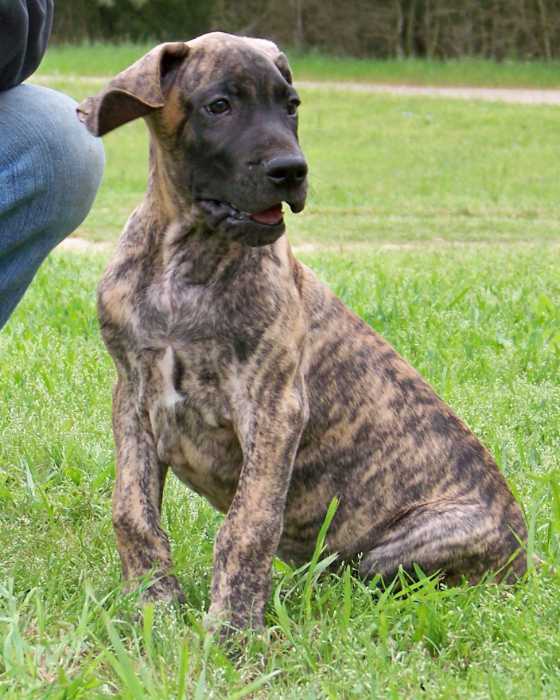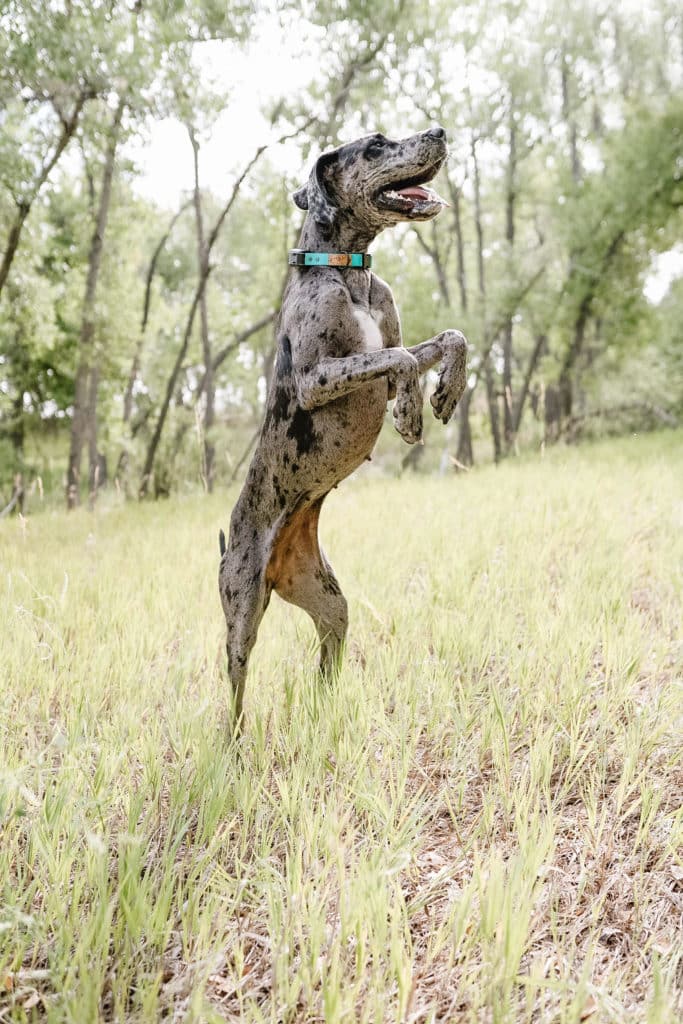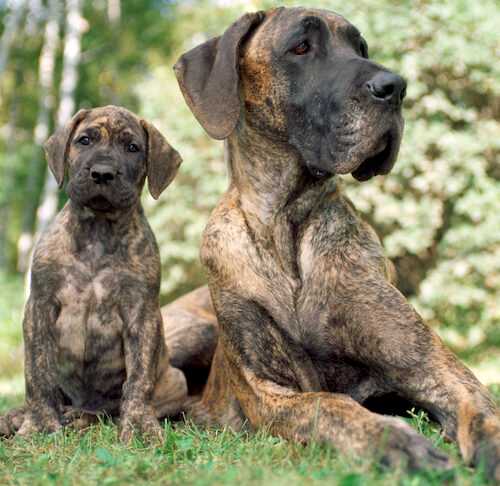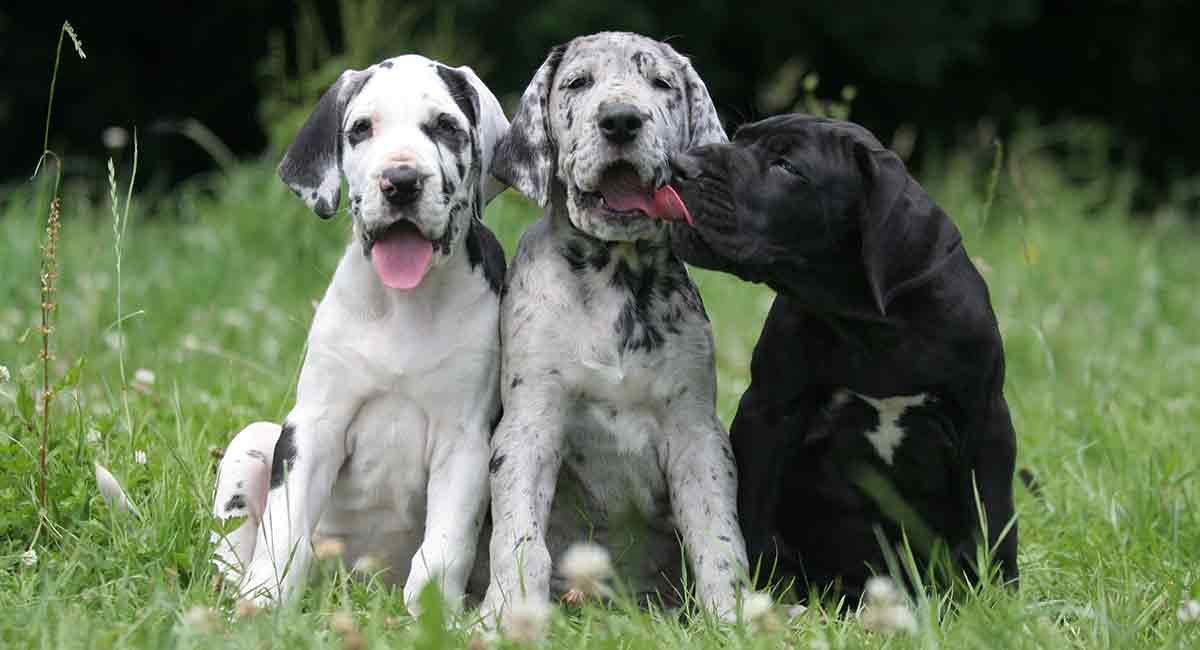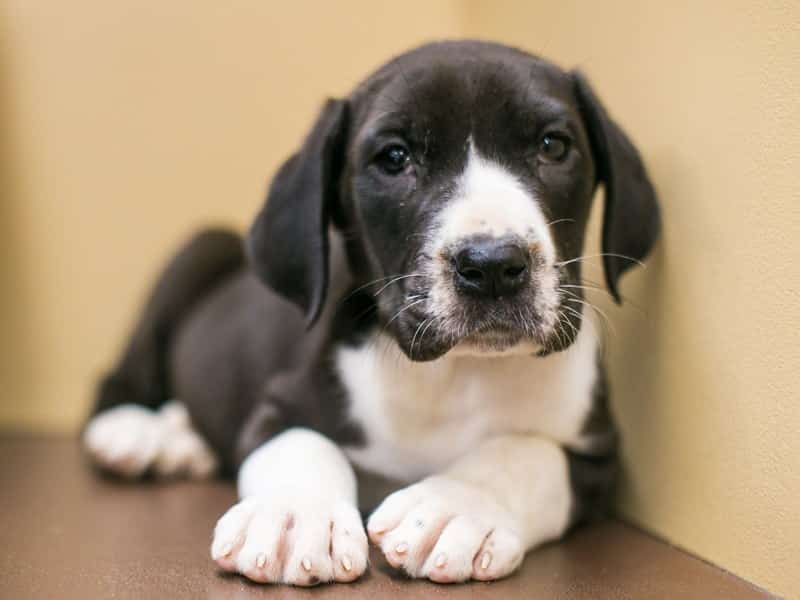The Harlequin Great Dane is not only one of the cutest dog’s in the world, it’s one of the largest too! Popular for being a Gentle Giant, the Harlequin will rock your world.
The colors of Great Danes are:
- Black (Black Great Danes)
- Mantle (Mantle Great Danes)
- Harlequin (Harlequin Great Danes)
- Merle
- Fawn (FAWN GREAT DANES)
- Brindle (BRINDLE GREAT DANES)
- Blue (Blue Great Danes)
Off standard colors include Double Merle Great Danes, which are White Great Danes with predisposed health conditions. Off standard colors that are not approved to be in the show ring are typically bred without health testing. (OFF STANDARD GREAT DANES) Read more about the colors of Great Danes here.

Harlequin Great Danes are one of the most special Great Dane colors. Until you’ve had a Harlequin Great Dane puppy crawling on your lap, you really haven’t even lived!
HARLEQUIN GREAT DANE BREED
Harlequin Great Dane puppies are bred when two Great Dane parents both have the merle gene.
This can happen when two Harlequin Great Danes breed together or a Harlequin Great Dane breeds with a Merle Great Dane.
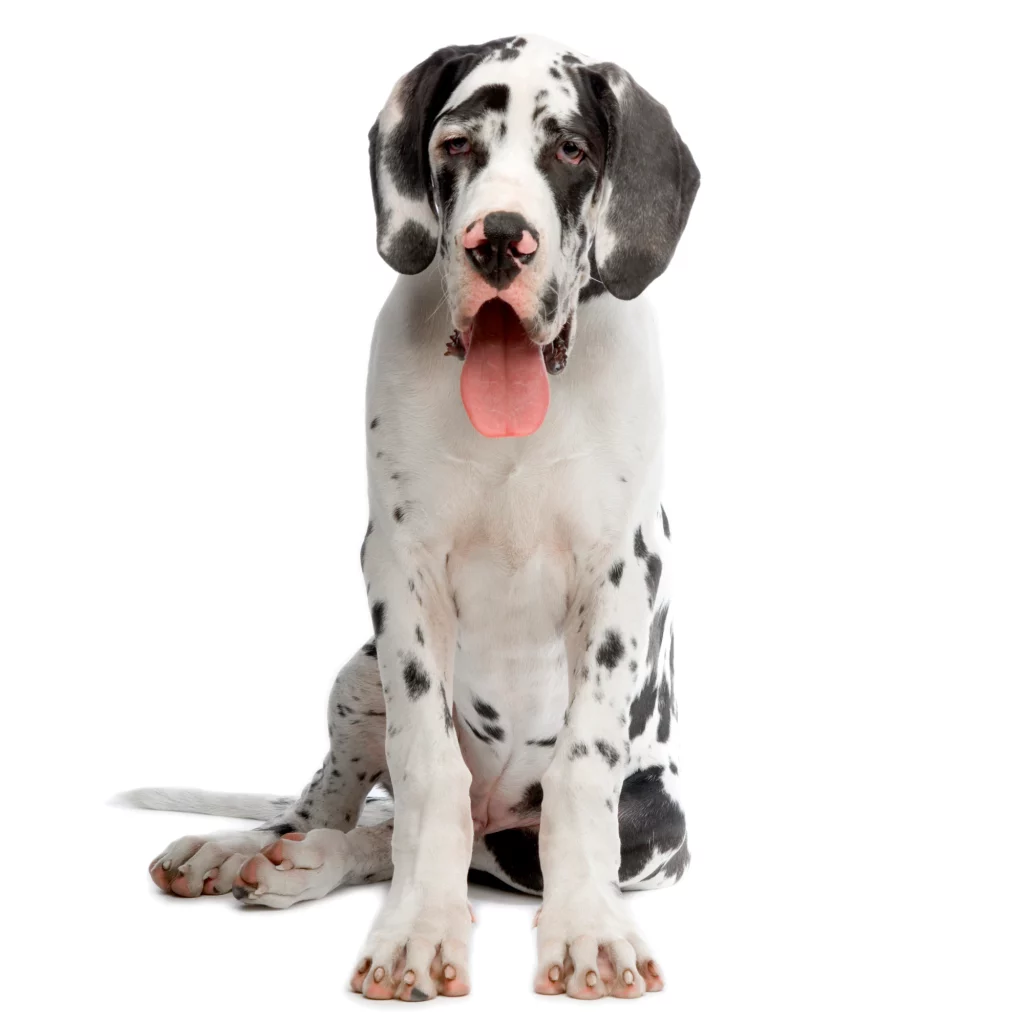
But, believe it or not other Great Danes (Blue, Black, Fawn, Mantle, Brindle) can also produce Harlequin Great Dane puppies, if they carry for the merle gene.
WHAT IS A HARLEQUIN GREAT DANE?
A Harlequin pattern is defined as a solid color with irregular patches of another color.
In the Great Dane world, the Harlequin is defined as a pure white coat with black patches or pale gray patches or both. The gray patches might have somewhat of a merle pattern.
The pattern is not symmetrical and usually has more white than black. The tail tip can be either black or white.
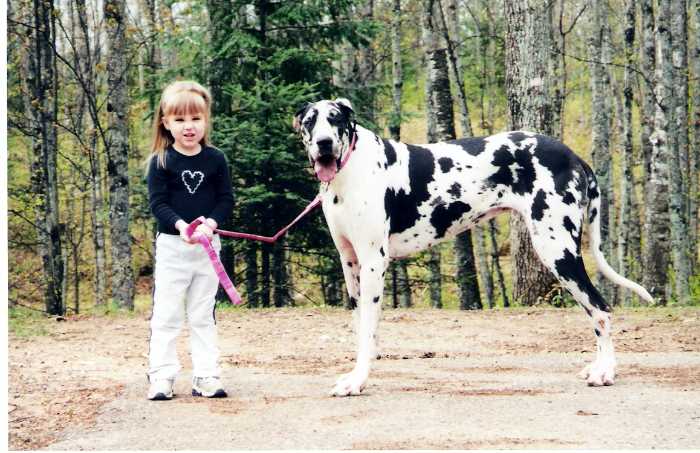
The Harlequin coat can have various Harlequin coat patterns to them. Harlequin coat pattern might have big black torn patches or merle patches.
OTHER GREAT DANE COAT COLORS
The Great Dane Club of America and the AKC recognize 7 Great Dane colors:
- Black
- Blue
- Fawn
- Harlequin
- Mantle
- Merle
- Brindle
The colors Harlequin and Merle are connected because a Harlequin Great Dane must have one Merle parent to produce the desired coloration.
A Harlequin Great Dane dog is considered one of the rarest Great Dane colors because it is so striking and it can be hard to produce a breed standard Harlequin.
Blue Great Danes
Mantle Great Danes
14 Exciting Things about Black Great Danes
Miniature Great Danes: The Pocket Size Version
Colors of Great Danes
Harlequin Great Danes
Brindle Great Danes
Fawn Great Danes
WHAT IS A ‘BREED STANDARD’ HARLEQUIN GREAT DANE?
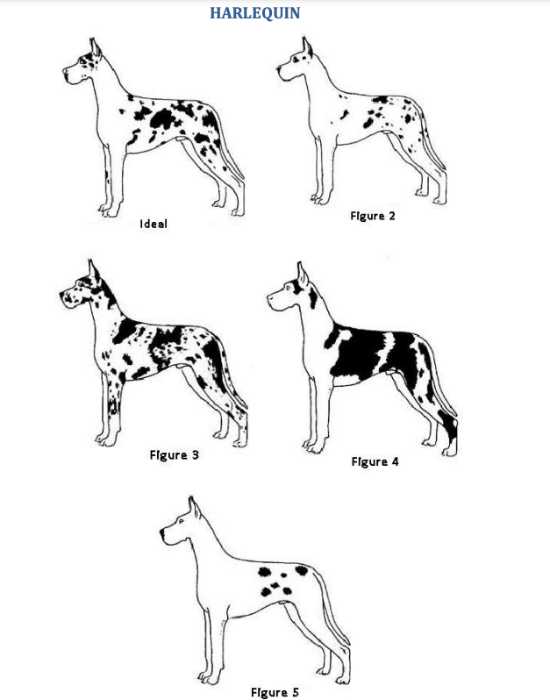
Breed standard is what a Harlequin Great Dane should look like, according to the ‘right’ description.
Although a range of patterns can exist in a Harlequin puppy, there are not supposed to be so few patches that the Harlequin Great Dane is pure white, and so many black patches that the white can not be seen.
When choosing a Harlequin Great Dane, the breeder you choose is so important. Check out our registry for breeders you can trust.
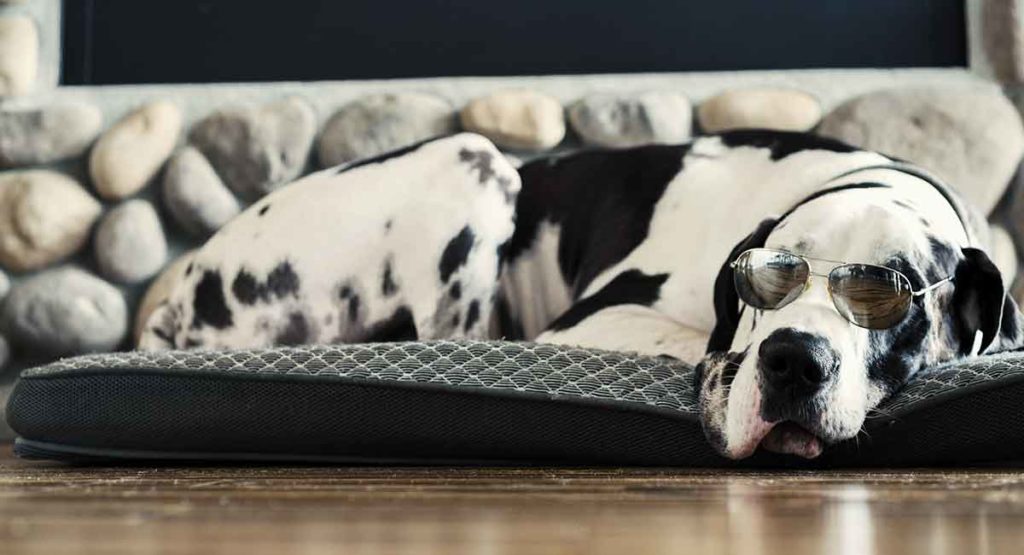
It is also undesireable for a Harlequin Great Dane to have torn black patches, which means the black hairs are not well defined or have white marks within them. Instead, the Harlequin pattern should have solid black patches.
It is preferred that a Harlequin Great Dane has a white neck. It is okay if a Harlequin Great Dane has patches of gray coat.
HARLEQUIN GREAT DANES TEMPERAMENT
For being one of the world’s largest dog breed, Harlequin Great Danes are extremely docile and gentle.
Many people look to get a Great Dane puppy because they are gentle giants, however they do still require serious training.
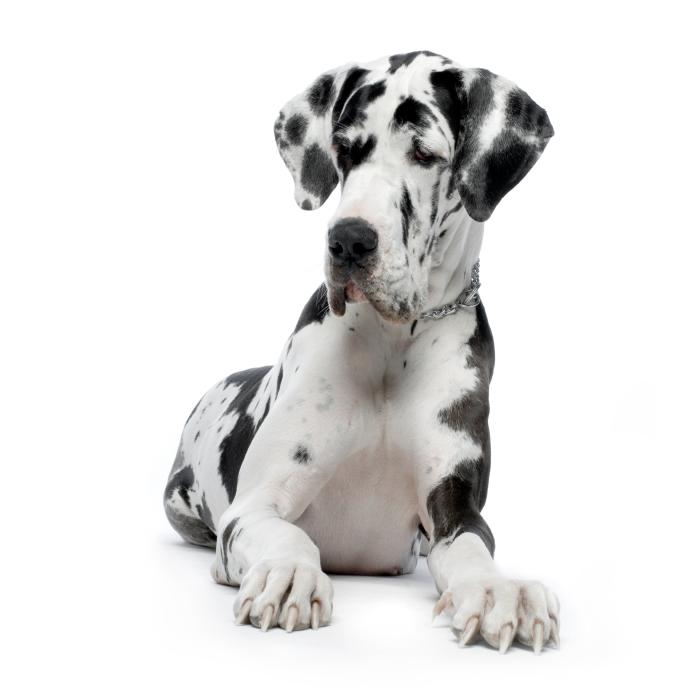

Big dogs are just that- BIG! So, with their size comes a responsibility to make sure that they are trained.
When socialized as puppies, Harlequin dogs are typically a great family pet, great with children and other dogs, can be a bit stubborn (like most dogs), and very easy to fall in love with.
HARLEQUIN GREAT DANE PUPPIES
Harlequin puppies are some of the absolute cutest pups. From their little pink nose and unique coat to their blue eyes- it’s very hard to not fall in love with them.
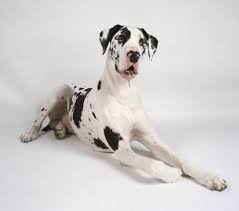
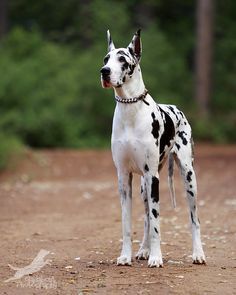
Their harlequin color draws a lot of attention so if you are a first time dog owner be ready for the ‘horse’ comments!
Things you will need for Harlequin puppies:
A Crate– crate training is an absolute must for a Great Dane puppy. Crate training helps to teach your puppy independence and keeps them out of trouble when you are not able to watch them.
HOW TO FIND THE BEST CRATE FOR A GREAT DANE
Food and Water Bowls– get bowls that are big enough for your puppy. If your Harlequin Great Dane puppy is eating too fast, you might want to consider getting them a slow feeder which can help to prevent them from eating too fast (and can create stomach issues and lead to bloat).
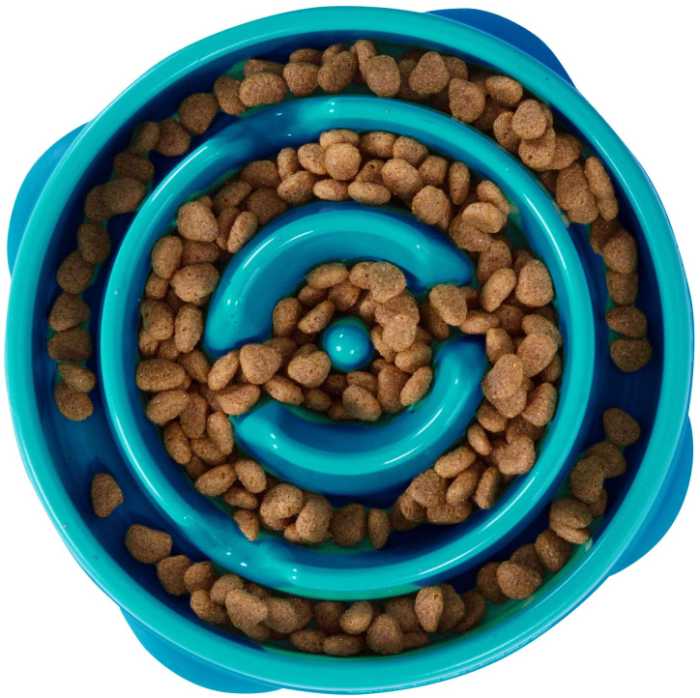
Nail Filing Tools: Keeping your Harlequin Great Danes nails short is one of the biggest things you can do to help their joints stay healthy. It also prevents feet issues when they do not have long nails. You can choose between clippers or a Dremel.
Puppy Food: Great Danes require specific food that is formulated to their giant growth and different than other breeds. Find and commit to a puppy formula that is suitable for your Great Dane.
HARLEQUIN GREAT DANES AND THEIR HEALTH ISSUES
Like all Great Danes, Harlequin Great Danes face health issues that not all other dogs face.
JOINT ISSUES
Harlequin Great Danes are more predisposed to joint disease than smaller dog breeds.
Arthritis, hip dysplasia and elbow dysplasia are all common joint issues in Harlequin Great Danes.
To help prevent these issues, it is important to keep your Harlequin Great Dane at a healthy weight and to not allow them to jump on and off of furniture.
It is also important to keep their nails short so they do not put too much pressure on their joints.
Keep your Great Dane on a high quality joint support, like Dasuquin.
HEART DISEASE
Heart disease is also a common health issue in Harlequin Great Danes.
The most common form of heart disease in Harlequin Great Danes is dilated cardiomyopathy (DCM). DCM is a condition where the heart muscle becomes thin and weakens, causing the heart to not pump efficiently.
Symptoms of DCM can include coughing, exercise intolerance, fainting and an enlarged heart.
To help prevent heart disease in your Harlequin Great Dane, it is important to feed them a high quality diet and to take them to the vet for regular check-ups.
CANCER
Cancer is also a common health issue in Harlequin Great Danes.
The most common type of cancer in Harlequin Great Danes is osteosarcoma, which is a bone cancer. Other types of cancer that Harlequin Great Danes can get include lymphoma, mast cell tumors and hemangiosarcoma.

There is no sure way to prevent cancer in Harlequin Great Danes, but it is important to take them to the vet for regular check-ups and to be aware of any changes in their health.
BLOAT
Bloat is a condition that can occur in all dogs, but is more common in deep chested breeds like the Harlequin Great Dane.
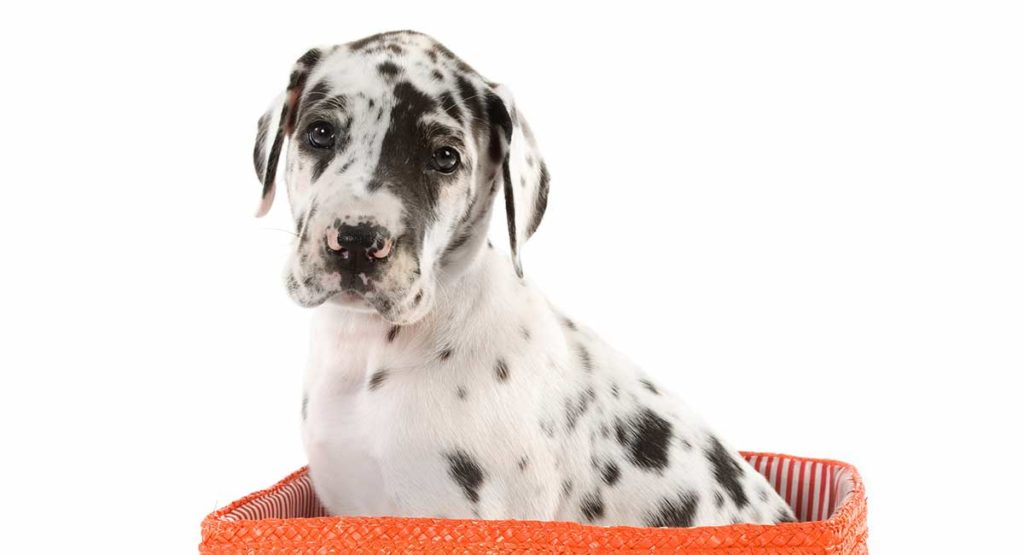
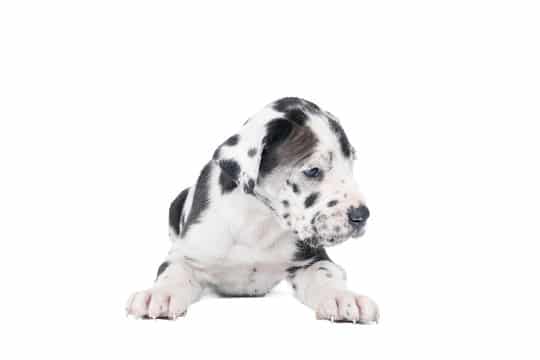
Bloat occurs when the stomach fill with gas and twists, cutting off blood flow to the stomach. Bloat is a medical emergency and can be fatal if not treated immediately.
Symptoms of bloat include a distended abdomen, drooling, restlessness and pacing, panting and an inability to vomit.
If you think your dog is bloated, it is important to take them to the vet immediately.
To help prevent bloat, it is important to feed your Harlequin Great Dane several small meals a day instead of one large meal. You should also prioritize gut health, as gut health is related to bloat.
WHAT IS A DOUBLE MERLE GREAT DANE?
Double Merles are caused when two Harlequin Great Danes, two Merle Great Danes, or one of each (OR any Great Danes that carry the merle gene) are bred together.
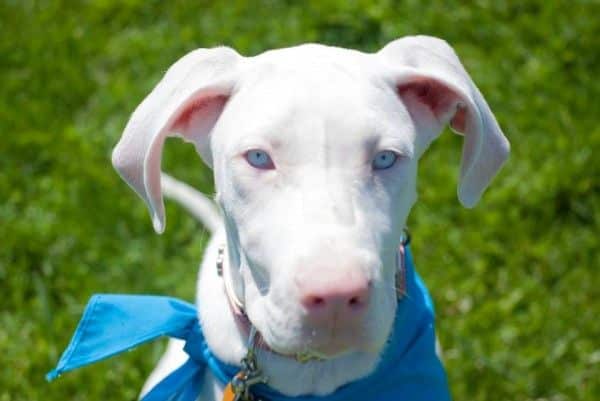
When this breeding takes place, the puppies have a one in four chance of being double merles.
A Double Merle Great Dane is a Great Dane with two of the merle gene- and this can cause serious issues.
The coat color of these dogs is usually solid white and they typically have either both blue eyes or one blue eye. Although standard, healthy Harlequin dogs can have blue eyes at birth, they do not have the same ‘hollow’ blue eyes as a Double Merle. Also, normally a Harlequin will lose its blue eyes as it grows up. However, just because a dog has blue eyes does not mean it is a DM.
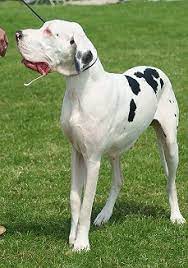
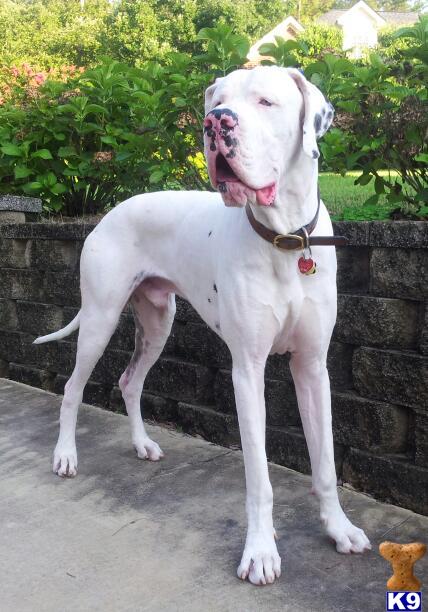
A Double Merle Great Dane is faced with health issues from the bat. They are typically somewhat to completely blind and deaf, face an abundance of sensory issues, are extremely predisposed to cancer, joint issues, bloat and other health concerns and are generally very anxious in temperament.
Any breeder who is breeding together two Harlequin dogs should be stopped immediately as it is of the detriment of these poor dogs.
Most breeders who are ethical and considerate will health test their dogs before breeding any dogs together to ensure that their dog does not carry the merle gene if being bred to a Harlequin or Merle Great Dane.
Unfortunately, many breeders do not care about the dogs being bred and proceed to breed and produce these issues.
HOW MUCH DO HARLEQUIN DOGS COST?
When looking for a Great Dane, cheaper is not always better, but neither is more expensive. Harlequin Great Danes cost anywhere from $500-$3000.
In general, the Harlequin coat color does tend to be one of the more expensive of all of the Great Danes.
The beautiful coat makes many people want them.
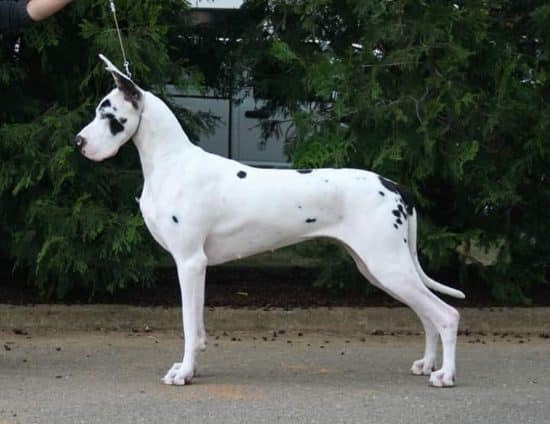
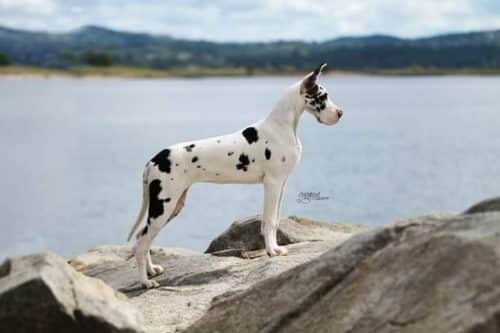
When looking for a Great Dane, do not fall for the following scams:
- If your breeder says that they are ‘AKC’ Dogs. Being apart of the American Kennel Club does not mean you are getting a healthy Great Dane, nor does it mean you should or shouldn’t pay more for the Great Dane. (AKC Papers Are Not Enough)
- If your breeder states you are getting a ‘Blue Harlequin’ or any other odd type of Harlequin gene. This is just a fancy way of stating that your dog is a mixed breed and not a standard Great Dane.
- If your breeder is breeding two dogs together that both have the merle gene. Look for ‘spot to spot’ breeding, but also ask for health tests to confirm. (Double Merle Great Danes)
- If your breeder states that you are getting a ‘Euro’ Great Dane. This is just another way of stating that you are getting a ‘Fat’ Great Dane. (Euro Danes: A Big, Droopy Problem)
Read more about ‘Euro’ Great Danes here.
Instead, look for breeders who:
- Health test their dogs using OFA Health testing. (What is OFA Health Testing?)
- Socialize their dogs and puppies from a young age. (Puppy Culture: A Way to Socialize from the Start)
- Genetically test the coat color of each dog they breed to ensure that they are producing healthy puppies.
- Provide you with lifetime dog support and help.
- Helps you to navigate the new dog world by educating you on what it means to own a Harlequin Dane.
Being a new dog parent can feel overwhelming, but Harlequin Great Danes are some of the best.
Enjoy every moment, your puppy will soon be a dog.
READ MORE:
Is My Great Dane Being Aggressive or Playing?
Great Dane Not Eating – What to Do
Great Dane Farts: The Funniest Collection of Photos and Videos on the Internet
The Best Collars for Great Danes
Blue Great Danes – Facts, Photos, and Care
How to Crate Train a Great Dane Puppy
7 Best Nail Clippers for Great Danes
Find a Breeder
How to Find a Crate
